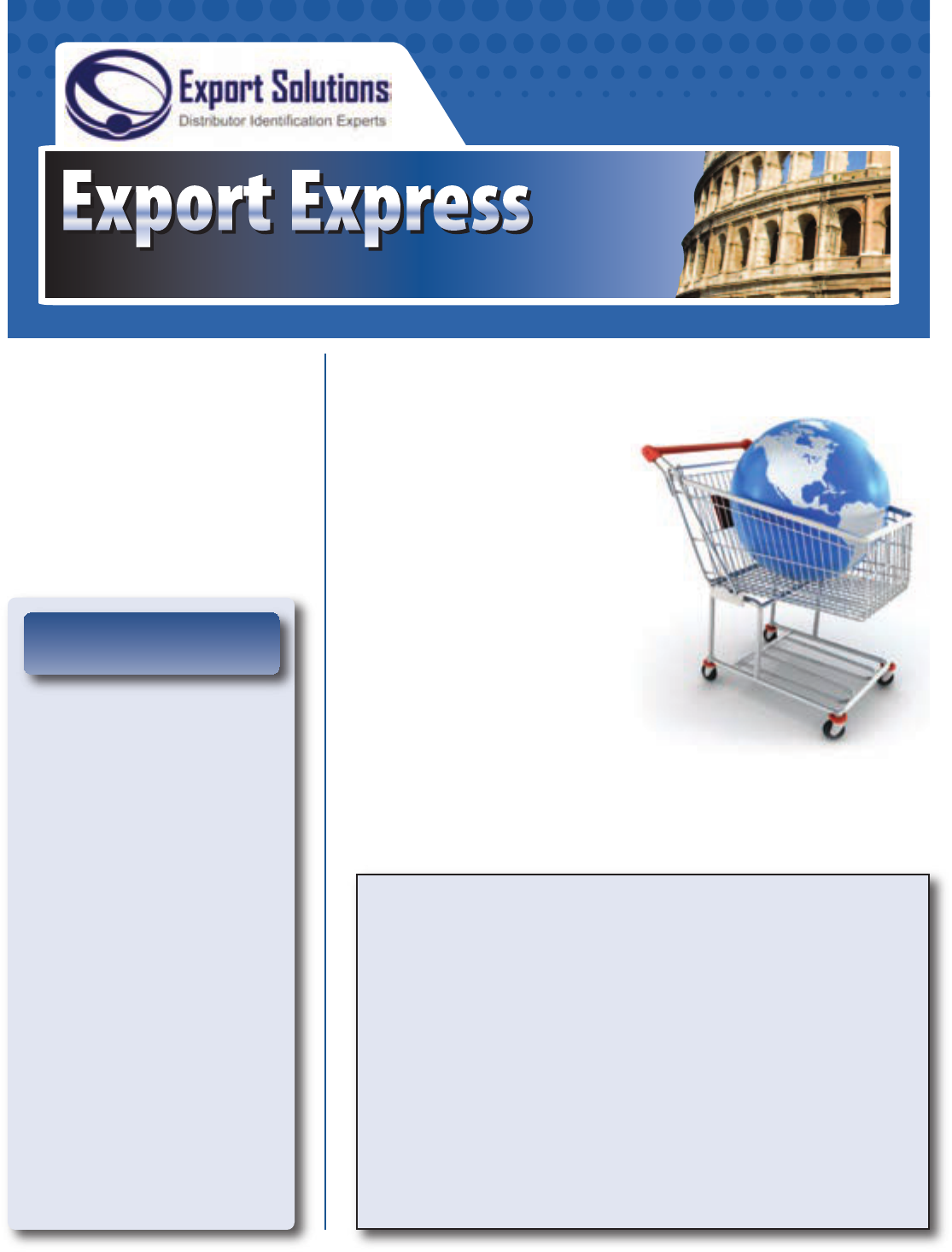
Insights to Accelerate International Expansion
300 Tips for Export Managers
Our Mission: Help Manufacturers “Spend time Selling to Distributors versus Searching for Distributors”
In This Issue
Sell to 96 Countries
Looking for new customers and
distributors in international markets?
Export Solutions’ distributor database
covers more than 9,200 distributors in
96 countries. Our database features
extensive coverage of leading food,
confectionery, and beverage distributors.
New! Export Solutions’ retailer database
now tracks 2,700 retailers in 96 countries.
Order now at www.exportsolutions.com.
One of my favorite Beatles songs
is “We get by with a little help from
our friends.” Export managers build
international businesses through
advice from their network of
colleagues, countrymen, and
distributors. I am grateful for my
export friends that serve as the
inspiration for many of my Export
Express articles.
Export Express has released a “Best
of Ten Tips” compilation resource.
This guide contains more than
300 timeless tips for building your
export business and managing
distributors. More than 400,000
industry professionals have visited
our web site to study our strategies
and suggestions for building brands
in overseas markets. Our reader
feedback suggests that our Ten Tips
columns are appreciated for sharing
practical commercial advice on
common export issues.
Our future success is dependent on
our ability to expand our sales to the
world’s 7.9 billion consumers. Export
Solutions can help!
Greg’s Ten Tips
1. Good news travels fast and bad
news travels slowly
2. If you want to know what’s
really going on, spend a day
visiting stores
3. Pick up the phone and call a friend
or business partner versus email
4. Be positive. Think, “why not?”
5. Results are directly proportionate
to your investment:
Marketing, People, Focus, Time
6. A distributor (or Broker) “respects”
what the Brand owner “inspects”
7. Shipment numbers rarely lie
8. Put it in writing
9. If two people agree on the
principle of a deal, you can usually
work out the financial terms
10. There is more in common with
industry practices across the globe
than differences. Brand owners
everywhere desire more shelf
presence and retailers demand
more discounts. Recognize the
differences, but focus on the
universal requirement for superior
products, marketed at a fair price.
300 Tips for Export Managers
Page 2
How to Win 2022 – Ten Tips
Page 7
How Exporters Build Brands
Page 27
Ten Things That Distributors Like
Page 31
New Country Expansion Prioritization
Page 34
International Expansion –
Shoestring Budget
Page 41
New Product Launch:
Ready, Set, Grow – Ten Tips
Page 43
Ten Tips – Common Export Mistakes
Page 52
Ten Tips – Translating Export Inquiries into
Incremental Sales
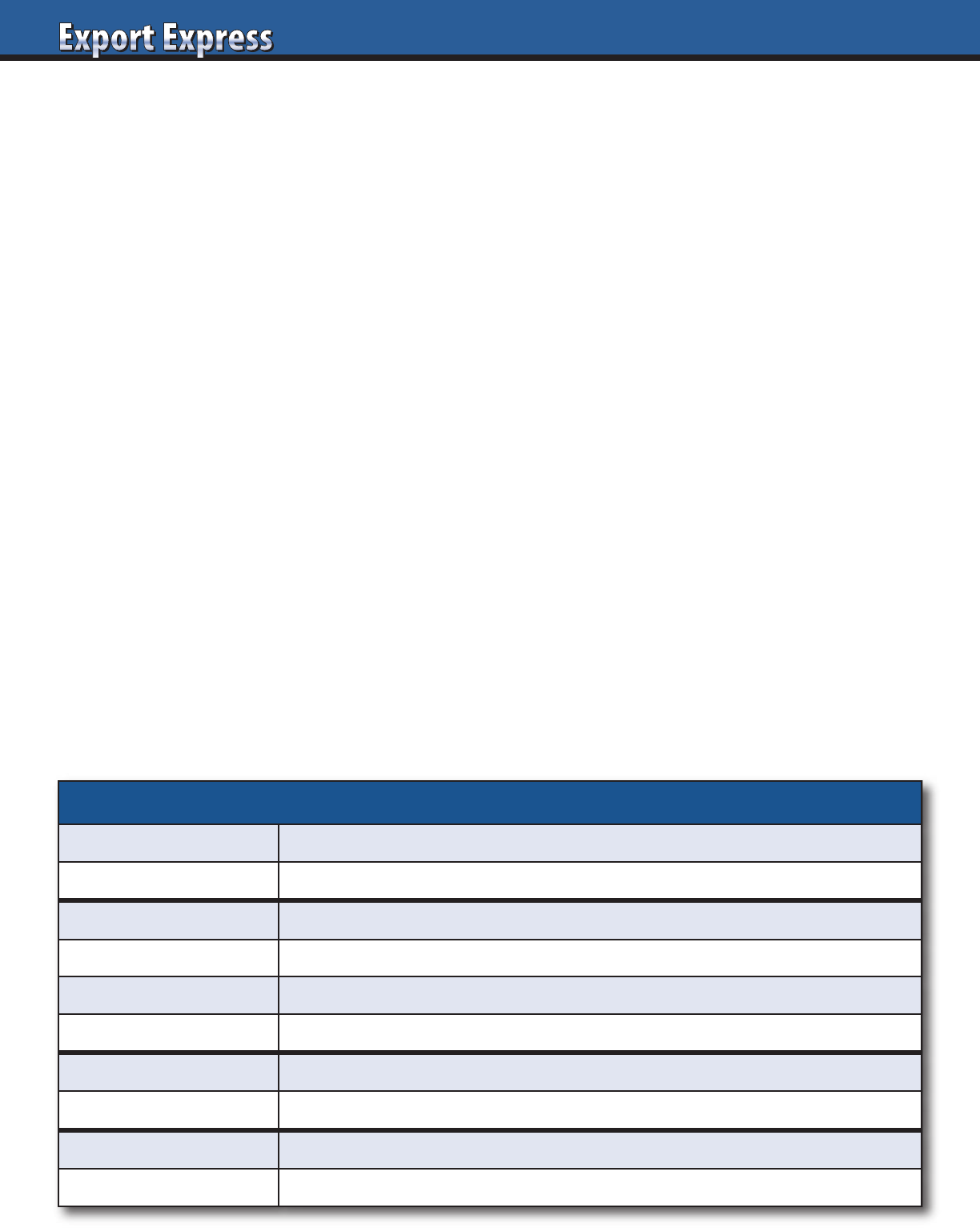
How to Win 2022 – Ten Tips
2
2022 will be challenging and everyone can benefit from “new
ideas.” Listed below are Export Solutions’ 10 strategies to build
your export business in 2022 and beyond.
Focus 5 Countries
A true measure of export success is relevant market share in large
countries like China, USA, Japan, Mexico or Saudi Arabia, not
selling small quantities to 50 or 100 countries. Each international
manager should select his global “Focus 5” countries and strive to
spend at least fifty percent of travel time in core countries. Regional
managers should adapt the same mantra for gamechanging results
at their top one or two opportunity countries.
China Strategy Renewal
Most brands have learned that China is not a country where
you can appoint a national distributor and visit a few times
a year. E-commerce represents most of industry growth and
up to 50% of sales for imported brands. Many companies
appear at a “10 Year Crossroads.” There is an urgent need to
hire “boots on the ground” in China to execute a multi-channel,
multi-region strategy.
Small Shops – Big Opportunity
Small stores represent 50% of sales or more in many emerging
market countries in Asia, Latin America, Middle East, and Africa.
These stores are particularly relevant for impulse categories such
as beverages and confectionery/snack. Small shops are not a
focus for niche brands or start-ups.
E-Commerce
Will e-commerce represent ten percent of sales by 2025?
Twenty percent? Who knows? We can all agree that it will be
bigger. Challenge each distributor to develop an e-commerce
plan. Share learning from your corporate office. Treat Amazon
as another “Global Customer.”
New Channels
My Summer Export Express identified 23 “alternate” channels
that could represent new customers. These channels tend to be
“less demanding” and more open to new brands.
USA – Multi Channel
USA based manufacturers routinely sell to ten channels or more.
Most adopt a matrix model meshing channel specific brokers
for supermarkets and foodservice with direct sales to Walmart,
Costco, and Drug customers. Overseas brand owners should
adopt the same approach to reach all USA channels and regions.
Listing Map
An up-to-date listing map and “white space” plan is the essential
one-page template for every country.
Is the Store a 10?
Can 2022 be the year for focus on improved in-store brand
presence? Brands (& distributors) own the tools and knowledge
to reach these objectives. The critical element is your focus and
execution of a formal shelf drive. Contact us if we can help.
Upgrade Distributor Network
Every company has distributors that are “under-achievers” or that are
no longer a good fit with the brands aspirations. Begin the “upgrade”
process early in the year to impact second half 2022 shipments.
Export Team
How can you redefine roles and responsibilities to obtain more
productivity from your export team? One idea is to appoint one
manager to focus on new country pioneering for a large country
as a special project or “stretch” assignment. Another concept is to
place a junior “company missionary” in a key distributor’s office
for a one year training assignment.Contact Export Solutions for
“new ideas to solve old problems.”
2022 Winning Strategies
Geographic • Focus 5 Countries
• China Strategy Renewal
Channel • Small shops
• E Commerce
• Alternate Channels
• USA-Multi Channel
Sales Execution • Listing Map
• Is the Store a 10?
Organization • Upgrade Distributors
• Export Team

3
Every international manager spends
hours preparing senior management
presentations. What happens when you
get called to see the CEO “right away”
or you see him in the elevator coming
back from lunch? The obvious question
is “how is it going?” Export Solutions
shares our 10 tips to “impress the boss.”
Shipments vs. Annual Budget
The CEO has the corporate number
to hit and wants to know if you will
achieve your fair share. Orders are nice,
but shipments translate to revenue.
Measure progress versus time elapsed
and compare versus similar time period
last year. Publicly traded companies are
concerned with quarterly metrics, while
privately held businesses may focus on
total year budgets. Be specific, be
accurate, and do not appear overly
optimistic. Discuss shipment
performance first before you raise
points regarding market dynamics.
Remedial Plan
Some exporters are blessed with
healthy businesses, tracking ahead
of pace. Most of us will land right
on target. A few are struggling.
Shortfalls happen for a hundred
reasons including currency
fluctuations, competitive activity, and
reduced investment. The key is to have
your remedial plan ready. Do not be
afraid to ask for more spending if you
need help. If management refuses, at
least you have tried to correct the gap
versus expectations.
Core Countries
Focus your update on the top five
countries that drive your business.
This sounds obvious but I have
personally listened to many
enthusiastic success stories about
Latvia, Malta, and Bahamas. Good
news, but the chief wants to know
what is happening in focus countries.
Risk to Plan
CEO’s assessment by the board
depends on accurate guidance on
current performance as well as long
range outlook. Smart executives can
read shipment reports, but want to
identify potential risks to the plan.
Surprises are tough to digest.
Transparency on challenges as
well as upside is appreciated.
What’s Working? What’s Not?
Many companies export to 20, 50, 100
countries or more. Results include a
mix of top performers and laggards.
I endorse the practice of sending a
mid-year, one-page report card to
each distributor. Include a request
for feedback on “what’s working and
what’s not.” Share key findings with
your manager and CEO.
How Can We Double the Business
in Three Years?
The CEO wants your opinion on
accelerated growth options. Leaders
are not content with 5 percent
increases. Doubling the business
may include acquisitions of overseas
category players or construction of
offshore factories. Think big!
Required Investments and Resources
Historically, export is starved for
resources. Which comes first: sales
or investment? Lay out your priorities
for the executive team.Validate export
rationale for more headcount.
Test Updates
Every company should be seeking
new ways to solve old problems.
Update management on new initiatives.
Share positive news as well as tests
that provided learning, but results
behind expectations.
How is the Team?
Export development is a team sport.
Caring CEOs will want to learn how
your group is doing, particularly
in offshore locations. Share your
organizational development plan,
training activities, succession
planning, and status of new hires.
How Can She (or He) Help?
Most CEOs are supportive and
genuinely interested in helping.
Business in the home country may
be mature and international always
provides a pathway to higher growth.
Create your short “wish list.” Invite the
boss to visit your markets or call a key
distributor. Ask for support for your
“pet” project. Always keep your
immediate manager in the loop!
CEO Update: 10 Tips to Impress the Boss
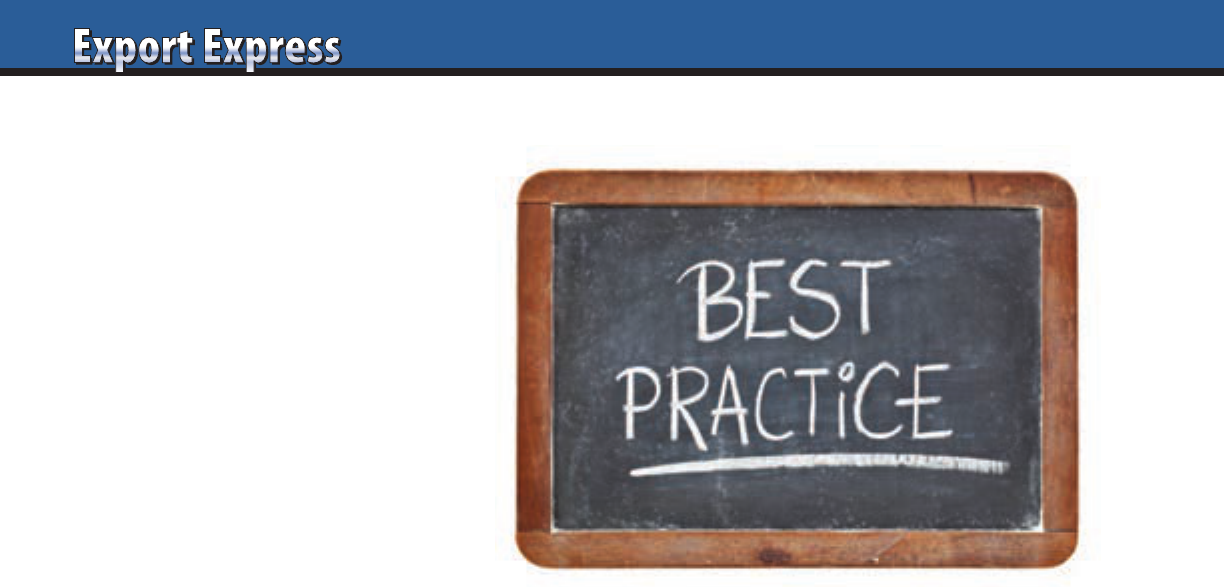
4
Many supermarkets offer sections
dedicated to products from foreign
countries. The “Homesick” shelf allocates
one meter, mini departments, represented
by iconic niche brands from the USA,
Germany, Italy, UK, Brazil, or Mexico.
Despondent expatriates rush to this
section hoping to find their favorite
candy or “sauce” brand from back home.
Often, this represents a “foot in the door”
and a starting place for your business
development. However, most brands
soon become frustrated with this remote
shelf location and plot strategies to enter
the main fixture to compete side by side
versus local competitors. Read Export
Solutions Ten Tips to gravitate from
“Homesick Shelf to Category Captain.”
1. Analyze the Data
Government census data (and embassies)
can reveal the number of your citizens
in a foreign country. For example, in the
USA there are many Italians and Brits in
New York, Germans in Pennsylvania and
Mexicans in California. Tourism statistics
also supply guidance where to find your
current customer base overseas. Current
sales per capita figures indicate countries
where your brand has traction beyond
your core expatriate base. This analysis
provides you with the first clues on
where to focus your investments.
2. Research Local Preferences
A food scientist or market research
company could study local food
preferences and your product portfolio.
Are there options to incorporate your
brand into traditional recipes? Consider
adapting your core product line to meet
local flavor preferences. Pringles built
exceptional sales and excitement by
launching innovative new flavors such as
Jalapeno, Curry, Grilled Shrimp, Ketchup,
and Pizza.
3. Test “Higher Spend” Marketing Plan
Everyone knows the fundamentals of
brand building: sampling, billboards,
radio, and social media. Usually,
exporters may be hesitant to invest in
advance of sales. However, it may be
“low risk” to pick one small-medium
size country to test a targeted marketing
support plan.
4. Hire a Local Manager
It’s tougher and tougher to manage
exports via remote control from company
headquarters. Smart exporters are
opening offices in regional centers like
Shanghai and Dubai for placement close
to the action. You have a choice to send a
missionary from company headquarters
or a local hire who understands the
language, market, and how to get things
done at store level.
5. Focus on Upscale Supermarkets
Identify the “upscale” supermarket chain
in a country. Their consumer base is likely
more adventurous and boasts higher
purchasing power. Invest to be a category
leader at these high profile customers.
Often, middle income supermarkets look
to these upscale chains for assortment
inspiration. In the USA, think of HEB and
Whole Foods first, not Walmart. In the
UK, look to Waitrose vs. Morrison’s. The
same analogy applies to every market.
6. Manufacture in Country
Eliminating overseas freight charges and
duties may allow you to compete more
effectively on a price basis. Labeling in
the local language may be a plus. A small
factory also establishes you as a member
of the community with employees that
will create goodwill. A manufacturing
site may be complex and expensive, but
co-packers may represent another option.
7. Move to a Bigger Distributor
Frequently, a new brand will align with
a small distributor consolidating brands
from one country. This is a logical and
viable strategy to get started. However,
I’ve witnessed countless cases where the
brand’s aspirations and requirements
outstrip the capabilities of the small
distributor. Brands may consider moving
to a more powerful distributor, with
deeper brand building capabilities.
Warning: be prepared to invest more
with a big distributor or you risk losing
ground as unsupported brands may
get lost in the mix. Export Solutions’
database tracks an average of 85
distributors per country.
8. Sponsor a Sports Team or Charity
Fans everywhere love their teams.
Alignment and support of a local
sports team yields dividends. Pick a
charity that contains a meaningful link
to your product or target consumer.
Many supermarket chains have a
favorite charity providing a route to
collaborate with a trading partner for
a worthwhile cause.
9. Bring Your Team
Retailers are desperate for fact based
consumer insights. Bring your research
and technical experts from headquarters
to visit overseas retailers and distributors.
Let them “wow” them with their category
knowledge. Note: you may need to coach
your experts on appropriate messages as
sometimes foreign buyers don’t care how
you operate in Chicago or London.
10. Create an Anniversary Event
Many brands have been available
in foreign markets for 10, 20, 30 years
or more. Why not design an anniversary
event commemorating “25 years in the
______ Market.” Elements could include
special packages, consumer contest,
public relations, charitable donations,
and a celebratory dinner for your
retail customers.
Ten Tips: From Homesick Shelf to Category Captains
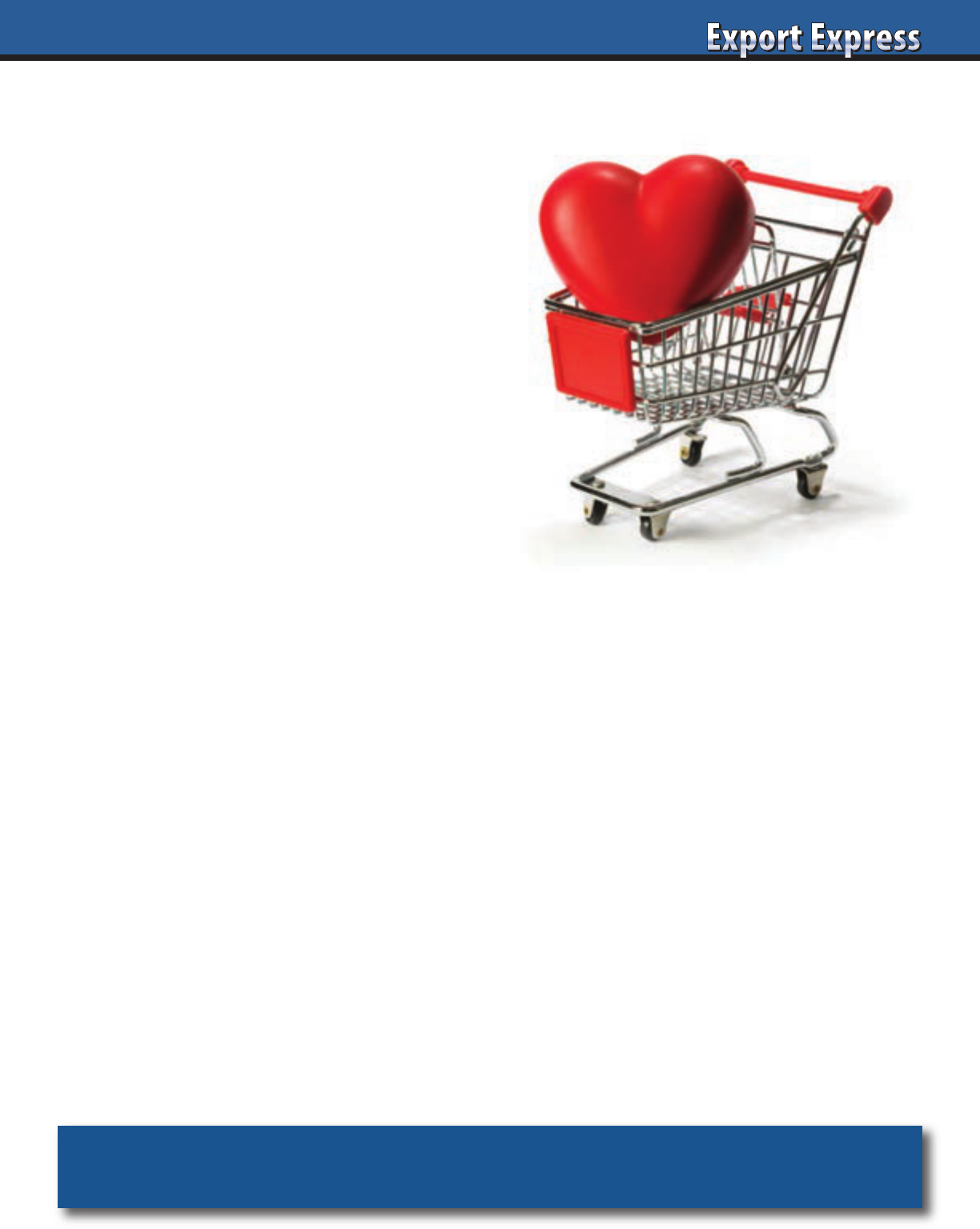
5
The classic industry question is: “How do you maintain
distributor focus on your company priorities once you leave the
market?” There is no easy answer, but a solution is to encourage
a distributor to “fall in love” with your brand and company.
Falling in love is based upon an attraction to a person and
enjoyment of spending time with them. The same feelings can
apply to a brand. I regularly witness super human efforts by
distributors for small and medium sized brands just because
of “Brand Love.” Listed below are Ten Tips to romance your
distributors to superior results.
1. Master Chef Endorsement
The first step is convince the distributor team to be passionate
consumers of your product and enthusiastic brand ambassadors.
For food products, invite all of the group to lunch at a popular
local restaurant. Pay a well-known chef to prepare a meal
featuring your products. Or cook lunch for them yourself.
For candy and snack brands, provide samples to share with
the distributor’s children’s sports clubs. Provide frequent
and generous samples to all of the distributor team.
2. Fun Sales Meetings
Every distributor has sales meetings for their entire company.
These are usually a repetitive drone of Powerpoint slides. Why
not hire an agency to create a fun presentation module which may
include audience participation, games, or costumes? Or sponsor
a local motivational speaker or training workshop using your
products as the case studies. Break the mold of boring meetings!
3. Provide Great Customer Service
Respond to requests quickly. Ship complete containers to keep
the pipeline filled. Pay all bill-backs promptly.
4. Distributor Awards
Recognize your high performing distributors with an award.
This could be Distributor of the Year or for $1 million in sales
or for 15 years of partnership. Some companies sponsor smaller
awards for key account manager of the year in each market and
retail representative of the year. Publicize the event by awarding
a plaque, hold an awards luncheon, take photos and share a press
release of the celebration.
5. VIP Visit to Corporate Headquarters
Treat your distributors as VIPs at your corporate office. This
trip creates a memorable bonding experience and a chance for
you to serve as a good host. Take the distributor to a product
development lab and organize a meal with your CEO or
executive officers. Make him feel like part of the family.
6. Support Local Events and Charities
Creative distributors drive incremental sales through local
marketing events. Display a willingness to support their ideas
and invest in new programs. Events that sync with the
distributors (or retailers) special charity build substantial
goodwill and appreciation.
7. Annual Incentive Trip
Many companies sponsor trips for distributor executives who
attain their annual sales quota. Mid-size brands source added
focus by sharing the benefits of a good year by inviting achievers
(and spouses?) to trips in resort locations like Hawaii or
international cities such as Rome. Everyone works hard
to qualify and vow to return “year after year.”
8. Holiday Baskets
Send baskets or gift packs to distributor employees that include
your product and other adjacent holiday items. The idea is to
extend your brand’s relationship to your partner’s homes.
9. Distributor Advisory Council
Form a small elite group of distributors to advise your company
on international development. Meet twice a year with access
to your companies senior management. All members of the
Distributor Advisory Council will meet their sales target.
10. Treat Distributors as Your Best Customers
Be nice. Say “thank you” frequently. Send handwritten notes to
people to recognize a nice display or a fixed problem. Have fun
while you work.
Distributors may work with twenty brands or more, each
shouting for attention. Distributors support all their brands, but
there is no magic science to allocate time equally. Naturally, we
all spend more time and effort for the brands and people we like.
What can you do to make your distributors “Fall in Love?”
Ten Tips – Getting a Distributor to Love Your Brand
Need more information? Visit www.exportsolutions.com.
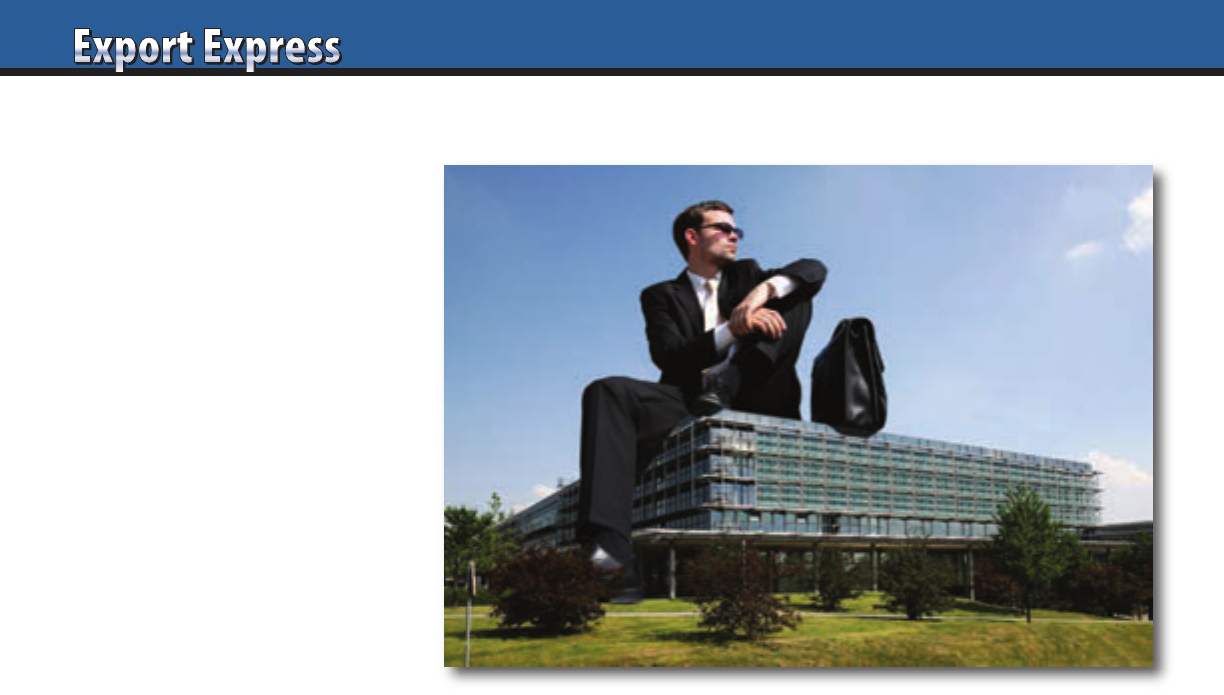
6
Exporters envy the massive clout
and impressive results generated by
multinationals such as Nestle & Procter
and Gamble. These powerful brand
builders succeed in emerging markets
by adhering to a well defined new
business development process. Their
approach represents an ideal mix of
global category knowledge with local
execution. Recapped below are key
elements on how multinationals win
in international markets.
Market Research
Multinationals invest in both qualitative
research and syndicated data. Significant
effort is directed to understand local
consumer behavior, shopper insights,
and attitudes to new product concepts.
This information is paired with
syndicated data from providers such as
Nielsen and Euromonitor. This allows
companies to study trends and calibrate
the “size of the prize.”
Innovation & Adaptation
New product ideas sweep the globe
these days. There are too many “me too”
products, offering little differentiation
to global buyers. Multinationals dedicate
technical resources to identify the “next
big thing.” Their point of difference is the
ability to adapt these big ideas to local
tastes and habits. This may be achieved
through a unique marketing approach,
adjustment of a flavor profile, or a distinct
package appropriate for a local market.
Local Production
Manufacturing facilities close to
your consumers supply a tremendous
competitive advantage. Direct benefits are
sourced from the elimination of overseas
logistics costs and duties. This translates
to lower shelf prices and more money to
invest in marketing or higher gross
margins. A plant is usually associated
with scale and creation of a local
subsidiary. These employees and their
families become “brand ambassadors” for
the companies where they work. A factory
presence creates spending and pride in a
community. Factories may be expensive,
but co-packing may be another option.
Close to the Customer
Multinationals typically enjoy special
customer “intimacy.” Their critical mass
and importance to the retailer create
more of a balanced relationship and
partnership. The multinationals local
management may be empowered to make
decisions quickly without needing to
check with an overseas office.
Multifunctional Team Support
All commercial teams have sales people,
but multinationals may offer “on the
ground” customer support in other
critical functions. This includes product
supply, financial, marketing, information
technology, and customer service. It takes
a professional “team” to win in our
business, not just a “super salesman.”
Marketing Investment
Large companies maintain the resources
to invest in consumer marketing and
trade support programs. All brands
allocate dollars to these activities, but
multinationals fund their launches to
include television advertising, social
media and consumer sampling. They
entice retailers with large discounts
and rebates in return for impactful
shelf visibility and massive end of
aisle displays.
Competitive Pricing
Multinationals’ scale allows them to
offer competitive pricing in a market.
Frequently, their pricing strategy for
a new brand will include a structure
at parity versus current players or even
at a savings. This creates a measurable
advantage versus brands entering with
“super premium” pricing and little
marketing support.
Category Expertise
Multinationals frequently serve as
“Category Captains” yielding benefits
and respect from retailers. They are
viewed as important sources of
category trends,insights, and analysis.
A multinational brings knowledge from
adjacent categories or markets that can
be applied to a new product launch.
Think Big
New product launches from multinationals
contain high expectations, focus, and
support levels. Typically, these initiatives
are aimed at creating new brands with
sales measured in the millions. New
product launch plans feature three year
sales targets and investments. Normally,
these brands lose money in year 1, break
even in year 2, and budget positive cash
flow for years 3 and beyond.
Glocal Strategy
International marketers win with
a “Glocal” approach. This involves
leveraging “global” category expertise
and resources and adopting it to a “local”
market. Multinationals win because they
offer critical mass in the country of their
corporate headquarters, as well as
international countries.
How Multinationals Build Brands
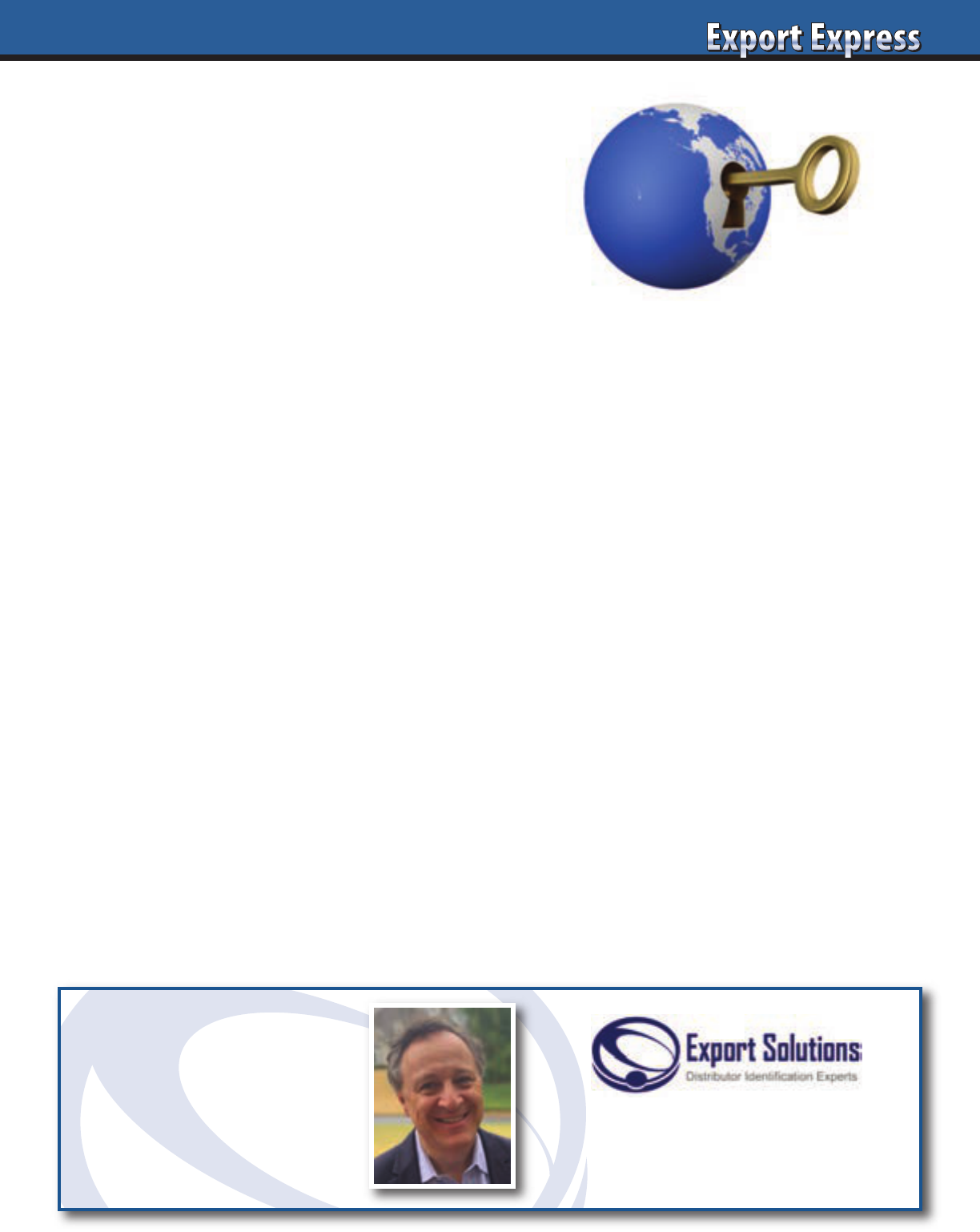
1. World Cuisine
Foreign travel and exposure to world cuisine has sparked an
appreciation of food and confectionery products from around
the globe. Today’s consumers enjoy diverse food choices as
they plan their weekly menus. Asians may consider American
or UK brands as ethnic food, just as we consider Thai or Mexican
cuisine as “international.” Successful exporters focus on
traditional products and favorite brands from their home country
that may be considered to unique to citizens of other nations.
What is your products USP (unique selling proposition)?
2. Visit Each Country
Export managers should visit each country at least once. It’s easy
to capture the pulse of a market by visiting stores and meeting
with distributor candidates. Winning requires the combination
of your brand and category expertise matched with your
distributor’s mastery of local industry practices.
3. Complete Homework
Veteran exporters complete fundamental research on category
conditions prior to market entry. This includes size of the
category, competing brands, pricing, and merchandising
standards. Careful consideration should be applied to what
added value your brand contributes to the existing category
dynamics in a new market.
4. Choose the Right Distributor
Selecting the right partner is the third most critical success factor
after creating a meaningful USP and commitment to invest in
brand building activities. Finding the distributor that is a right
fit is a difficult task. Most brands prefer to align with a category
specialist (i.e., confectionery distributor) or a distributor that
specializes in brands from your home country. In every case, look
for a distributor that is passionate about your brand and offers
sufficient scale to achieve your business objectives.
5. Crawl, Walk, Run
Export is not easy and new business development always takes
longer than the optimistic dates we place in our timeline. Start
with listings at upscale supermarkets and global retailers. Create
a success story at a few high profile retailers versus trying to sell
to all accounts during year one.
6. Results: Proportional to Your Investment
Every country maintains a universal requirement to invest in
consumer and trade marketing activities. How much does it cost
to secure shelf presence and merchandising support at the
leading supermarket chain in your home country? Why should it
be any less expensive to enter a foreign country where your
brand is unknown? Your investment level signals to distributors
and retailers your commitment to the market.
7. Premium Pricing
International brands may command as much as a fifty percent
price premium versus local products. Savvy consumers recognize
high quality, foreign products and are willing to pay a slight
premium. Super premium pricing rarely works, as families
hesitate to try a new brand that costs one hundred percent more
than other category options.
8. Guerilla Marketing Activities
Successful distributors are magicians at creating brilliant
programs with minimal investment. Export managers challenge
their partners to develop “outside the box” programs to build
brands. The concept is to establish a culture that rewards
innovative, promotional activity.
9. Leverage Government & Trade Support Organizations
Exports mean jobs and most American and European countries
have established valuable programs and resources to facilitate
exports. Many activities are free or are available at a substantial
discount. For example, in the Confectionery sector, the National
Confectionery Association (USA), German Sweets, and ABICAB
(Sweet Brazil), all provide excellent resources for new and
experienced exporters.
10. Get Your Distributors to Love Your Brand
Experienced Exporters are multi-taskers, able to juggle many
priorities with far fewer resources than multinationals. An
essential skill is to inspire a network of foreign distributors to fall
in love with your brand.This requires you to earn your position
as a preferred supplier by serving as a responsive partner that
supports your brand with product innovation and marketing
investments. Distributors will work harder for people that
recognize their efforts and are fun to be around.
How Exporters Build Brands
Talk to an Expert
• Find Distributors in 96 Countries
• International Strategy Road Map
• Fix Problem Markets
• Next Level Sales Management
• Export Workshops
• Motivational Meeting Speaker
Contact Greg Seminara at (001)-404-255-8387 to
discuss your business development project.
www.exportsolutions.com
7
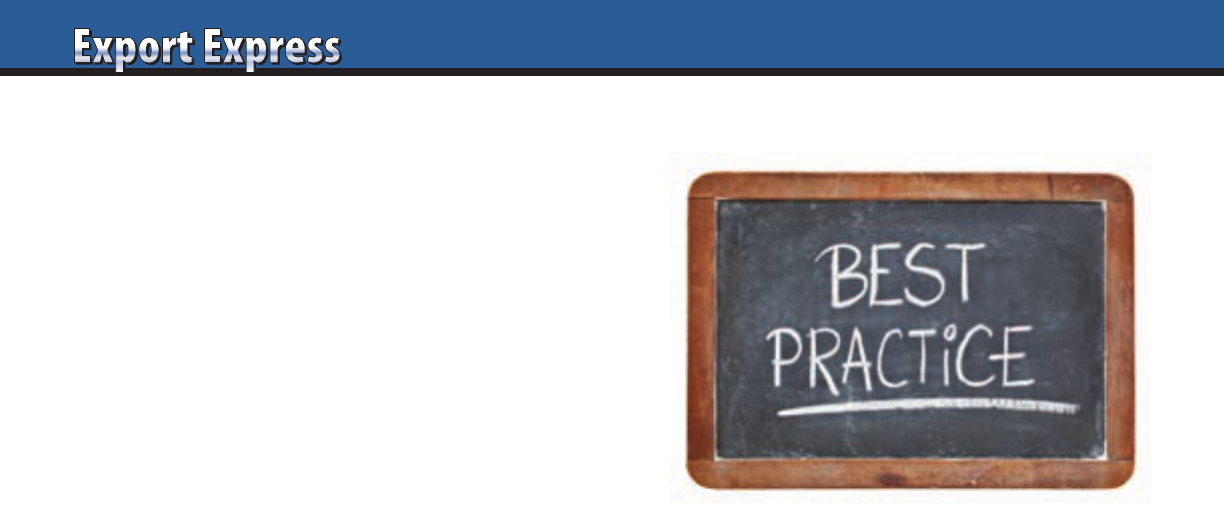
8
Have you ever experienced an incredible
first meeting with a distributor? Strong
alignment, good fit, everyone smiling,
timelines agreed. Then, nothing happens!
The export manager may take up to six
months to translate his outlook from
“done deal” to “dead deal.” There are
two reasons why this occurs.
First, distributors are positive,
competitive athletes, always striving
to win new business. However, in some
cases, the distributors wake up after time
to reflect and decide they really weren’t
that interested in the brand after all.
Failure also results when a strong
first personal meeting at a trade show
or distributors office is followed by
a relationship buried in email
communication, with no personal touch.
Below are Export Solutions’ Ten Tips on
converting promising new business leads
into tangible business partnerships.
1. Zoom/Teams – Don’t Depend on Email
Motivated distributors still return phone
calls, but frequently receive up to 200
emails a day, many from existing brand
partners. Top distributors’ business days
are captured by a continuous flow of
meetings with customers, principals,
and their own employees. Best bet is to
call a potential partner or set up Zoom
meetings. Email is okay for routine
correspondence, but too easy to ignore
or delete.
2. Follow Up Immediately & Frequently
Time slips away, as Export Managers
focus on existing businesses and
“problems of the day.” One tip is to
put regular follow up reminders on
your computer calendar.
3. Focus on 10 C’s: Category Review,
Calculation, Cost of Plan, Compliance,
Contract, etc.
Described below are critical elements to
translate a “lead” into shipments.
Category Review: How does your
category look in target country? Category
size, competition,pricing,margins, and
merchandising activity.
Calculation: What is the distributor’s
proposed calculation from your factory
gate to the store shelf? What are standard
costs like duties and taxes? What are
flexible or negotiable like trade discounts
and distributor margin?
Cost of Plan: Each brand needs a plan
to gain market entry. This includes key
account “sell in,”
followed by consumer
and trade promotion
activities. Look at the
distributor’s proposed
plan, as well as several
options with different
price tags.
Compliance: Many
countries feature a
product registration
process and labeling
requirements. In some
countries, this step is
easy with automatic
compliance for a USA
or European brand. Or a
simple solution with a small distributor
applied sticker. In other countries like
Japan or Indonesia, plan on one year or
more to navigate the complex process.
Contract: “Ready, Set, Go” can be delayed
by 3-6 months due to contract negotiations.
Company lawyers demand 20 page
agreements in English that even the
Brits can’t understand. Distributors
prefer two page letters of understanding
or a handshake deal. Do what is right
for your business, but expect delays
and frustration.
4. Request References
A good idea is to quickly request
distributor references from other brands
they handle. Motivated distributors will
send impressive references right away.
Also, have your credit department run
a Dun and Bradstreet or Equifax report
as soon as possible. Many trade show
meetings are with “pretenders” who state
exaggerated claims and are ultimately too
small to handle your brand. Better to
discover this sooner versus later.
5. Move Beyond the Distributor Owner/MD
The distributor owner “writes the
checks,” but frequently serves as a
“bottleneck.” The key is to quickly get
your brand assigned to a “worker” whose
task is to move your project through the
system and produce an order!
6. Establish Realistic Timelines
Sync with category review dates and avoid
holiday periods. Update timelines
frequently. New distributor relationships
always take longer. Plan on six months
from first meeting to first shipment. Be
pleasantly surprised if things move quicker.
7. Distributor Response Time
Signals Interest Level
How often do you check your emails?
Probably every hour. When I work
on distributor search projects for well
known brands like Pringles, Tabasco,
or Barilla, distributor response is
lightening fast. Motivated distributors
will chase you if they are interested
because they are anxious to start selling
your brand!
8. Establish Regular Checkpoint Calls
I suggest every two weeks at a
minimum. Use a common document of
priorities, action steps, and due dates.
9. Visit the Distributor
It’s amazing the amount of progress
that will be made during a meeting
at the distributor’s office. Also, the
distributor will work hard in advance of
your visit as your project moves up the
priority list and they want to guarantee
a favorable impression. A visit to the
distributor’s market signals your
commitment. Beware if the distributor
is reluctant to schedule your visit. Either
he has changed his mind about a
partnership or his office and capabilities
do not match the bold promises made at
the initial trade show meeting.
10. Parallel Path Two Candidates per Country
A favorable first meeting represents an
excellent start. However, there are still
many steps (think 10 C’s in point 3)
before you sign a contract and receive
your first order. Always keep two
candidates in the process, in case your
top choice disappoints. This can be
tough, but represents a better option
than needing to start the entire process
over again.
Ten Tips: Converting Promising Leads to New Partnerships
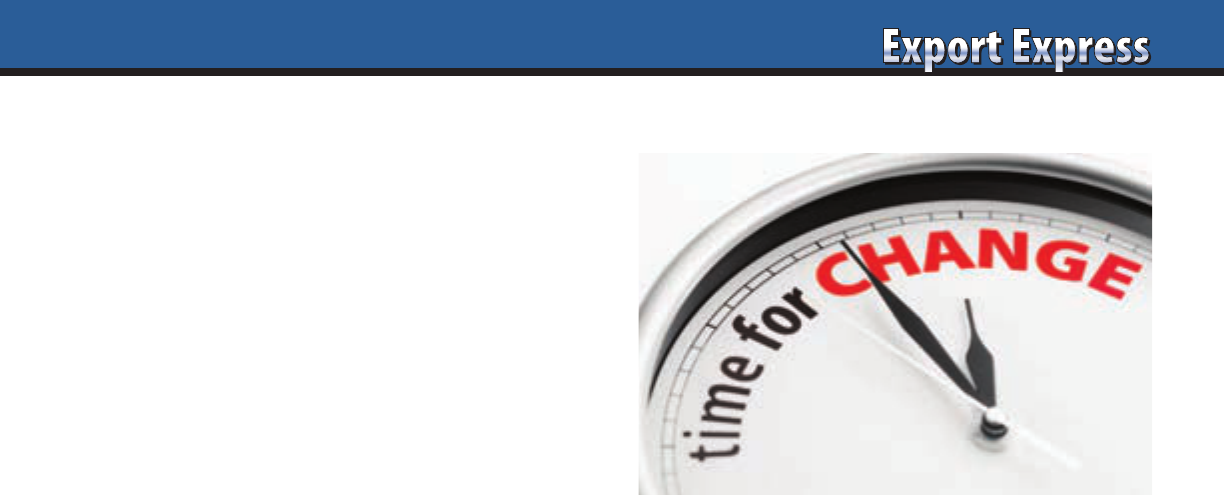
9
Every exporter has countries where
their brand performance lags far behind
expectations and market potential. This
appears as a serious issue when the poor
results are in a large strategic country like
the USA or China. The first step to fixing
the situation is to admit that you have
a problem. Too many times, export
managers loyally cling to their plan and
existing distributor with hope that “next
year will be better.” The likelihood is that
sub-par trends will continue without
intervention. Remember, it’s your quota
and job that suffer due to lackluster
results in a country. Listed below are
Export Solutions’ 10 Tips on action
steps for under performing countries.
1. Look in the Mirror
Chances are that your current brand
proposition is wrong for the country. Your
product sales are a reflection on buyer and
consumer response to your product range.
An underqualified partner does not help,
but is usually just part of the problem.
2. Research Consumer Habits
Conduct category research to understand
why consumers in a foreign country do
not appreciate your brand like they
do “back home.” Category habits and
development vary widely, particularly
around food products. Recently, I
confirmed several examples where Asian
consumers demonstrated little interest in
certain Western style foods (although
everyone loves candy and snacks!).
3. Investment Level
Many poor performers suffer the classic
issue of insufficient funds to invest in
marketing and trade programs. There is a
cost of doing business everywhere and the
investment requirements can be huge in a
place like China or the USA. Best bet is to
break down the country into smaller areas
and focus on targeted investments with
high potential, regional retailers where
your brand has a higher probability of
success. Avoid the attraction of large,
national retailers where you realistically
cannot support the business. Don’t expect
miracles without basic investments in
marketing and trade promotion.
4. Establish and Track In Store KPI’s
Many exporters focus primarily on monthly
shipment numbers. Shipments represent
the ultimate scorecard, but we strongly
advocate the implementation of in-store
metrics. This process starts with major
account listing maps,
tracking your SKU
level authorizations
for major customers.
The second step is to
launch and measure
in-store presence
guidelines. How do
you judge a good
store from a bad
store? Ultimately,
shipments are
a reflection of
consumer purchases,
not inventory sitting
in a distributor’s
warehouse. “What’s
measured is treasured.”
5. Spend a Day at Retail With
Your Distributor Executives
We all spend too much time in comfy
meeting rooms sharing PowerPoint
presentations with optimistic plans.
Dedicate time for retail with the
distributor executive team. Visit stores
at random, picking an area on the other
side of town from the distributor’s office.
Create a store check sheet to capture
observations such as shelf space,
promotions, and competitive activity.
Speak to aisle clerks and store managers
to get “street smart” on your product
and category performance.
6. Secure Direct Buyer Feedback
Every distributor should maintain
excellent trade relations with at least one
of his key accounts (if not all!). Schedule
an appointment or a lunch with a friendly
buyer to secure his point of view. Try to
keep the conversation focused around
category dynamics and trends versus just
a request for more trade spending. Buyers
love to serve as “experts” and may
support you if you follow their advice.
7. Distributor Brand Manager
The Distributor Brand Manager serves
as our everyday contact and the conduit
to distributor resources. Problems may
relate to having an experienced brand
manager handling too many companies
or a junior brand manager, lacking the
clout to get things done with the busy
sales team. We all like our Brand
Managers, as they take our calls
and rescue us periodically, However,
sometimes it’s just not working and
you need a change.
8. Share Best Practices – Adjacent Countries
Every distributor will be quick to point
out “How different their country is.”
The reality is that there are more
similarities between countries than
differences. Look at an adjacent country
or one with common retailers and share
lessons learned. This may represent a
category review, presentation approach
or special sales contest. Invite the brand
manager to visit a successful country
or attend a meeting where best practices
are shared.
9. FaceTime in the Trenches
Distributors appreciate export managers
willing to contribute to joint resolution
of problems. Consider sending a
company employee to work for 3-6
months on assignment at the distributor.
Visit quarterly or more frequently.
Schedule bi-weekly update calls. Better
to focus attention on fixing a high
potential country than regular visits
to small countries achieving their
objectives. “Distributor respects what
the principal inspects.”
10. Partner Change
A distributor change is the last resort,
but sometimes partners outgrow each
other and are no longer a “fit.” Export
Solutions’ database tracks an average
of 82 distributors per country, so you
always maintain options. Transition
to a new distributor involves business
disruption and even a temporary decline
in shipments. The good news is that
your new distributor will be motivated,
committed and anxious to make a
positive impression with a fast start.
The key is to manage the process with
dignity and open communication, so
that the terminated distributor is not
surprised by your actions.
Ten Tips: Action Steps for Poor Performing Countries
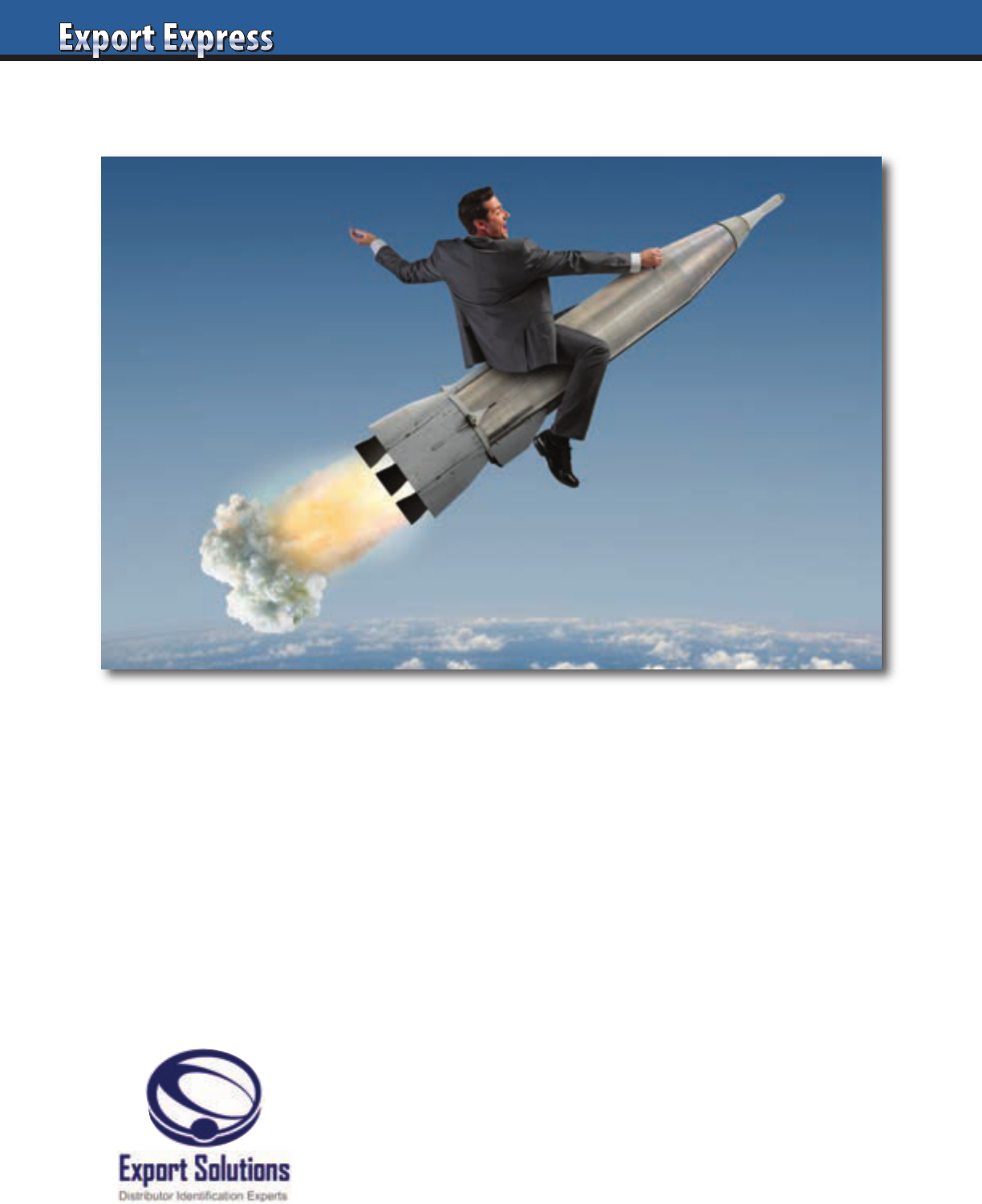
10
Export Accelerator
Contact Us for Distributor Search Help in 96 Countries
Greg Seminara • greg@exportsolutions.com
“Spend time Selling to Distributors versus
Searching for Distributors”
Why have Barilla, Pringles, Nature Valley, Starbucks, Duracell,
Nestlé, Tabasco, Pepperidge Farm, and other leaders used
Export Solutions as a distributor search consultant?
• Powerful distributor network: owner of industry database
9,200 distributors – 96 countries
• Professional 10 step due diligence process
• Results! We make Export Managers’ lives easier!
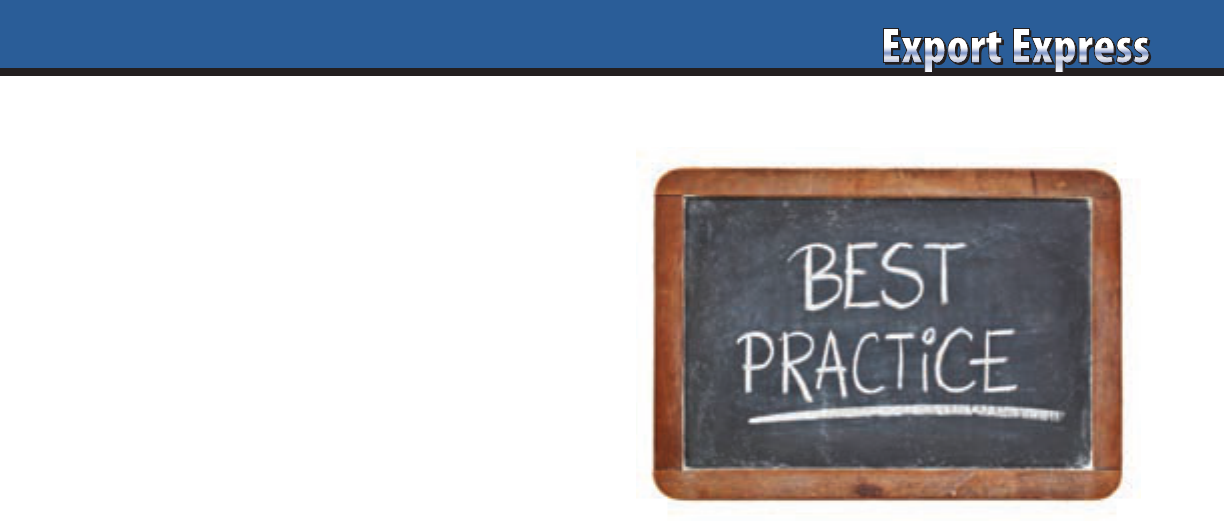
11
E-commerce now accounts for nine percent of USA omnichannel
sales, up twelve percent in the last year according to Nielsen.
Grocery e-commerce sales arre projected to exceed $130 billion
in 2022. No one can accurately gauge how big e-commerce will
become, but it is safe to predict that it will be much, much bigger
in the next five years. Billion dollar multinationals and scrappy
start-ups are attacking this channel with vigor, widening the
performance gap versus successful national brands. In China
and India, e-commerce accounts for a majority of the sales for
many imported products. Read Export Solutions’ ten tips for
capturing your fair share of the growth in this strategic channel.
1. Conduct E-Commerce Survey for Core Countries
Create a one page template capturing local e-commerce
customers, online grocery trends and current distributor
engagement. Calibrate where each country is on a development
curve. Source best practices from distributors in China, India,
United Kingdom, and the USA where e-commerce maintains
highest acceptance levels.
2. Speak to Millennials
Spend time with young people, learning how they shop
and blaze through digital marketing messages. Learn why
millennials avoid “their mothers brands” and how many rarely
make a “stock up shop” at a neighborhood supermarket. Another
revelation is the trust that they place in online reviews and key
influencer recommendations.
3. Create a Global E-Commerce Strategy
Align with your company’s overall e-commerce strategy.
Establish benchmarks and toolkits to share with your
distributors. Acknowledge the fast pace of development,
allowing flexibility to pivot fast.
4. Distributors: E-Commerce Business Plan
Request each distributor to create a 2022 e-commerce business
plan. Include new distribution targets, marketing plans, and
shipment objectives for e-commerce customers. Challenge
distributors to hire a young person to serve as a dedicated
e-commerce key account manager. Review each distributor’s
e-commerce marketing plan early and often in 2022.
“A distributor respects, what the brand owner inspects.”
5. Learn Online Marketing Tactics
Goodbye end caps and slotting allowances. Hello “pay per
click” and first page search results. Unlimited shelf space exists
in cyberspace, with room for every sku that you (and your
competitors) produce. Face-to-face buyer meetings are replaced
by online marketing menu programs and transparent sales
ranking information. Learn the new rules or you will fail the
e-commerce test.
6. Treat Amazon and Alibaba as Global Customers
Amazon revenue will exceed $500 billion by 2022, including
more than $400 billion sourced from sales of goods. Amazon
will comfortably rank as the world’s number two retailer, far
exceeding sales by Carrefour or Costco. Multinational category
leaders have established customer teams to service Amazon.
Many place their best, young talent against this high growth
customer. Multifunctional team roles may share the same titles
in Finance, Supply Chain and Marketing, but the “work” is much
different. What dedicated resources are assigned to Amazon and
Alibaba today at your company?
7. Consider a Web Shop
Direct to consumer represented a complex route to market in the
past. Today, new brands and leading companies are jumping at
the opportunity to showcase their innovation and share in depth
product knowledge through their own proprietary web shop.
Outsourced supply chain experts exist to provide fulfillment
solutions. Tangible profits may be elusive today, but there is
valuable, inexpensive learning to be gained from pioneering
in this area.
8. Hire an International E-Commerce Expert
Appear as a preferred supplier by your distributors by providing
leadership insights into this new trade channel. Distributors in
emerging markets are hungry for best practices in establishing
e-commerce brand building models. Send your e-commerce
expert to core markets to conduct workshop training sessions.
Your investment in an e-commerce strategy and guru positions
your company as a preferred partner helping to build the
distributor’s entire business.
9. Appoint E-Commerce Distributors – Asia
Selling through the e-commerce channel requires different route
to market capabilities and skill sets than marketing through
brick and mortar supermarkets. Consider appointing a separate
e-commerce distributor in advanced countries like China and
South Korea. A key issue is managing pricing equilibrium
between your conventional distributor and e-commerce partner.
10. Track E-Commerce Results
Establish KPI’s and measure performance at key customers such
as Amazon. Are you getting your fair share of the growth?
E-commerce development is a top 2022 priority for every brand
and distributor. Some may say that e-commerce is evolving
slowly in their country or too complex and unprofitable to
allocate resources. These are the same people whose parents
were probably in the horse and buggy or fax businesses.
Enhanced focus on e-commerce will position you as a leader
(or survivor) for 2025.
Ten Tips: Ex-Selling at E-Commerce
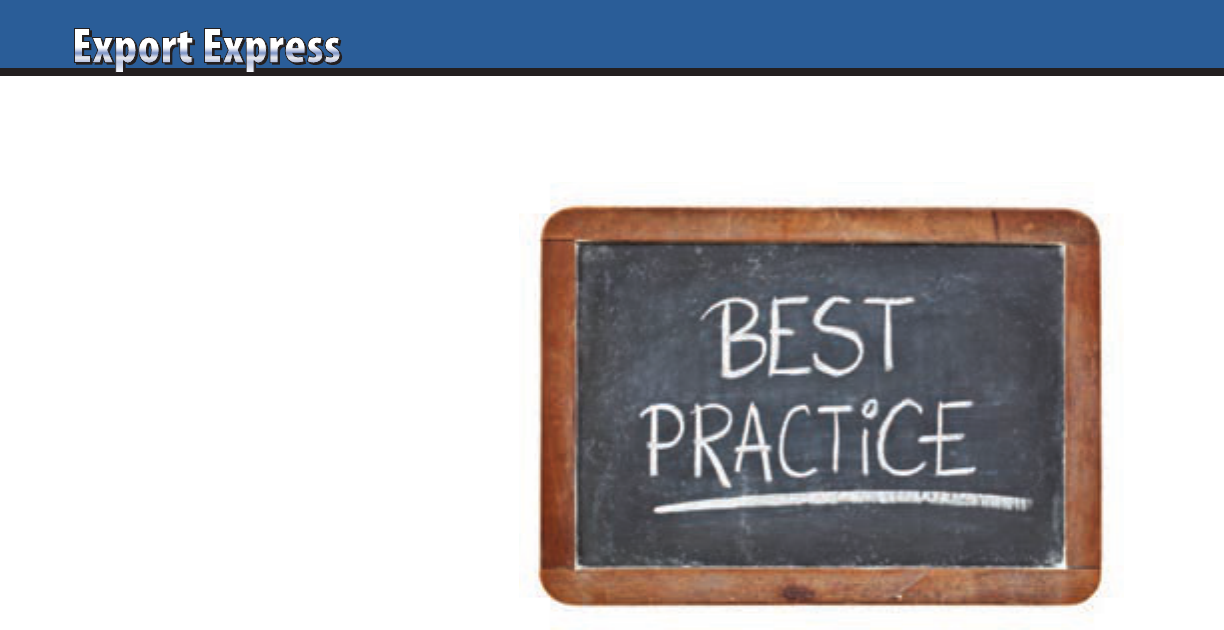
12
Are you selling more to Ireland, Iceland or
India? To the Bahamas, Baltics, or Brasil?
UAE or United Kingdom? Small countries
offer solid business opportunities, with lower
complexity and investment required. All
companies export development plans should
include a mix of strategic countries like China
and the USA (Europeans) plus revenue
generators with fewer than ten million
people. Listed below are Export Solutions’
ten tips on why small countries deliver
big business.
1. Limited Local Production
Small countries are highly dependent on
food imports. Even multinationals tend to
locate factories in larger hub countries. This
creates the opportunity for exporters to fill
a high percentage of a small countries food
supply requirements.
2. Distributor Model – Primary Route to Market
Most companies partner with distributors
in these countries. Leaders like Nestlé
and Unilever may find it more productive
and efficient to use distributors versus
establishing a local subsidiary. For example, Export Solutions’
distributor database supplies information on 63 distributors
in Panama, 87 in Kuwait, and 78 distributors in Croatia.
3. Value Chain – Level Playing Field
Brands are frequently able to compete on a level playing field in
smaller countries. Most products maintain similar cost structures
with importation fees, distributor margins, and retailer margins.
International brands do not suffer the same type of price gap
problems versus homegrown brands as they encounter in large
countries with local plants.
4. Low Complexity – Ship and Sell
In many cases, you are able to sell existing Made in the USA
or Europacks. Compliance may be achieved with a small,
distributor applied sticker. Many countries in this cluster
do not require a lengthy registration process accepting USA
or European standards.
5. Brand Awareness Exists
Surprise! Some consumers in an adjacent small country will
already be aware of your brand. This could result from cable
TV advertising or visits from their citizens to your country.
Costa Rica, Malta, and the Caribbean represent tourist hubs.
These popular hosts feed seasonal residents from the mainland
and boatloads of visitors hungry for their favorite brands.
6. Reasonable Cost of Entry
Launching a new brand is economical. Retailers are frequently
happy with a “free fill” of the first order versus an excessive
listing fee. Demos in a handful of high profile stores will
create visibility. Distributors appreciate your existing point
of sale materials.
7. Best in Class Distributors
Some of the best distributors of the world are based in small
countries. The reason is that even enormous multinationals
partner with distributors in these regions. This propels the
leading players to top ten suppliers to the retail trade. These
distributors implement the best practice models from companies
like Procter & Gamble and apply them to all the brands in their
portfolio. I witness many examples where a powerful distributor
creates a huge success story for a smaller brand based upon their
marketplace clout.
8. Currency and Freight Impact
Many countries consider the USA dollar or Euro as legal tender.
This reduces the impact of currency fluctuation and perhaps
some financing charges. Small countries that depend on imports
across all industries enjoy frequent freight service. This creates
competitive rates and potentially lower logistics costs.
9. Distributors: Excellent Relationships and Coverage
Everyone knows everyone in these countries. Distributor owners
emerge as respected community leaders. They know how to get
things done. Distributors are forced to be generalists, selling to
all customers across all channels and all regions within a
small geography.
10. International Brands: Affordable Luxury
Consumers take pride in offering their families the best food
treats from overseas. These world class brands may only be
a few cents more expensive versus private label type options
which face similar cost structures.
Export Solutions serves as a distributor search “helper,” with
300+ projects completed for more than 50 companies of all sizes.
Contact us to leverage our distributor database and strong
relationships with distributors in 96 countries.
Ten Tips: Small Countries Deliver Big Business
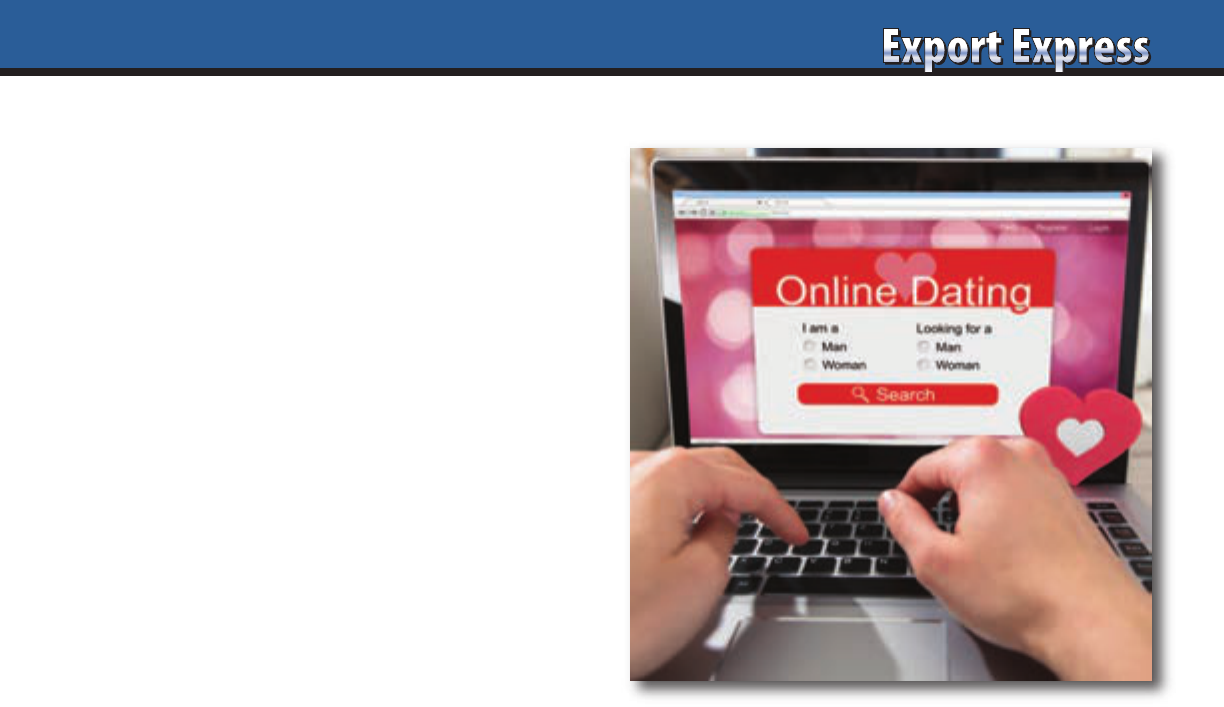
13
How do you sign new distributors without traveling and trade
shows? The export community is rushing to virtual trade shows
as a new tool. Leading distributors are already past the early
novelty of online “blind dates.” What are the new rules of
online distributor dating? View Export Solutions’ 10 tips for
a successful “match.”
1. Are You a Good Fit For Each Other?
The process of exporter and distributor linkage is frequently
random, with little thought to pre-screening for prime prospect
candidates. Our Export Passport system classifies exporters
from level one “start-ups” to level ten multinationals.
Distributors range from one star “pioneers” to five star
“champions.” Exporters should focus on Prime Prospect
distributors that represent a good potential fit based upon
their business aspirations and investment level.
2. What Distributors Want to Know
Create a one page, fact based company profile focused on
“what distributors want to know.” Export managers fill
distributor inboxes with offers loaded with information on
product attributes, but fail to address key issues regarding
brand competitiveness for a country. What is your pricing
strategy relative to competition? How much will you invest
in promotion and media? What is a reasonable size of the prize
for the distributor?
3. Brandscaping – Credentials Makeover
Your website is the first place a potential new distributor will
check before confirming a web meeting. Has your site been
updated to reflect Covid 19 realities? Conduct a credentials
makeover of your web site, company catalog, and standard
presentation. Focus on commercial facts such as your market
share, social media campaigns, and launch model versus bland
promises on superior performance and the claim that you export
to 30 countries.
4. First Date – Casual Coffee
Think of your initial web meeting with a distributor as a first
date for a coffee. Do not try to overwhelm the distributor with
facts and PowerPoints. Send presentations, samples, and your
profile in advance. Devote the “first date” to telling your “brand
story” in a personal way. Share relevant local examples while
supplying a rationale why the distributor and his country
represent a good match with your ambitions.
5. Second Date – Working Lunch
What will the relationship look like if the brand and distributor
decide to work together? Export manager can share a brief
containing their objectives (size of prize), pricing, investment
model, and marketing strategy. Motivated distributors will design
a business plan and questions. These items should be shared in
advance. The second date should be devoted to talking about
the proposed plan and gaining alignment around key issues.
6. Samples – Essential
A distributor will not buy your product without tasting it. Send
samples in advance. Distributors will be compelled to accept the
virtual meeting at the very least to share local feedback on taste
preference. Include a small gift with your company logo.
7. Online Category Reviews – Local Research
Many top supermarket chains feature e-commerce web shops.
It’s simple to conduct basic overseas category reviews from the
comfort of your home office. This allows you to capture local
category dynamics in advance of your call and validate
distributor performance at leading retailers. Export Solutions’
retailer database tracks more than 2,700 retailers in 96 countries,
with one-click links to retailers web shops as available.
8. YouTube Videos Make You Stand Out
Create a fun 2-3 minute YouTube video. Show your factory,
product range review, and introduce your export team.
Demonstrate your creativity and what an energetic partner you
will be. Balance original content with professional quality.
9. Check Out Their Family
Reference checks are essential with online distributor dating.
Conduct a Google map search to see the distributor’s building.
Check out how many employees they have on Linkedin. See
their depth of product listings on local supermarket web shops.
Check with two or three of their existing suppliers. Run a Dun
and Bradstreet financial check. No company is perfect, but you
must provide extra attention to the due diligence process during
this period of uncertainty.
10. Visit Before the Wedding
Online distributor dating (or Zoomerce) can streamline the
process of new distributor screening. However, nothing replaces
the intimacy of a personal visit to the distributors country. It may
be possible to complete the preliminary “dating” steps online.
However, it may make sense to delay the wedding ceremony
until you can visit the country in person. Divorce is ugly and
costly. As with many couples in love today, it may be better idea
to delay the wedding to enjoy a longer honeymoon. Good luck!
Online Distributor Dating: 2022 Rules
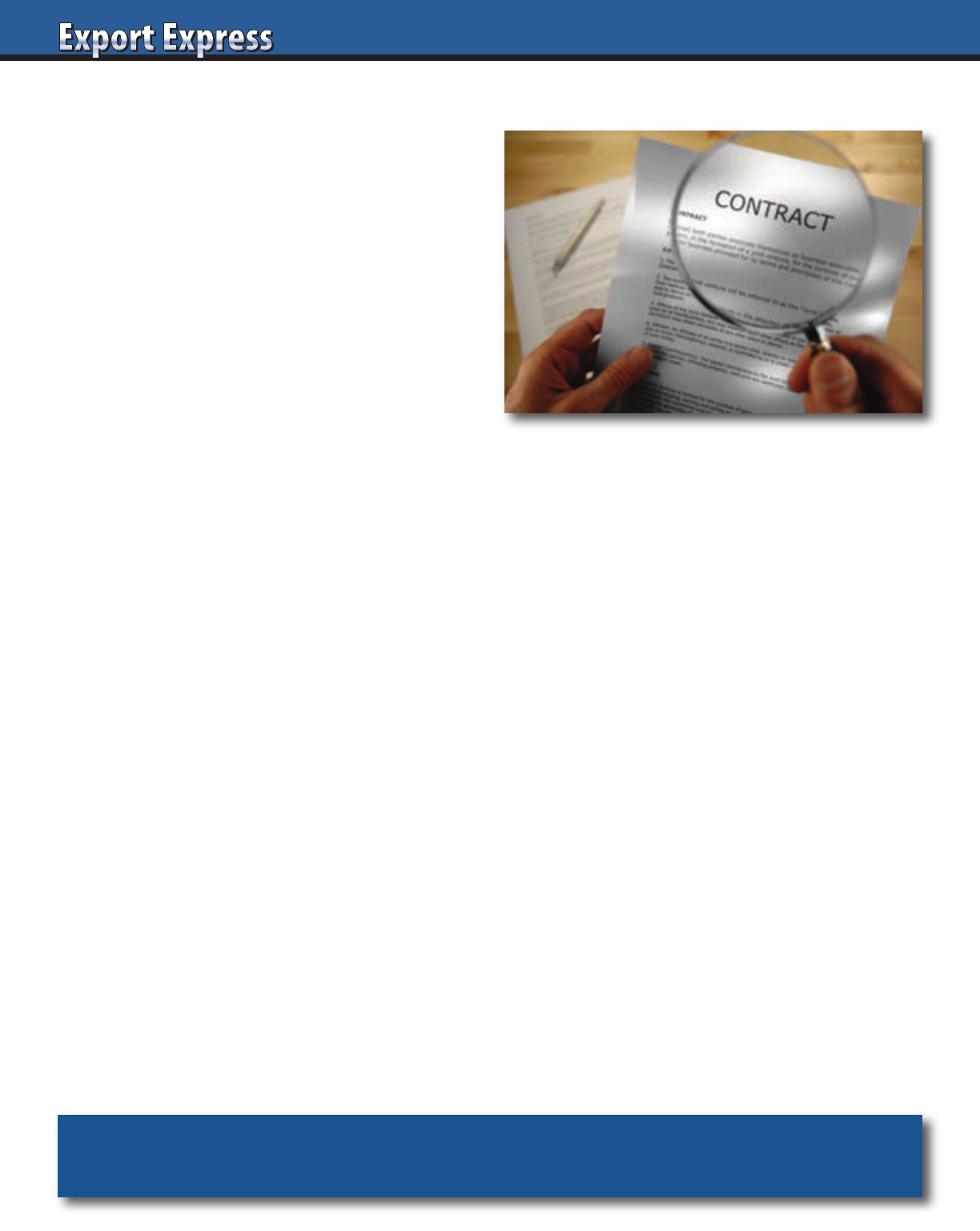
14
When was the last time you reviewed your distributor contracts?
Fortunately, both brand owners and distributors only dedicate
time to these documents at the start of a relationship or when the
end is near. View our ten tips on handling distributor contracts.
1. Contract, Letter, or Handshake deal?
Most companies maintain a mix of these type of relationships.
This is normal, although most wish to standardize the model.
The rule of thumb is that the “more money you spend, the more
detailed the contract you need.” A simple two page letter of
understanding may be appropriate for a small business or a
handshake commitment in situations where the distributor
“buys and resells.” However, fully supported brand launches
and business management of a global brand usually requires
a detailed contract to protect both parties.
2. Sole Versus Exclusive Distributor
Most distributors demand country exclusivity. This is standard,
but may cause problems if the region is subject to inbound
shipments from global customers, e-commerce, or grey market
traders. A compromise is to offer a contract as the “sole”
distributor, providing protection from the manufacturer
appointing multiple partners in a country.
3. Distributors are Customers
At contract time, some manufacturers fail to remember that
distributors are customers, buying your product and reselling
to all local retailers. Suppliers may forward “one way” contracts
that are biased to terms favoring the manufacturer. Would you
send a contract like that to Kroger, Carrefour, or Tesco? Key is
to strike a reasonable balance favoring commercial sensibilities.
4. E-Commerce Implications
Many distributor contracts were executed before the advent
of e-commerce. Revised agreements may be necessary
incorporating e-commerce service requirements: items,
pricing, inventory, metrics, channel exclusivity.
5. Local Law Dominates
Overseas companies should have their contract reviewed by
a local law firm to guarantee compliance with local regulations.
For example, in Puerto Rico and Belgium, distributor (agent)
protection laws supercede any contract language.
6. Point of Arbitration
Normally, the brand owner automatically assigns his home
country as a point of arbitration for any disputes. In some cases,
both parties select a neutral country like Switzerland. A global
corporate counsel once taught me that ultimately any dispute
will need to be resolved in the distributor’s home country. For
example, a USA company can sue a distributor in a USA court.
It is unlikely that the distributor will hire a USA lawyer or even
show up. The USA court may enter a judgement, but the brand
owner still needs to go to the distributor’s country for enforcement.
7. Notification of Contract Termination
Standard contracts appear for two or three years with provisions
for automatic renewal. Distributors fight for long lead times; a
loss of brand can represent a major disruption. From a brand
owner’s side, would you want a terminated employee working
for you for six months or one year? I prefer three months
notification, but that can also backfire if the distributor resigns
your business.
8. Loss of Major Principal
Sadly, I have witnessed distributor bankruptcies because they
were doing “too well.” A distributor grows the brand to a size
where the manufacturer decides to take the brand back and form
a subsidiary. The distributor scrambles, but sometimes they need
to lay off more people and causes a rapid exit of other brands.
2022 contracts should require distributors to inform you within
10 days of notification (not effective date) of any loss of principal
representing ten percent or more of their business.
9. Global/Regional Customers
Large players like Walmart, Costco, Amazon, and Carrefour can
be difficult to manage. They demand best pricing system wide or
threaten to trans ship from other locations. In some cases, these
retailers may demand to “buy direct.” In this case, you can add
an “indent” clause permitting this practice while compensating
the distributor for local services such as merchandising.
10. Late Payments & Currency Exchange Rate
A distributor that pays late signals financial difficulties. Include
a clause that allows you the option to consider the contract in
default with payment delays beyond 45 days or with frequent
problem payers. The benchmark for calculating currency
exchange rates should be specified in the contract. I have seen
cases where a distributor assigns a five to ten percent benefit in
his favor to protect against the possibility of currency swings.
10 Tips: Distributor Contracts 2022
Need more information? Visit www.exportsolutions.com.
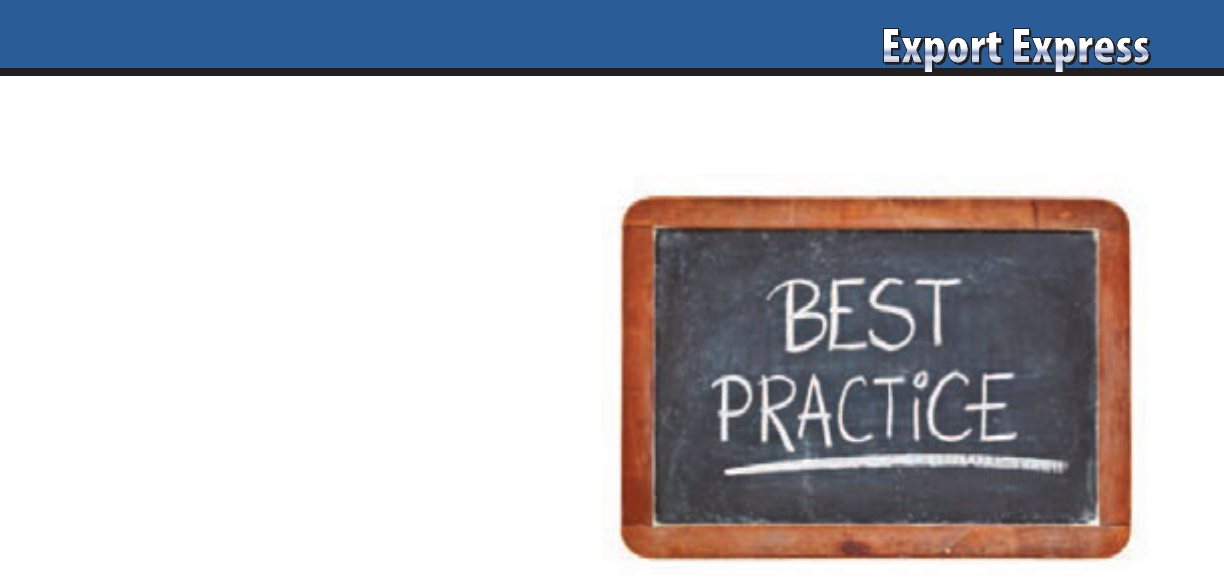
15
Everyone Loves Samples – Ten Tips
Do you enjoy free samples? Everyone is delighted to try a new
product. In most cases, feedback is positive and starts the road
to a purchase and a potential customer for life. Every export
manager is proud of their product quality. However, many
companies underinvest in sampling as an essential marketing
tool. Read Export Solutions’ 10 Tips for expanding your
sampling program.
1. Trial/Snack/Travel Size
Do you offer a small size suitable for sampling? Options range
from a specific trial size to a one-use portion of your product.
Many retailers dedicate valuable cashier checkout space or travel
sections for small sizes.
2. Influencer Product Seeding
Digital influencers are critical when targeting the generation
glued to their phones. Stand out to influencers with a hand-
written note and a sample of your best product. Engage with
the influencers after sample delivery and develop a relationship
versus a one-time campaign.
3. Uber Eats & Grubhub
Online food delivery services are expected to record more
than $28 billion in sales in 2021. Companies should adapt
their Foodservice channel strategies to include sample sizes.
The format can be a portion pack condiment, mini desert treat,
or a trial size of a related product. These can be added to a
meal delivery from a high profile restaurant as a gift to their
customers and to strengthen their overall usage of your brand
“back of house.”
4. Co-Promote
Sampling may be expensive, so it’s always good to co-promote
with adjacent products. Partnerships with other brands from
a shared distributor or through a bulk mailing from your
country’s food trade promotion organization represent efficient
options. “Think about the entire plate, not just your product.”
5. Distributor Samples
Distributors serve as your local brand ambassadors. Include
ten cases of samples with every container order. Encourage
the distributor to supply a case of “car stock” to each sales
representative to share with store managers. Donate samples
to employees’ children’s sports teams to build goodwill.
6. Trial Size Shippers
Retailers love these profitable display pieces as they generate
profitable sales revenue versus a free giveaway. Normally, these
special display units contain about 30-50 units and retail for
$1 to $2 per unit with a profit margin of 50%. Shippers can be
efficient, with no listing fees, representing a simple “in and out”
trial generating promotion.
7. Subscription Boxes
Amazon offers more than 400 monthly subscription boxes.
A typical box contains samples of 5-10 products. USA examples
include Nom Nom and Try Treats for international snacks. Delta
airlines supplied me with a tasty sample box for lunch last week.
8. Embassy Sampling
Many companies’ product portfolios represents regional cuisine,
a new taste overseas but highly appreciated by local expats.
Request that your distributor drop off cases of product samples
at your overseas embassy. Sponsor national holiday events for
the expat community. Your product may even be featured at an
ambassador’s dinner!
9. Event Sponsorship
Everyone looks forward to the return of outdoor concerts and
festivals. These fun events can be impactful places to sample
beverages and indulgent products like biscuits, snacks, candy,
and ice cream.
10. Sample Truck
I love the story of a European protein bar manufacturer who
painted a truck with his brand colors. His team drove all around
town distributing samples. The truck arrived at stores, buyers’
offices, and even major trade shows. No surprise that this
manufacturer gained a loyal, youthful following with this
adventurous approach.
Be generous with your samples! Delight potential buyers
and distributors with your wide range of innovative products.
Always include a memorable gift with your company logo.
Remember that no potential new distributor will sign an
agreement with you until their team has tried your product
and given it the “thumbs up.”
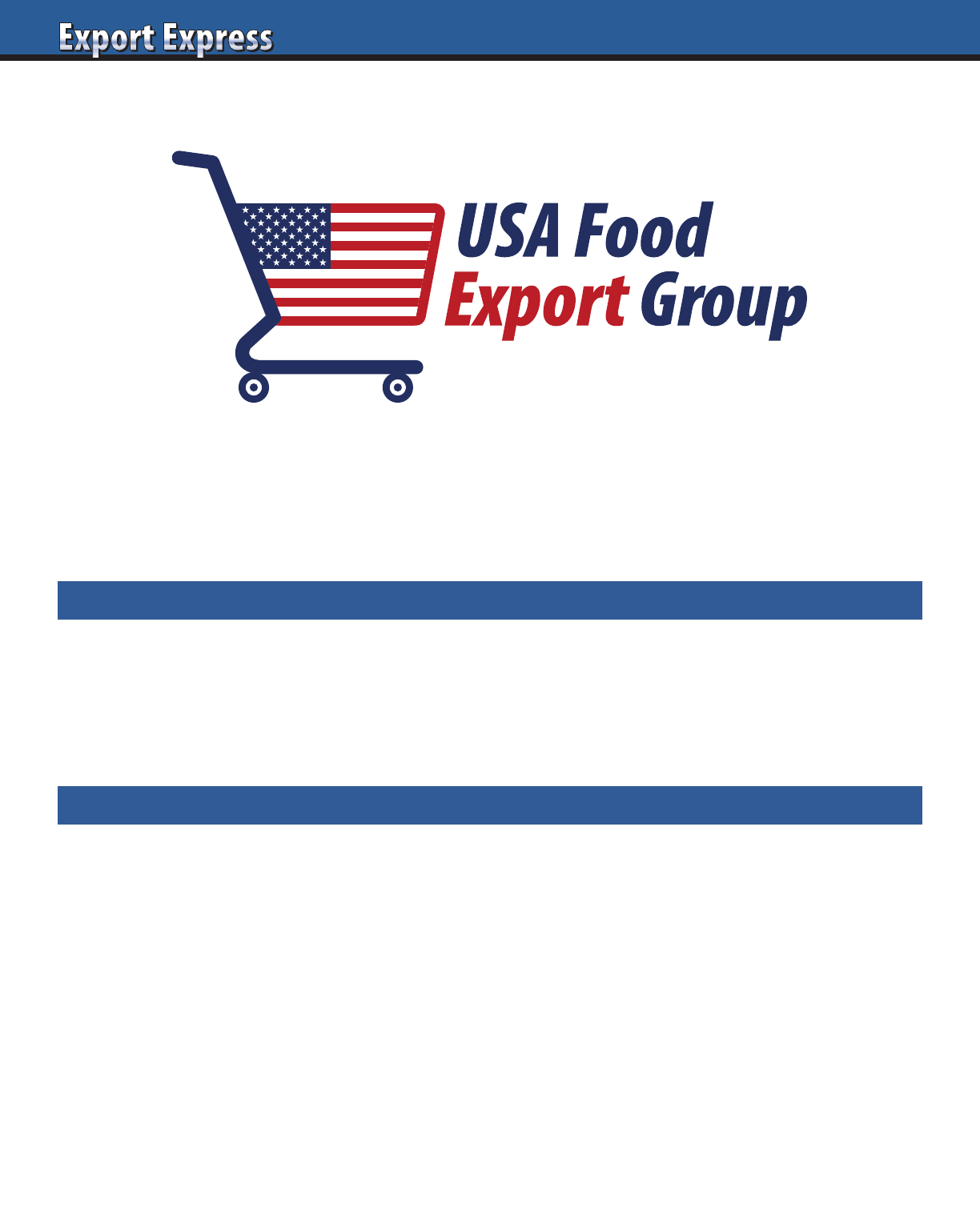
16
Introducing
America’s Favorite Brands
Executive Board
Export Solutions Smucker’s Tabasco
Greg Seminara, CEO Danny Berrios, President Megan Lopez, Vice-President
General Mills Sun-Maid
Eric Saint-Marc Carsten Tietjen
Advisory Board
Bazooka Candy Blue Diamond Bob’s Red Mill
Santiago Ricaurte Dale Tipple Jan Chernus
Bush Beans Campbells Church & Dwight
Dave Bauman Julio Gomez Arun Hiranandani
Ferarra Candy Heartland Idahoan
Daniel Michelena Tom Theobald Ryan Ellis
Johnsonville Sausage Kao USA Keurig Dr. Pepper
Cory Bouck Julie Toole Billy Menendez
Mizkan Reynolds Welch’s
Noel David Chris Corey Marc Rosen
19 Companies | 200+ Top Brands | $80 Billion Combined
View our activities for export managers – www.usafoodexport.com
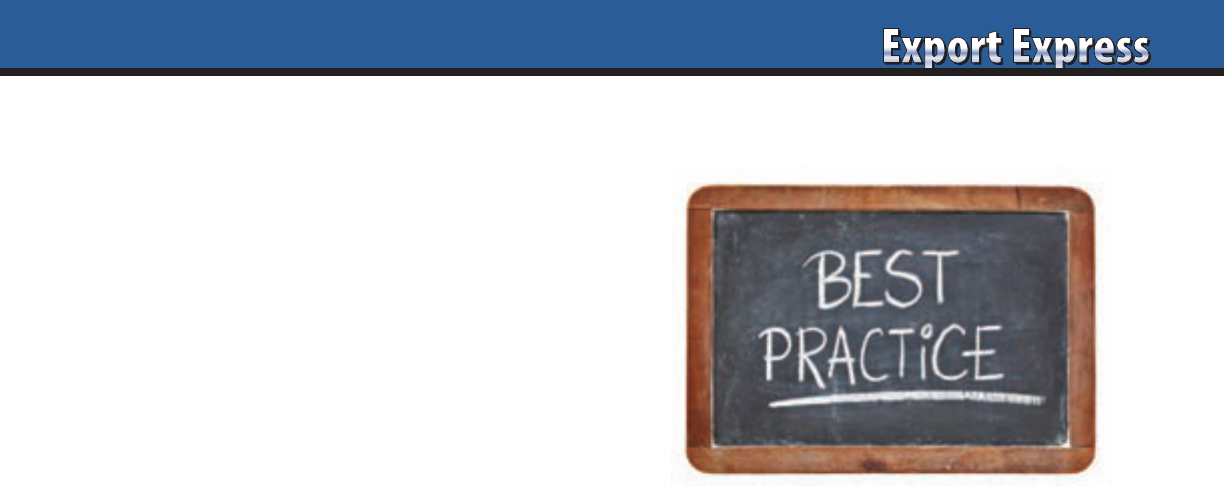
17
How much do you pay for a display or special promotion
at your top customer? Retailers from Argentina to Vietnam
capture manufacturers’ promotion money to drive sales and
profits. Brand development and market share are frequently
proportional to investment level. In the world of export, you
must “pay to play.” However, different models exist to fund
trade activities. Leading distributors confirm that they work
with a variety of different structures. “It’s all money” and the
key question remains: under which cost line do you want this
investment to sit in your price calculation?
Manufacturer Funded Promotion Budget
The classic approach is for the brand owner to develop a joint
business promotion plan with the distributor. A spending budget
is developed, funded 100% by the manufacturer. The overseas
distributor pays the local retailer and sends a billback to the
producer, with proof of performance. The rationale for this
practice is that the supplier owns the brand equity and can
change distributors. Distributors are reluctant to invest their
own margin into another companies brand.
Split Fund – “Skin in the Game”
In some cases, the brand owner and distributor split the
marketing plan costs, usually “50-50.” A further variation
exists where the brand owner covers the cost of consumer
marketing and the distributor pays for the periodic trade
promotion discounts. The philosophy is that the distributor
will benefit from higher sales and will also be motivated to
execute successful promotions if their own money is invested.
This structure appears most frequently with an existing brand,
with a minimum three year history of shipments. In reality, the
distributor calculates the expected investment and builds it into
his cost structure. A “50-50” shared model will usually not be
accepted with a new brand pioneered for the first time.
Best Price – Dead Net
Dead net pricing is the third model. In this scenario, a
manufacturer provides a distributor with his very best
price. The distributor builds in all promotional support and
his margin into his calculation. In this case, the manufacturer
does not receive a constant stream of requests for more
promotion funding. However, the brand may lose control
of their pricing model or be under supported if the distributor
fails to promote at adequate levels.
10% of Sales – $1/Case
Another common model is for a manufacturer to establish a fixed
funding rate per case sold which the distributor invests to build
the brand. Normal funding begins at 10% of case cost, but can
accelerate to 20% or more for a competitive category. Some
manufacturers offer a flat rate per case or amount per container.
As mentioned before, it ultimately converts to a pile of money
to invest in brand building. This approach functions best with
a brand with a current sales history, as percentages don’t mean
much when the brand has zero sales.
Listing Fees
These one time payments are primarily covered by the brand
owner as part of upfront launch costs. Sometimes these fees can
be rolled into introductory promotions, spread out over twelve
months, or paid via free goods. Please check out Export
Solutions’ article Ten Tips: How to Minimize Listing Fee Payments
for more ideas on how to reduce these payments.
Most Effective Promotion Vehicles
Every key account manager should know the best promotion
vehicles to drive incremental sales at their customer. At some
supermarkets, promotional leaflets drive tonnage. At others,
deep discounts (30% +) or displays are winners. Distributor
sales teams are market experts and can source best practices
from their other brands.
Post Promotion Analysis
Tools are available to measure promotion effectiveness. These
evaluate sales lift, boost in baseline consumption, and cost per
incremental case. A good idea is to analyze mutiple scenarios
such as different price points, seasonality, and display support.
Creativity Counts
Many of the best trade promotion success stories involve
field activated promotions. This allows a brand to break
through the clutter of too many “me too” events. The sales
team maintains ownership and enthusiasm to drive support.
Another positive strategy is aligning with a retailer’s favorite
charity to contribute to the community while building your
brand. Manufacturers must avoid the dull routine of repetitive
15% trade promotions. Boring!
Key Issue – Distributor Underspends
Distributors are businesses, aimed at achieving a fair profit, just
like your company. A risk occurs whenever distributors claim
responsibility for managing the trade discount plan for their
country. At times, these trade discounts can be under spent
versus category and brand requirements. For example: when a
distributor says that he will fund four promotions per year, does
that mean at a 10% level or 30% level? Will the distributor funded
promotions be for all channels and retailers or just a few
customers? How do you know?
Compliance and Audit
Most distributor contracts include provisions for audit of trade
promotion payments. Larger suppliers include trade promotion
payment software. Good practices are complex and require piles
of paperwork. A core message is that the “distributor respects
what the manufacturer inspects.”
Export Trade Promotion Funding

Searching for New Distributors?
Export Solutions makes life a little easier for more than 3,000 export managers.
Our time saving distributor database serves as a “helper” for identifying more
than 9,200 qualified, local brand builders in 96 countries.
“Select Your Distributors,
Do
Not Let Your Distributors Select You”
www.exportsolutions.com
Local Experts
Distributor Coverage
Asia: 2,030
Europe: 3,139
Latin America: 1,574
Middle East: 937
USA/Canada: 1,464
Category Experts
Distributor Coverage
Beverage: 1,691
Candy/Snack: 2,713
International Food: 3,276
Health & Beauty: 1,800
Natural Food: 837
Country Experts
Distributor Coverage
German Brands: 648
Italian Brands: 1,397
UK Brands: 682
USA Brands: 1,189
Search by Country, Category, or Country of Origin
18
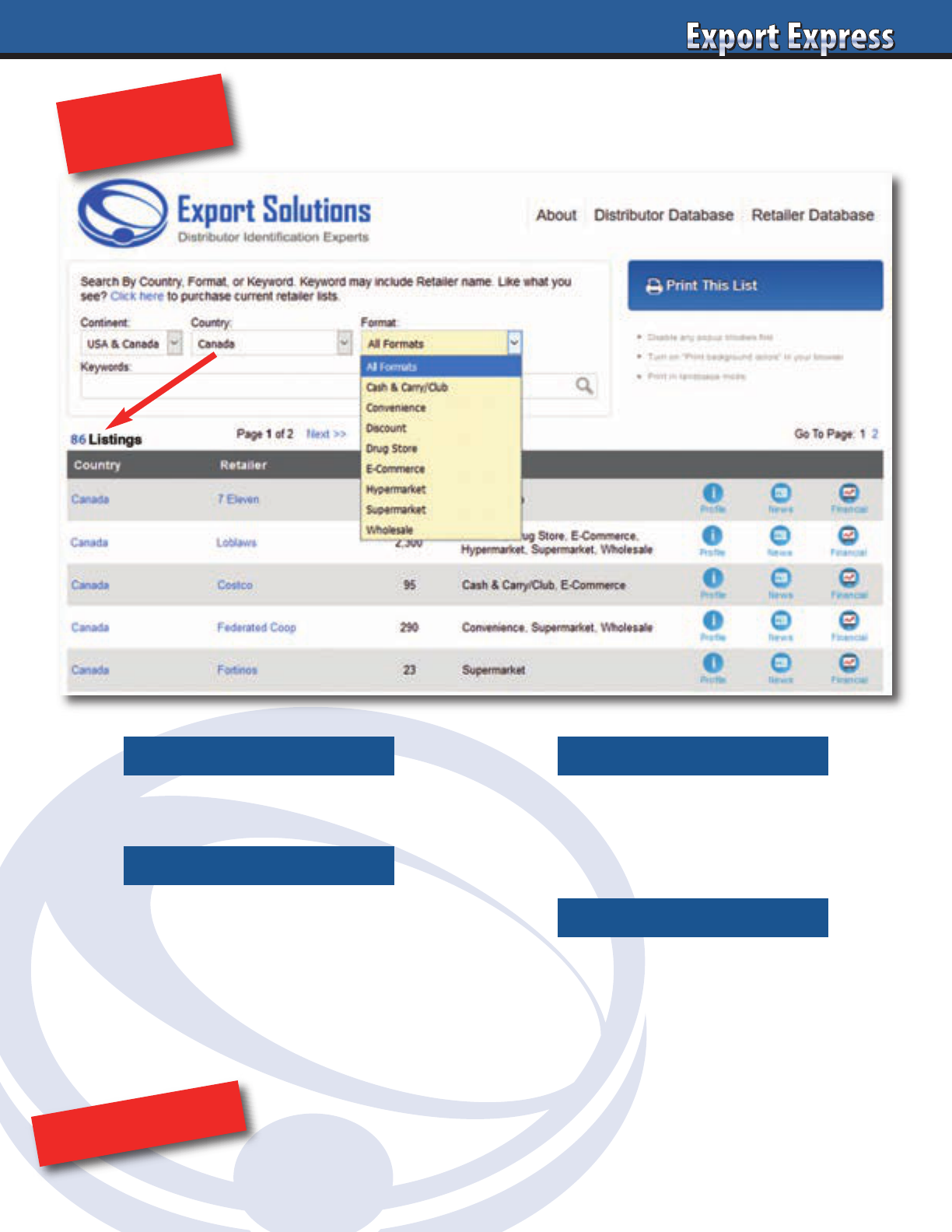
Coverage: 96 countries and 2,700 retailers
Supermarket
Convenience
Drug Store
Natural Food
Club, Cash & Carry
Supplying profiles, store counts, formats,
news and info for Top 100 international
retailers plus all overseas branches
Example 1: Who are supermarket
retailers in Canada?
Example 2: How many stores does Loblaws
operate by banner, in Canada?
NEW!
ORDER NOW!
19
Search by Retailer NameSearch by Country
Combo Search
www.exportsolutions.com
Search By Format
Retailer Search Made Simple
Canada Example
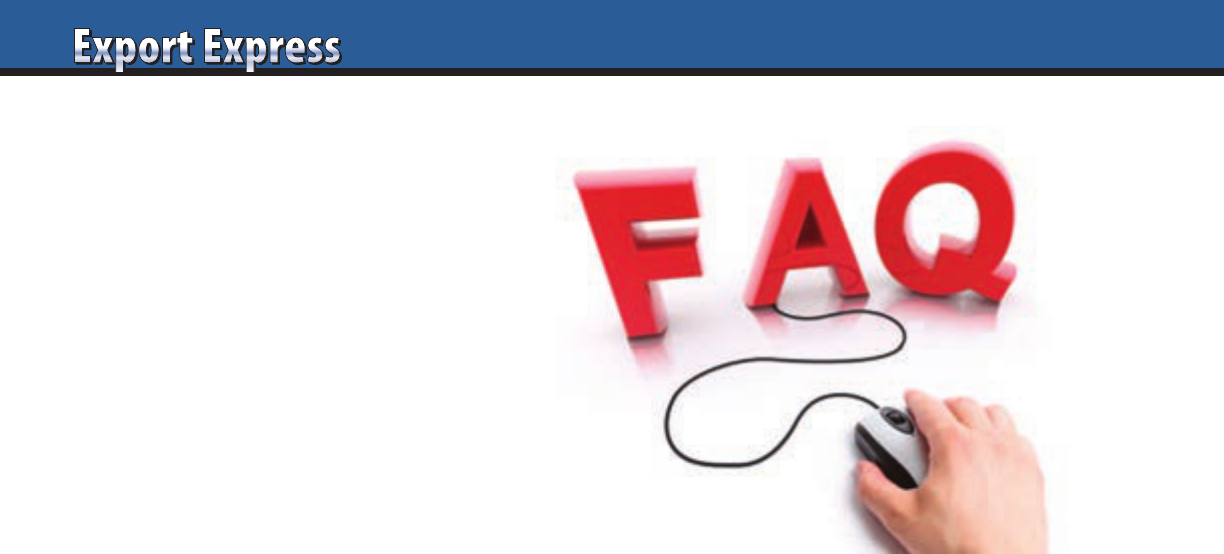
20
Why did you create the retailer database?
Export managers dedicate a lot of time
to researching countries, retailers and
preparing business plans. A standard KPI
measure is tracking product listings for
key customers. I believe that our industry
could benefit from a global retailer
database to instantly locate retailers
and their store counts in 96 countries.
The retailer database is a logical extension
of our leading distributor database which
has helped more than 3,000 companies
build export sales during the last 10 years.
What is your geographic coverage?
96 of top 100 GDP countries worldwide.
This includes most Asian, Middle Eastern,
and European countries. Our database
covers every country in the Americas.
In Africa, we cover South Africa.
What is your format coverage?
Excellent coverage of chain supermarkets,
hypermarkets, clubs, cash and carry, and
convenience formats. Solid initial coverage
of drug stores, natural food stores, and
e-commerce channels. Our database does
not cover DIY/hardware, toy, office,
liquor, or sporting goods channels.
Retailer database: featured info
Profile – Retailers profile and link to their
internet home page.
Formats – Retailer’s stores segmented
by format and banner.
We track supermarkets, hypermarkets,
cash and carry, convenience stores,
discounters, drug stores, natural food
stores, and e-commerce retailers.
News – Latest retailers’ news. In some
cases (Asia), we substitute a link to the
retailer’s latest promotional flyer.
Financial – Many leading retailers are
publicly traded. A link is provided to
their latest financial results. We do not
offer estimated financial information for
privately held or family owned retailers.
How is your coverage of global retailers?
We offer total coverage for top 100 global
retailers. This includes all of their
branches and banners. Searchable!
Use filters to research Walmart, Costco,
Carrefour, Tesco, Metro, Casino presence
by country. Database covers retailer’s
total store outlets as well as a breakout
by banner and format.
What can I use the retailer database info for?
• Obtain an instant snapshot of an
average of 24 retailers per country for
96 countries.
• Track presence of global retailers like
Walmart, Carrefour, and Metro AG.
• Create country specific listing maps
where distributors measure brand
authorization by retailer.
• Conduct home office based
international category reviews
and price checks from retailers’
e-commerce sites (not all retailers).
• Prepare annual reviews and reports
with up-to-date information on leading
retailers and channels.
Searchable
The database offers filters allowing you to
search by country, format, or retailer name.
You can also use a combination of filters for
your research.
Can I get a free sample of the retailer database?
Sure! Check www.exportsolutions.com for a
complete profile of United Kingdom retailers.
Do you provide retailer’s annual sales
or market share information?
Accurate annual sales information is
available through the financial link for
publicly traded companies. We do not
provide estimated financial information
for privately held and family owned
retailers. Channel blurring occurs between
supermarket, convenience, e-commerce,
and even natural food operators. We do
not provide market share due to difficulty
to accurately isolate and define channel
market share information, particularly
with so many privately held retailers.
How accurate is the retailer data?
Export Solutions’ retailer database is
updated weekly, so information is highly
accurate. Retailer names, web sites, and
formats rarely change. This makes the
database 99% accurate at the company
level. New stores open every day,
resulting in store counts that may be
95% accurate. We intend to update store
counts on a regular basis.
How much does retailer database access cost?
An annual subscription to the retailer
database is $975. This supplies one year,
unlimited access to more than 2,700
retailers in 96 countries. Special offers
available for our distributor database
customers. Note: special pricing for
government trade organizations.
How do I access the retailer database?
Visit www.exportsolutions.com and click
the retailer database page. You can place
a subscription or individual continent
(i.e., Europe) into a shopping cart.
Register and check out via credit card.
The process takes two minutes and we
automatically send you an invoice.
About Export Solutions
Export Solutions was founded in 2004
and is based in Atlanta, Georgia in the
USA. Export Solutions serves as a leading
provider of business intelligence to the
food and consumer goods industries.
Our distributor database covers 9,200
distributors in 96 countries and has
been used by more than 3,000 clients.
Our Export Express newsletter has a
circulation of 9,900 and is viewed as an
important source of insights, strategies,
and templates for international
development. www.exportsolutions.com.
FAQ’s – Retailer Database

All your distributors express enthusiasm
and commitment for your brand. True
passion for your partnership is measured
by what distributors do, not by what they
say. Listed below are ten tips to consider
when measuring Distributor enthusiasm
for your brand.
1. CEO Commitment and Involvement
The CEO steers the distributor ship
and sets the tone for your business
relationship. Best in Class Distributor
CEO’s reach out via phone to touch base
periodically and spend time with you
when you are in town. They keep up
to date on your priorities and key issues
and ensure that his team is delivering
good service and results.
2. Responsiveness to Problems
Urgent situations erupt in every market.
Currency devaluations, product recalls, or
missed budget numbers require immediate
attention. What is the distributor response
time? Does the distributor share your sense
of urgency? How long does it take to get
problems fixed?
3. Customer Introductions
Most distributors maintain good
relationships with leading retailers.
Enthusiastic distributors are happy to
introduce you to the leadership of their
customers. These distributors will use
their personal relationships and “favors”
to benefit your brand.
4. Best People Assigned to Your Brand
The distributor functions as a team.
Every team has superstars and
developing players. How does the
distributor allocate “talent?” Are the
stars working on your business?
5. Web Site Prominence
A Distributor’s web site offers important
clues to distributor professionalism,
services, and core brands. How
prominently is your brand featured on
the distributors web site? Is a case study
using your brand results mentioned?
Is your brand logo listed at the top of
the page or buried at the bottom?
6. Distributor Visits to Your Headquarters
How often does the distributor travel
to your headquarters or factory? Does
the distributor have a relationship with
your CEO, vice president of international,
or other leaders? Many distributors are
interested in visiting companies based
in San Francisco or London, but true
enthusiasm accompanies meetings in
Chicago or Hamburg during the winter!
7. Creative Ideas
Distributors can be magicians at
developing “new ways to solve old
problems.” Good distributors bring
innovative ideas to adapt your plan
and funding budget to the local market.
How often does your distributor apply
their brilliant new idea to your brand?
8. Distributor Awards and References
Successful distributors proudly display
their awards in conference rooms and
lobbies. Is your award visible? I always ask
distributors for references from other brand
owners. Does the distributor use your
name as a reference or request a testimonial
from you on their performance?
9. Love Your Brand
I have written an entire article on
getting a Distributor to Love your
Brand. There are many ways to feel
the love. Does the distributor sales team
wear the shirts with your brand logo or
use the pens that you handed out at the
last sales meeting? Is the distributor
able to secure a customer meeting for
you on one week lead time? Are they
happy to see you arrive or just to see
you depart?
10. Exceed Expectations Everyday
The most enthusiastic distributors
exceed your expectations everyday.
This includes shipment results in excess
of overall market growth and total
organizational support behind your
new product introductions. Enthusiasm
is not measured in words and weeks,
but in actions carried out over many
years by a Best in Class partner.
Ten Tips: Measuring Distributor Enthusiasm for Your Brand
Need a hand? Visit www.exportsolutions.com.
21
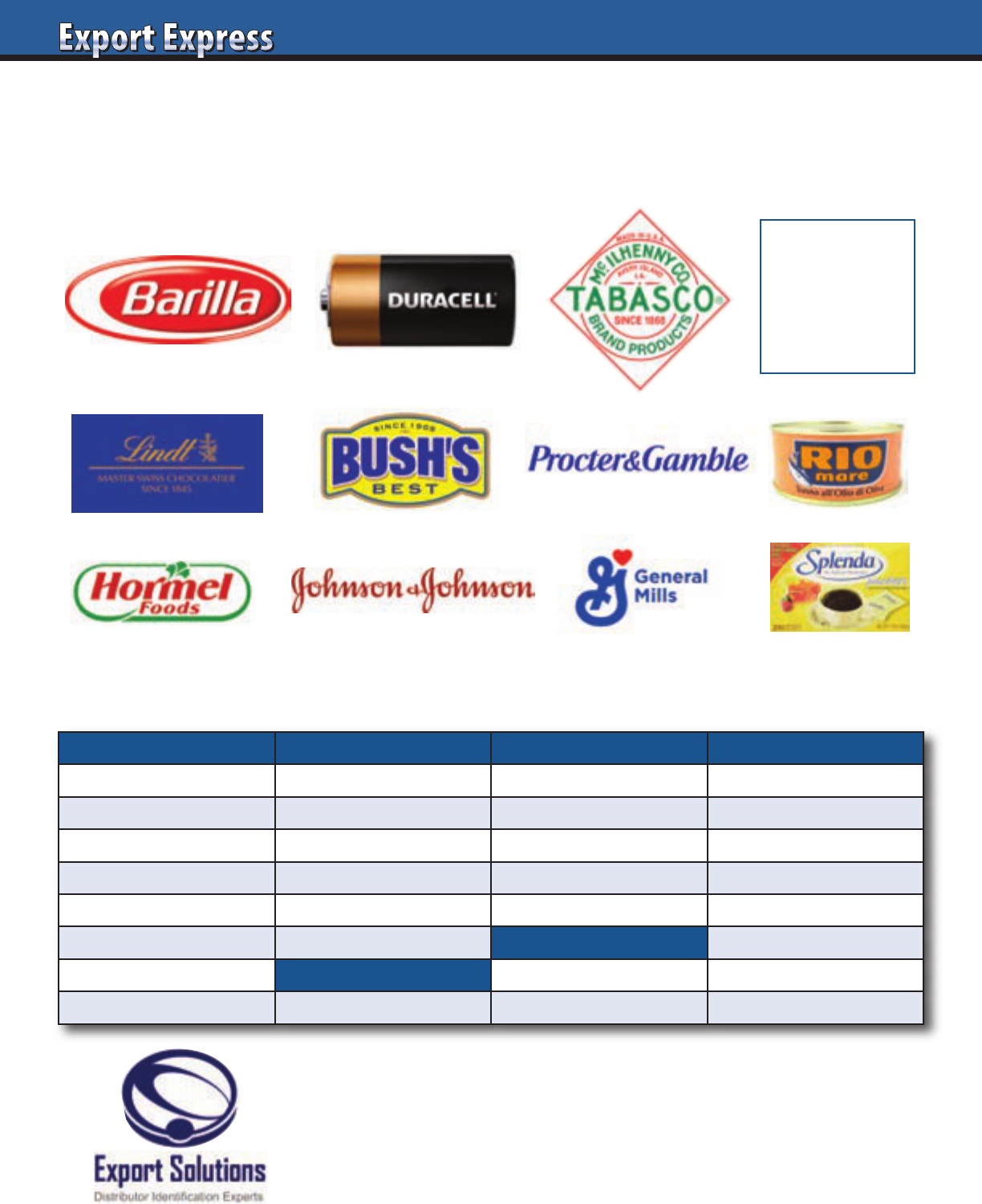
22
Distributor Search Helper for:
Your
Logo
Here
Can We Help You?
Recent Distributor Search Projects
Asia Europe Middle East Latin America
Australia Germany Israel Argentina
China Ireland Kuwait Brazil
Indonesia Netherlands Qatar Colombia
Japan Nordics Saudi Arabia Costa Rica
Malaysia Spain UAE Ecuador
Philippines United Kingdom North America Mexico
Singapore Africa Canada Panama
South Korea South Africa United States Peru
Call the Export Accelerator!
Contact Greg Seminara at greg@exportsolutions.com
to discuss your business development project.
www.exportsolutions.com

You can usually spot an export manager in the fast track lane at
airport security with the diamond level frequent flyer card and
bulging passport. Many of us spend half of our business lives on
the road, serving as roving brand ambassadors for the companies
that we represent. Our friends envy this glamorous life, little do
they know how punishing it is to take red-eye flights and eat
mediocre airport food. While this lifestyle appears as normal for
most of us, it makes sense to review some fundamental ideas on
how to obtain the most productivity from our companies’
investment in our business travel.
1. Define Purpose for Each Market Visit
Export Solutions identifies seven management roles for
a market visit:
Doctor: visiting to handle a problem
Architect: design new plan for achieving objectives
Coach: trip to teach distributor about your brand
Babysitter: follow up on key priorities
Gardener: cultivate new business and relationships
Fan: cheer good distributor on to great results
Tourist: we enjoy the country
In reality, a productive visit encompasses parts of all
of the above roles.
2. Schedule: Minimum Six Weeks Lead Time
Organize your visit with six to eight weeks lead time. This
guarantees that all key people will be available during your
visit. It also reminds your distributor that you are coming
soon and there is time to fix problems before your arrival.
3. Agenda and Analysis
Send market visit agenda four
weeks in advance. Review progress
versus key initiatives and annual
objectives. Obtain updated “Listing
Maps,” schematics, pricing, and
merchandising plans. Analyze
syndicated data (Nielsen), shipment
trends, and marketing spending.
What has been achieved since
your last visit?
4. Serve as Category Expert
Distributors appreciate brand owners
that share category expertise. What
are the global and regional trends
for your category? Any product
innovation from your company or
competition? Are there success stories
from other markets or common
retailers that you can share?
5. Store Checks: First Priority
I am a big advocate of checking stores
as soon as I get to the market, before
formal office meetings. This allows
me to capture the rhythm of the
market, category and my own brand
performance in advance of philosophical meetings that may
ignore “Retail Reality.” Request that the retail sales manager
accompany you to secure his “pulse” of the market. Visit stores in
different parts of town. Always use the retailer’s schematic as the
“official” record. Beware of stores that look “too good to be true.”
6. Build Relationships with Entire Team
Frequently our visit is concentrated on meetings with the brand
manager and a 15 minute chat with the distributor CEO. Visit
the distributor’s warehouse at least once per year. Actual
warehouse inventory supplies an accurate snapshot of their
entire business. Schedule time with the finance manager. Better
to get to know him in advance of the inevitable problem. Treat
the administrative team to a casual lunch to say thanks. We know
who keeps the ship running! Invite the Distributor owner or MD
to dinner. The best business insights are obtained after 9:00 pm.
7. Customer Visits
Schedule an annual business review or participate in a new
product launch to serve as a category “expert.” Volunteer to
try to solve problems, but avoid situations where the buyer
tries to extort money from you. Meet with other people at
the retailer beyond your buyer. Most retailers have Marketing,
Merchandising, Internet Sales, and Supply Chain managers
interested in sharing insights with overseas suppliers.
8. Brainstorm New Ideas
Allocate some time to think about new ways to achieve your
business results. Too many times we get in the repetitive rut
of offering the same programs year after year. What ideas have
worked in other markets or for other brands that the distributor
represents? Co-promotion ideas?
Charity tie in? How can we generate
positive social media buzz?
9. Getting a Distributor to Love Your Brand
See page 7 for an article dedicated
to this goal. Each market visit is a
valuable opportunity to cultivate a
powerful relationship. We want the
distributor to maintain our priorities
as “top of mind” after we are dropped
off at the airport to return home.
10. Trip Report – Thanks
The best trip reports are the ones
that are written on the plane ride
home when all issues are still fresh.
Say thanks and send a balanced
report of achievements and
opportunities. Remember that all
accomplishments and problems are
a joint responsibility of both the brand
owner and distributor. A detailed
report with clear and measurable next
steps serves as the official benchmark
for your next trip!
See you in the airport!
Ten Tips: Improving Market Visit Productivity
23
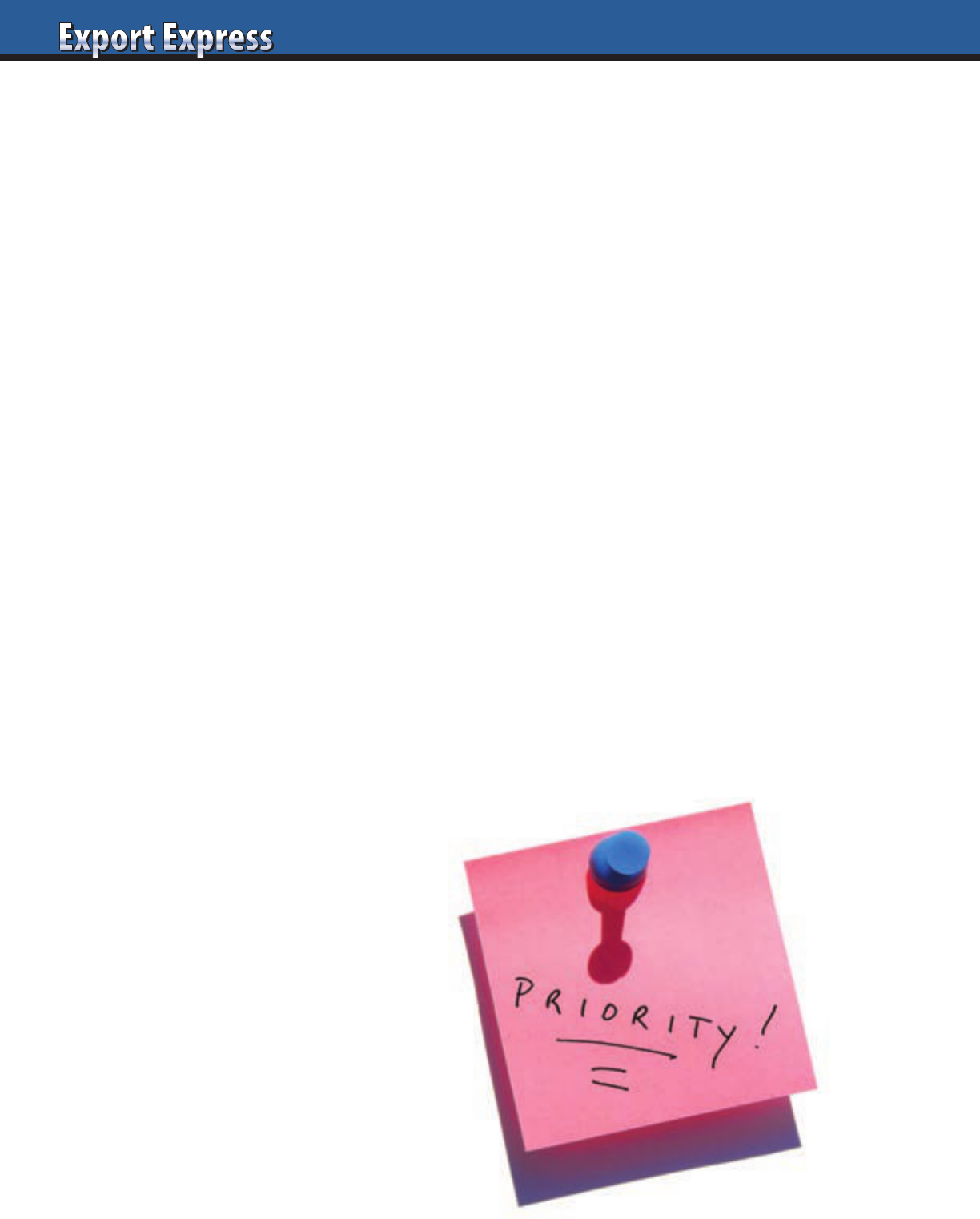
1. Quarterly MBO Meeting
with Distributor Senior Management
One of the most effective tools
for increased focus is to create a
regular process for Distributor senior
management engagement in your
business. The Management By Objective
(MBO) system (or similar approaches)
allows you to meet quarterly on a pre-
planned schedule to review past quarter
performance on key initiatives and firm
up plans and commitment for the new
quarter. Discussions should focus on key
business metrics and account specific
results. Meetings can be held via
teleconference if you can not visit
personally 4 times per year.
2. International Distributor
Network Conference
This can include all your global
distributors or those from a specific
continent/region. Program can be 1-2 days
in length and can include Corporate
Business Review, New Product Roll-Out,
and requirement that each distributor give
a presentation on a success story from their
home market. Meeting location can tie in
with a major trade fair such as SIAL or
FMI to reduce expenses. Alternatively,
the meeting can also be in a resort location
to serve as an incentive. Export Solutions
is available as a conference meeting
speaker to discuss a variety of distributor
optimization strategies and retail trends.
3. Sales Contests
Sales contests bring energy, excitement,
and focus to your brands. Sales contests
should be about six weeks in duration
and offer the opportunity for “everyone”
to win. Prizes can range from cash
incentives to trips to merchandise for
the winners. Sync contest objectives and
measures to your key initiatives for your
peak season or a new product launch.
4. Key Account Business Reviews
It is appropriate to conduct key
account business reviews with each of
the distributor’s top 3-5 accounts once per
year. Meetings should include senior level
management of the retailer. This strategy
requires distributor analysis of the
accounts business and opportunities for
mutual growth. This also provides you
with an avenue to develop a personal
relationship with local customers.
5. Retail Audit
Retail execution is critical to the success
of any brand initiative. An important
element in a new product launch or
preparation for your peak selling season
is the pre-scheduled Retail Audit across
a market. The Manufacturer would bring
2 or 3 people from their company and
match them with distributor personnel
for a day in the field checking retail
conditions. In one day, the 2-3 teams
can see 30-50 stores in the market to judge
the markets “readiness” and progress.
Distributor personnel are competitive and
will work hard to make the market “look
good” for the Retail Audit.
6. Plant Visit
Invite your distributors for a plant
visit and/or a trip to your corporate
headquarters. Distributor can be
introduced to members of your senior
management team. Distributors should
be encouraged to bring a large customer
as well. This type of trip can serve as
a “bonding” experience and create
a renewed sense of commitment to
your business.
7. Bonus Payment
Incentive pay for performance usually
works well with sales teams. Sync
bonus with your key objectives. Reward
performance on achievement of retail
distribution, profitability, as well as sales
volume objectives. Volume based objectives
alone may encourage questionable
shipments that could be diverted.
8. Distributor Sales Meeting Participation
Most distributors schedule monthly or
quarterly meetings for their entire sales
team. This is a primary format for the
distributor to communicate direction and
priorities. Most distributors allow their
manufacturers to make a presentation on
a new item or key sales drive. Supplement
your meeting presentation with a small
gift for all meeting participants such as
a pen, key chain, or calculator with your
company logo.
9. CEO Market Visit
Distributors appreciate a visit from your
CEO or other member of your senior
management team (CFO, VP International
etc.). This gives them the opportunity to
demonstrate their results and share their
input on the markets development. It is
magical to watch certain market issues
get “solved” immediately prior to a senior
management visit!
10. Share Best Practices
Create a process for sharing best practices
and success stories within your global
distributor network. These can be
communicated via a monthly newsletter
or email. Distributors are proud to share
their achievements or innovative new
strategies that they are using to build
their business. Manufacturers may elect
to reward distributors with the “best
success story” each month with a “free
dinner” or other incentive.
Ten Tips – Increased Distributor Focus on Your Brands
24
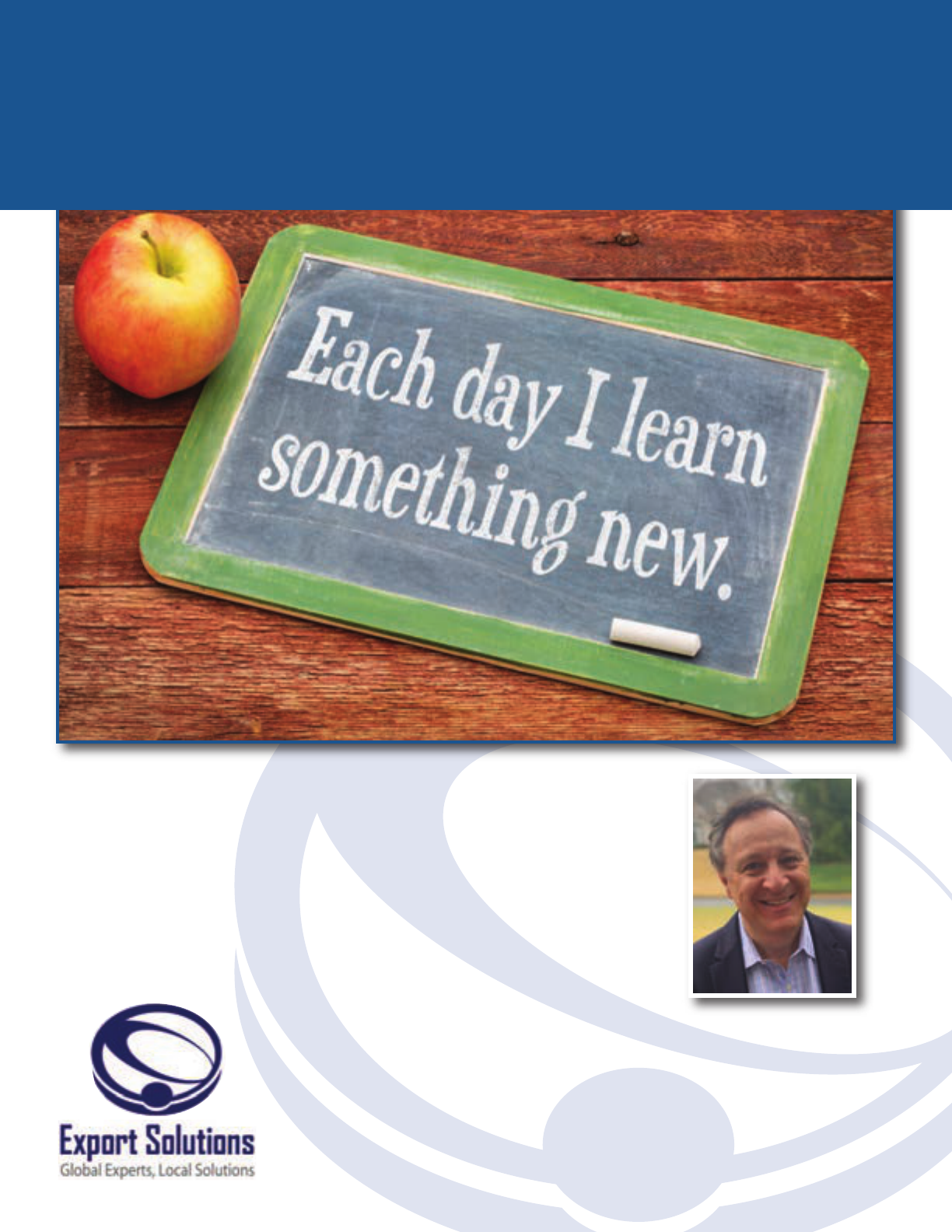
Export Workshops & Speeches
by Greg Seminara
Export Workshops & Speeches
by Greg Seminara
Export Workshop Overview
• On-site and web options available
• 8 Export Development & Distributor Management Modules
• Includes 25 Common Export Problems group work
• 200+ topics available for tailored workshop
• One hour keynote or motivational speech
Contact Greg Seminara for
more details and references:
gseminara@exportsolutions.com.
25
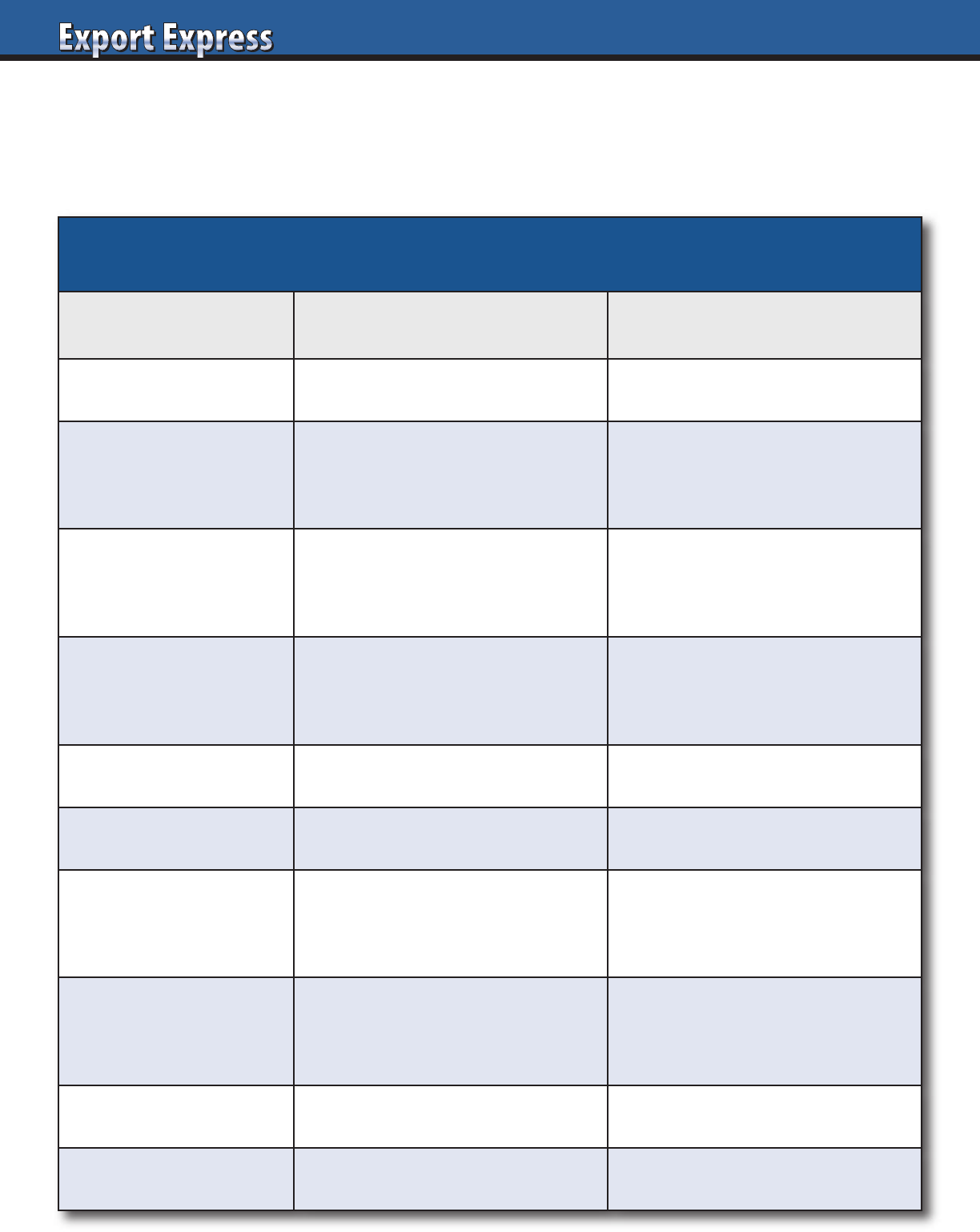
26
Buyers: New Product Assessment
High Interest Low Interest
Category Opportunity Large or high growth Declining or niche
Brand Owner
Multinational or proven local.
Category expert
New foreign supplier
or start-up
Innovation
Something new, supported
by consumer research
“Me too” product
Profit Margin
Enhance current
category margin
Equal to or less than
current category margin
Sales Generates incremental sales Cannibalizes existing sales
Marketing Investment Sampling, social media, PR None
Trade Programs Invests in retailer “push” programs Periodic discounts/rebates
Brand Track Record Successful at other local retailers Unproven in the country
Terms/Conditions Attractive deal structure Typical terms/conditions
Representation Dependable local distributor Small, niche entrepreneur
Retail buyers are challenged to maximize profits and sales from every available inch of shelf space. Every new item accepted must
improve on the performance of the brand currently occupying that space. Buyers are overwhelmed by new product offerings, all with
ambitious promises. Improve your chances of success by incorporating Export Solutions’ 10 point check list on how to excite your
category buyer about your new product.
How to Excite Buyers – New Product Checklist
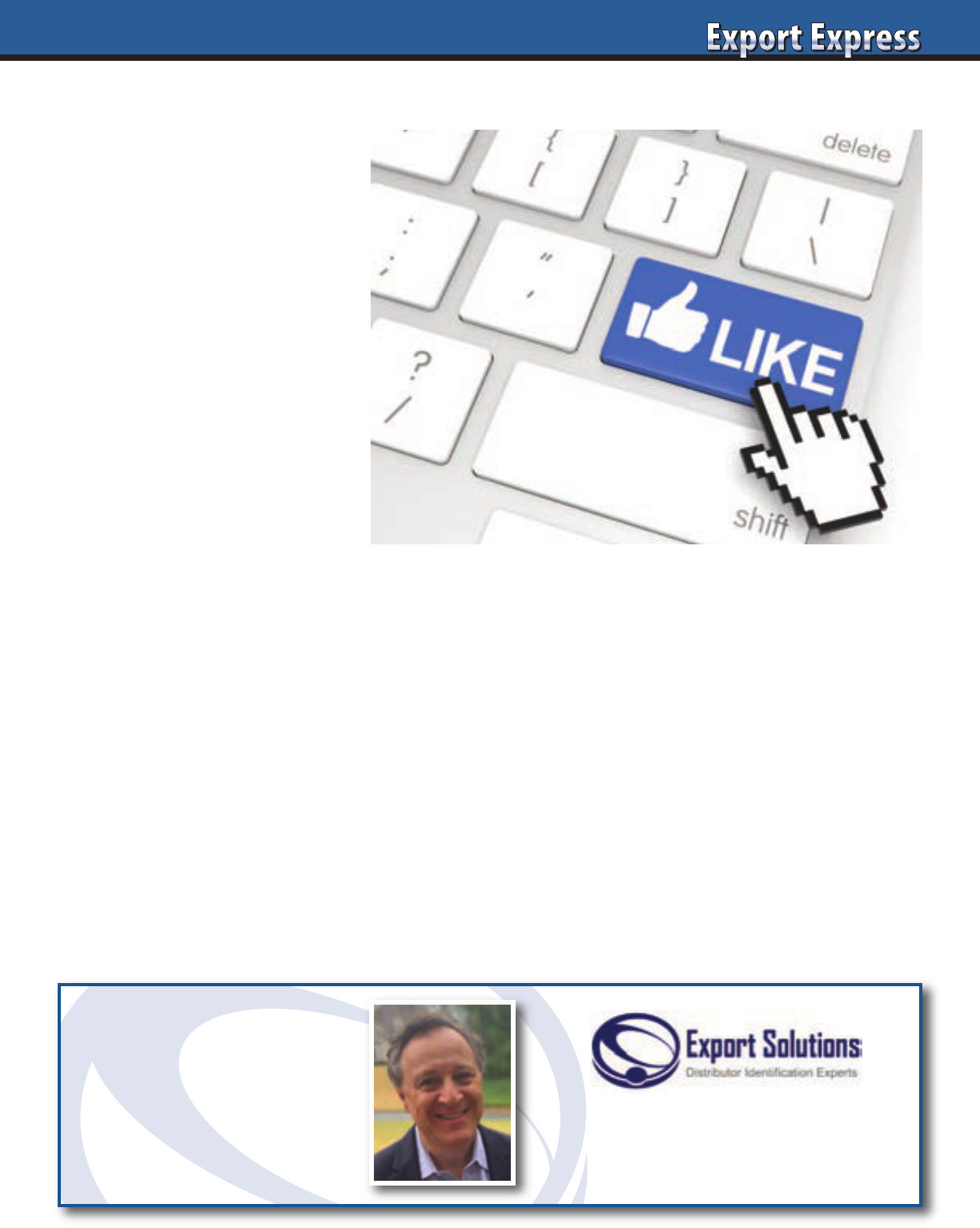
27
1. Respect For Their Right
to Make a Reasonable Profit
Distributors have profit targets just like
manufacturers do. Distributors measure
total supplier contribution, defined by
sales multiplied by gross margin. How
much value do you receive from your
distributors relative to your contribution
to their profits?
2. Investment in Brand Support
Distributors love companies that
invest in above the line activities
such as television advertising, radio,
social media, print, and sampling.
Distributor volume is proportional
to your investment in brand support
activities. More marketing dollars
usually translates to greater sales
and profits for the distributor.
3. Awards
Most distributors proudly display
their Distributor of the Year awards in
their office lobby or executive conference
room. Recognition can be given for
distributor of the year, or achievement
of $1 million in sales, most improved
store conditions, or ten years of service.
4. Market Visits (But Not Too Often)
Periodic market visits allow you to
share ideas, monitor progress, and
discuss issues. These trips serve as
motivational, relationship building
events, particularly if you can spend
time together “out of the office.”
5. Endorsement of Local Marketing Events
Best in Class partners maintain the ability
to create unique local programs to build
your brand. Voting with your marketing
dollars stimulates the team to deliver and
continue to bring you their best ideas.
6. Trip Contests – Quota Makers Club
Many believe that achieving your annual
target is a job standard. This is true, but
watch distributors ship cases like crazy
when trying to qualify for a trip to a
resort location! Plus, the trip generates
incredible goodwill and all vow to meet
their objective to return “next year.”
7. Market Research
Distributors aspire to appear as category
experts. Access to syndicated data
from Nielsen plus local consumer
research allows them to distinguish
themselves from other vendors armed
with hollow words and broad claims on
a PowerPoint presentation.
8. Invitation to Your Corporate Headquarters
A trip to the USA or Europe is a dream
come true for distributor brand managers
in emerging markets. Treat them like a
VIP, and they will be loyal forever.
9. Lunch for the Support Staff
Order processing, customer service,
and other administrative people form
the hidden backbone of the distributors
team. Buy the group lunch and you can
be a hero for $100-$200. Guess whose
orders will be handled first at the end
of a quarter?
10. Letter of Thanks
Our industry depends on email
too much. How do you communicate
sincere thanks when someone receives
200 emails a day? Send a personal
letter via the post office recognizing a
successful new product launch, creative
promotion,or above and beyond effort.
Extra points provided for a handwritten
note! These letters are treasured forever.
Ten Things That Distributors Like
Talk to an Expert
• Find Distributors in 96 Countries
• International Strategy Road Map
• Fix Problem Markets
• Next Level Sales Management
• Export Workshops
• Motivational Meeting Speaker
Contact Greg Seminara at (001)-404-255-8387 to
discuss your business development project.
www.exportsolutions.com
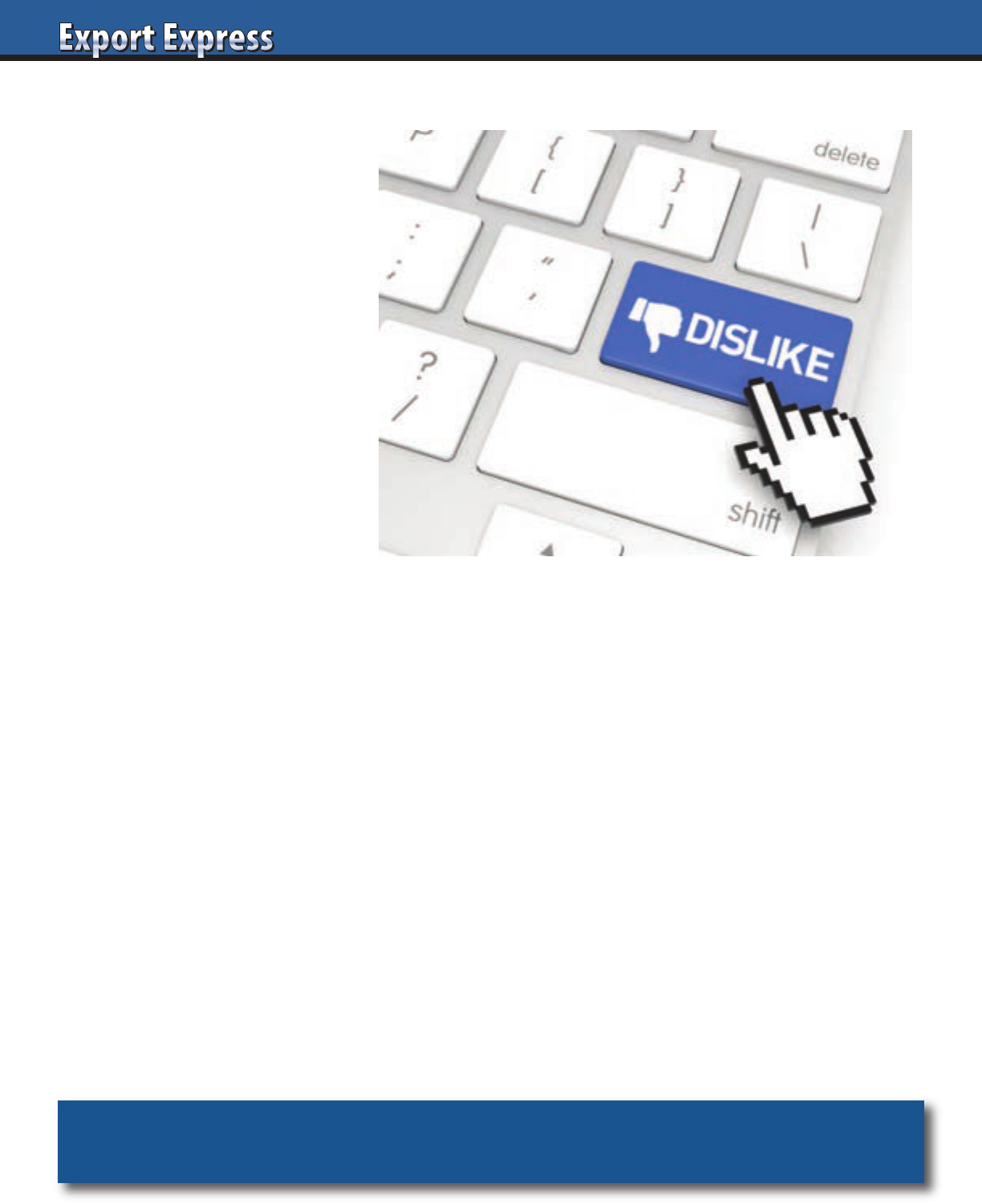
28
1. Unrealistic Expectations
Category growth ranges from 1% to 5%
in most Western countries. So how can
a manufacturer demand a 10% increase
in sales in a mature market? It’s possible
if the brand plans a major increase in
marketing spending. However, normally,
business growth parallels overall
market conditions.
2. Direct Contact With Their Assigned Retailers
Tricky retailers attempt to bypass a
distributor by contacting the brand
owner. Normally, the retailer has his
hand out for more money or wants to
“buy direct.” Be polite, but ask the buyer
to work with the distributor or schedule
a joint meeting for your next visit.
3. Cut Marketing Budgets
Leading distributors depend on joint
business plans, often created up to
one year in advance. Last minute
squeezes, translating to budget cutbacks
sometimes need to happen, but still hurt.
The distributor is left with delivering the
bad news and also hitting the sales target,
even with reduced support.
4. Short Shipments
Everyone loses due to short shipments.
Distributors could be assessed penalties
by retailers. Store level shelf space may
be lost and need to be recaptured. Keep
the pipeline filled, particularly during
peak seasonality.
5. Price Increases
Rising raw material input costs may
require adjustments in list prices. The
reality is that price increases are brutal to
implement in many countries. Eventually,
they are incorporated after months of
stand-off’s. In many cases, distributors
are forced to accept the price increase
from the brand, but are forced to swallow
the increase until they can negotiate with
the retailers.
6. Endless Reporting
Some brands are guilty of a constant
stream of reporting requests that take
time to complete. Ask: Is the report
really necessary? Legitimate requests are
forecasts, shipment results, major retailer
listing maps, price surveys, and new
product launch status updates.
7. Frequent Market Visits
Your partners require time to accomplish
their objectives without constant
oversight. Distributors appreciate short,
productive visits on a quarterly basis.
More frequently for a big company
and less often for a small brand. Get in,
conduct your business and off to the next
country. Week long visits to small markets
represent a distraction.
8. Margin Reductions
Distributors depend on their margin to
cover fixed overheads like logistics and
cost of their sales team. Often, their net
margin is only 3-5% or lower. Margin
reductions or increased costs challenge
their ability to operate a financially
healthy business.
9. Last Minute Requests
End of the year volume pushes and
rush orders are part of the business.
However, everything functions better
when normal lead times are respected.
Separate “must do” demands from
“nice to have” requests.
10. Delayed Response to Local Ideas
Manufacturers encourage distributors
to create unique local approaches to
brand building. Retailer buyers also
call their favorite distributors with short
term promotional opportunities to
participate in a special event. Distributors
need quick decisions on your ability to
support their idea. Few things are more
frustrating for a distributor than a
lengthy wait while their proposal is
debated by numerous levels of your
company management.
Ten Things Distributors Don’t Like
Need a hand? Visit www.exportsolutions.com.
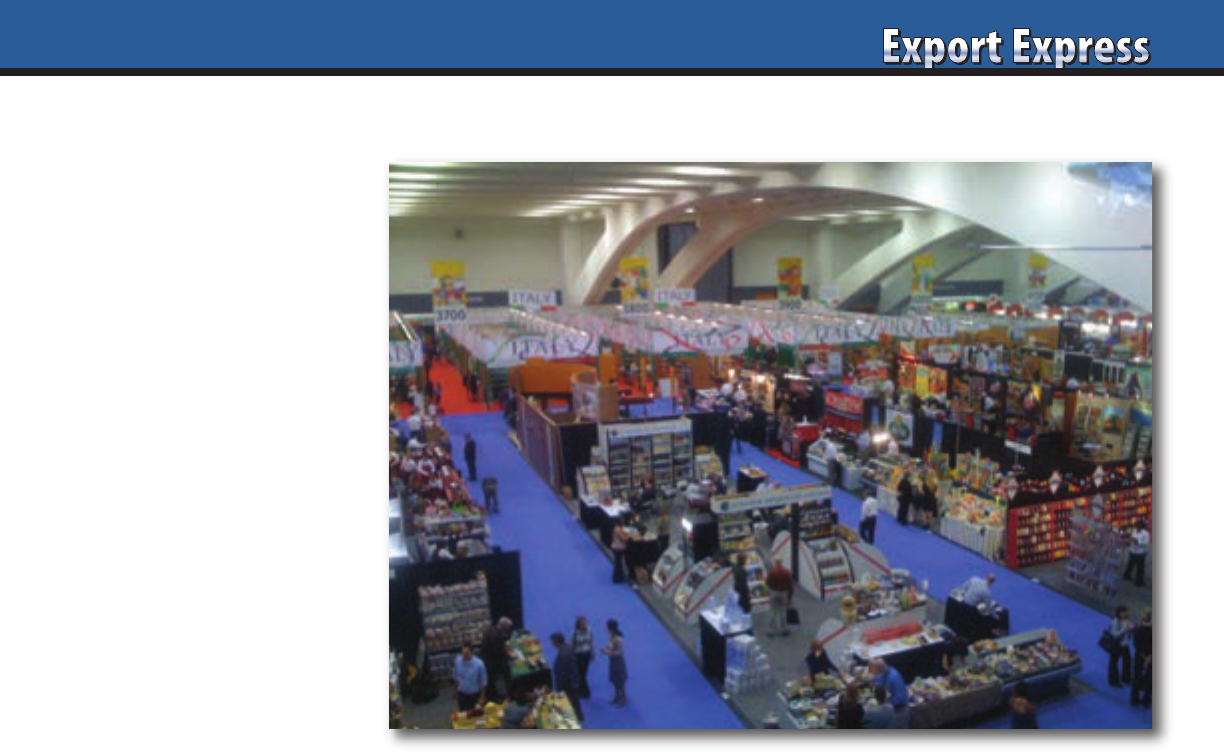
29
Everyone loves a trade show.
Where else can you rent a booth
and witness lines of customers
and distributors waiting to see
you to talk about your brands?
Trade shows represent sizable
investments and valuable booth
time can be wasted with non-
productive meetings.
Read our Ten Tips to maximize
your trade show productivity.
1. Create Sign:
Distributors/Customers Wanted
List countries where you are
searching for a distributor or
retailer partner. This serves as
an invitation to distributors from
those countries to stop by. This
strategy also acts as a deterrent
to discourage distributors from
visiting from countries where
you already have a partner or
maintain limited interest.
2. Use Export Solutions Database
to Pre-Screen Distributors
Over 3,000 companies have used our proprietary database
to find qualified distributors. Quickly. A common technique
is for distributors to list the countries where they hope to expand
one month in advance of a major trade show. They then use the
Export Solutions’ database to pre-screen candidates and identify
the five candidates per country with the highest potential.
Then, they email these distributors in advance of the trade fair
to request a meeting. This approach works better than sitting
at your booth with a “hope and wait” strategy to meet
qualified distributors.
3. Create a Template to Recap Capabilities of Potential Distributors
Request that prospective distributors complete the template
in advance of a meeting. Think of the template as a distributor
CV or resume. How long has the distributor candidate been in
business, sales, employees, key brands, length of service for key
brands, and most importantly references from other brand
owners and in country retailers.
4. Prepare a One Page Recap of your Company Credentials
This should include product “beauty shot,” current export
countries, and unique product characteristics. List export
manager contacts and a photo on the back with a space for
notes. Professionally print this on a one glossy page handout.
This will serve as an important reminder for the meeting when
the retailer or distributor returns home with hundreds of
business cards.
5. Participate in Show Sponsored Matchmaking Events
Most trade fairs organize matchmaking events. The formats
can vary, but basically they can arrange meetings with interested
buyers or distributors. As always there is a mix of good meetings
and bad, but the approach is worth consideration.
6. Take Photos of Potential Distributor Candidates
First take a picture of the distributors business card. Then take
a photo of the potential new distributor. After hundreds of short
meetings, this will help you remember the candidate once you
begin serious due diligence after the trade show.
7. Bring at least 500 Business Cards
I am serious. We have all run out of cards at a trade show. Better
yet, bring 1000 business cards.
8. Schedule a Group Event for Current Distributors
This event is an efficient way to launch a new product or
announce “Distributor of the Year.” You must schedule the event
before or after show opening times. Best bet is a breakfast or a
dinner, if you schedule it four months in advance to avoid
conflicts with other events.
9. Get to the Show Early and Leave Late
As a trade show visitor, it is normally much easier to reach senior
decision makers of a supplier before 10:00 am or after 4:00 pm.
They are often less distracted and have more time to spend with
you. Similarly, Brand Owners are always more accessible on
Sunday of a trade show or the last day. Normally, the retail
buyers don’t attend trade shows on the weekends or “last day”
of the trade show.
10. Create a Trade Show Exhibit Planner
Trade Shows post a listing of all exhibitors on their web site
in advance of the show. Many also have a routing software that
will allow you to add exhibitors of interest to your private list and
plot a route based upon your selected exhibitors. Exhibitors that
maximize trade shows schedule most of their meetings in advance.
Ten Tips – Maximizing Trade Show Productivity
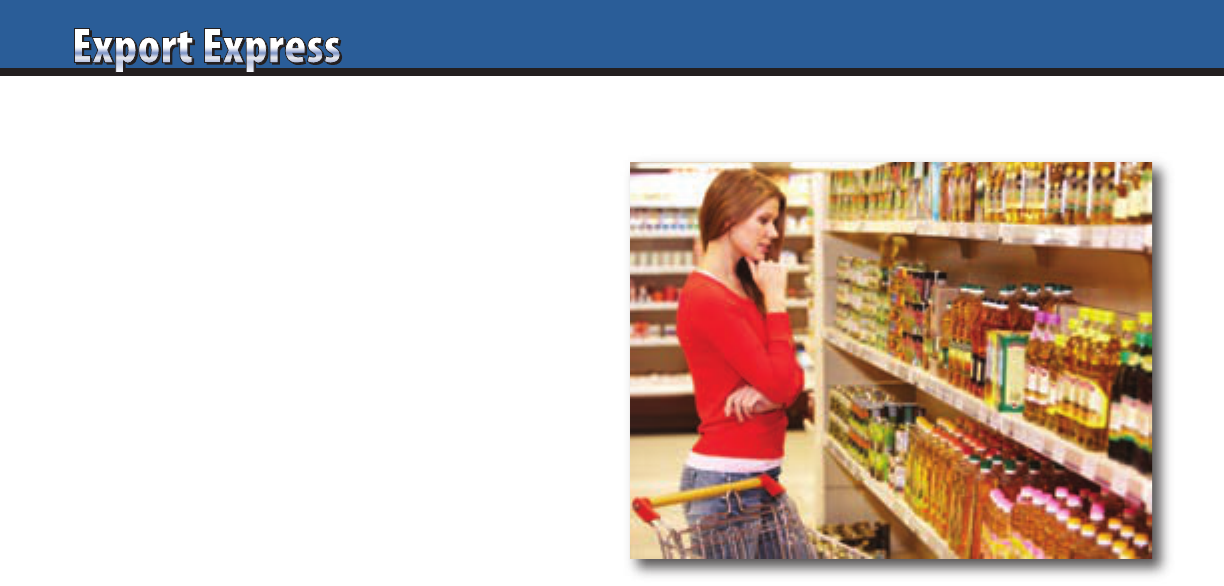
30
Retail stores serve as showcases for our products. This is
the point of sale where inventory is translated to a consumer
purchase. However, many manufacturers spend the bulk of
their energy against securing the headquarter listings, chasing
shipments, while store conditions flounder at the middle of
the priority list.
Increased focus on in-store conditions is critical because it
delivers benefits every single day. Listed below are Export
Solutions’ tips for winning the battle at the retail shelf.
1. Define and Publicize Your Shelf Objectives
The first step is to insure that each member of your sales team
is “crystal clear” on your brands in-store objectives. Create a
shelf conditions standards book, including photos that can be
distributed or shared online. I’ll always remember a store visit
in Cordoba, Argentina when I was a manager for Clorox. The
distributor representative proudly brought me to his “best” store.
The store was not bad, but below objective because our brand
only owned 50% of shelf space versus our 65% market share.
When I mentioned my disappointment, the representative
accurately claimed that “no one had ever shared” this shelf
objective with him before.
2. Create an Objective Mechanism to Evaluate Every Store
How did your brand look in the last store visited? Was it
an “A,B,C, D, E, or an F?” Why? Establishment of a grading
system allows you to provide an objective report card for each
store. Normally, a system of awarding points for share of shelf
space, retail availability, and off-shelf merchandising is simple
to execute.
3. Focus on Basics: Distribution, Availability, Shelf Space,
Shelf Position, and Off-Shelf Merchandising
All authorized brand sizes should be tagged and in stock. Brand
should maintain share of category space equivalent to or greater
than market share and placed next to the targeted competitor.
Incremental points should be awarded for off-shelf displays or
secondary locations. Fair pricing is also important, but normally
tightly controlled by central buying.
4. Establish a Baseline for Store Conditions
Introducing new store conditions tracking metrics can be a
shock to your retail sales team, as existing conditions are likely
far below minimum acceptable standards. The idea is to create
a baseline of performance and measure monthly or quarterly
progress towards objective.
5. A Market Wide Retail Audit Creates an Accurate Benchmark
This requires the participation of 2-4 people (depending on
market size) from your company matched by an equivalent
number of people from your distributor/retail sales team. Each
two person team is committed to spend a full day at retail and
is assigned a certain city or section of town. Teams can usually
visit 10-15 stores per day giving you a broad spectrum of results
across the market. Each store should be measured by the same
criteria. Ideally, the entire group should meet at the end of the
day to share observations and next steps. Audits can be tied into
a major sales drive such as a new item rollout, peak seasonality,
etc. A good distributor will work hard to fix problems in advance
of a previously scheduled market wide retail audit.
6. Sponsor a Retail Sales Contest
This retail contest can be tied to the launch of new retail sales
objectives or a “grading” system. Structure the contest for
maximum number of winners. Reward most improved from
a pre-contest baseline. Contest should be one-two months in
duration to optimize excitement and focus. Get creative with a
theme such as “A Room with a View” with first prize being an
overnight stay at a 5 star hotel room with a view for the sales
representatives stores have the best “view” for your brand.
7. Retailers Schematic/Planogram Serves as the Official Record
Request that each distributor forward the planogram for each
of the 2-4 largest retailers for each market. Reward key account
sales people for implementing changes in the official planogram.
8. Provide at Least One Shelf Objective for Every Month
A monthly objective for your brand or company forces the retail
team to look at your brand on every store visit. The objective
can be oriented against moving your brand to an eye level shelf,
improved shelf space allocation for a particular size/flavor, or
against reduced out of stocks. Track the objective with a question
that can be answered by “yes/no” or a numeric response. This
will allow you to participate with software on handheld retail
reporting devices.
9. Focus Against Accounts With Problems With Retail Execution
My experience tells me that some retailers are better at
maintaining attractive category showcases and in stock conditions.
Other high volume hypermarkets are plagued by frequent “wiped
out” categories. Certain accounts prevent representatives from
touching the shelf due to union policy. Persistent out of stocks
may reflect insufficient shelf space, low warehouse inventory,
or problems with automatic replenishment systems.
10. Visit Stores on Every Trip to the Market
Schedule time to work with the retail sales manager. Your
attention to store conditions will linger after your plane departs.
“Retail is detail” and the “distributor respects what the brand
owner inspects” are well known comments on retail. Send a
signal that you are focused on your retail showcase and watch
your brand presence improve!
Ten Tips – Winning the Battle for Retail Shelf Space
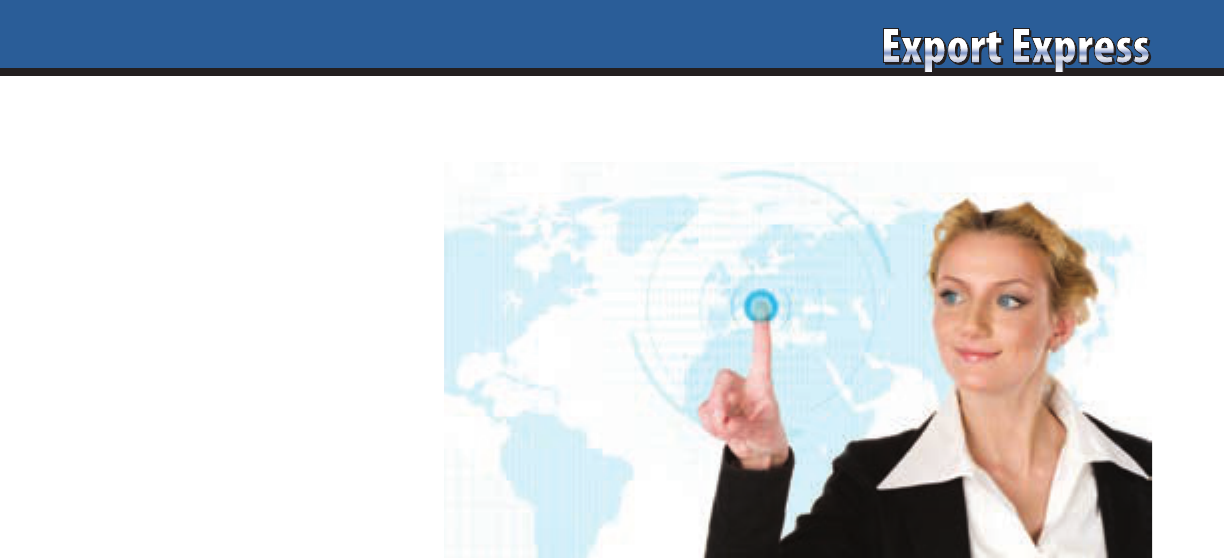
31
There are 196 countries in the world.
How many is your company selling to?
International expansion to new countries
is a strategic imperative for most
exporters. The challenge is to determine
which countries will deliver the greatest
financial return for your investment of
time and resources. Listed below are
some practical considerations for
determining where to sell next.
Determine Category Size: Data exists
to allow you to capture the size of your
category in target countries. Syndicated
data suppliers such as A.C. Nielsen
and Euromonitor sell category sales
information and trends. Government
agencies track sales for core categories
impacting their local producers. Category
size may be estimated by sourcing the
information from a friendly retailer and
projecting country level sales based upon
that retailer’s market share.
Population: Just One Factor: A logical
conclusion would translate that large
countries like China and India would
represent the greatest opportunity.
Population levels are relevant, but not
the only factor. A classic case study is the
story of Brazil and Puerto Rico. Most USA
based consumer goods manufacturers
sell more product to Puerto Rico, a
commonwealth of 3.3 million people than
to Brazil, a country of 216 million people.
GDP: Follow the Money: Per capita,
gross domestic product (GDP) is an
important consideration. International
exporters are known for marketing
premium, value-added brands. The
higher the countries purchasing power,
the more likely that middle income
citizen’s can afford our brands. This
appears as one reason that European
markets such as Germany, France, Italy,
& the United Kingdom may create a
larger opportunity than countries such
as Pakistan, Indonesia, or Bangladesh
that have far more people.
Growth Rates: Think to the Future:
Export development often represents
an investment for the long term. Your
country prioritization analysis should
look at population and GDP growth
rates. I worked in Saudi Arabia in the
early 90’s when the population was
around 14 million, but growing at 8%.
Today, Saudi Arabia’s population is more
than 36 million. Which countries will be
the largest in 2025 versus 2022?
Proximity to Manufacturing Plants:
Transportation costs contribute one of
the largest line items in your pricing
calculation. Logically, shipping to a
neighboring country is likely to cost
less than shipping half way across to the
world. Citizens of adjacent countries have
probably visited your country and may
have seen your brand or a commercial for
it. Canada occupies the northern border
of the USA and is the single largest export
market for USA consumer goods
manufacturers ( and vice versa).
Extend Current Retailer/Distributor
Partnerships: Global retailers such as
Carrefour, Metro, Walmart, and Tesco
operate in many countries (and continents.)
Asian and Europe feature regional
distributors. Your brand has established
a track record with these leading players.
Your company is already proficient at
working with their operating models.
Leverage these relationships to enter
new markets. Warning: this can be a risky
strategy when you base your plan on a
large global retailer that happens to have
a small presence in your target market.
Examples: Aldi-USA, Whole-Foods UK,
or Walmart-Argentina.
Cost to Enter: There is a cost of doing
business in each market. Markets such as
Italy and Hong Kong maintain notoriously
high cost of entry into the supermarket
channel. Latin American/Asian markets
require investment, but at more modest
levels relative to Europe or the USA.
Market Complexity: How difficult will it
be to enter the market? Certain markets
are consolidated with a few major retailers
and many qualified distributors. Other
markets are complicated, with multiple
trade channels, fragmented retail
environment, and a disparity in usage
profiles for your category. Larger markets
are challenging to enter. However, a
5% market share in a large country may
deliver greater long term dividends than
a 50% market share in a small country.
Competitive Environment – Get Ready
for Battle: Evaluation of the competitive
landscape in your target market is critical.
Does the market represent virgin territory?
Or will you face 2-3 major, multinational
competitors? In competitive markets,
existing market combatants will typically
spend heavily to defend their brand
position to blunt a competitive
introduction. It is likely that you face
competition in every market. However,
it is important to calibrate the existing
competitive environment.
Availability of Enthusiastic Local Partner:
Selection of a qualified, local partner is
another key factor. Strong distributors
and importers exist in every market.
Pro-active contact from a leading
distributor indicates that this market
expert sees potential in your product.
This is favorable and may encourage you
to prioritize this type of market. However,
you must conduct due diligence to insure
that this enthusiastic distributor (that you
meet at a trade fair) maintains the critical
mass and skill set required to succeed in
building your brand.
These factors all play an important role in
determining the “Size of the Prize” in new
markets. Veteran exporters will weigh each
factor to establish the right path forward
for their export development plan.
New Country Expansion Prioritization
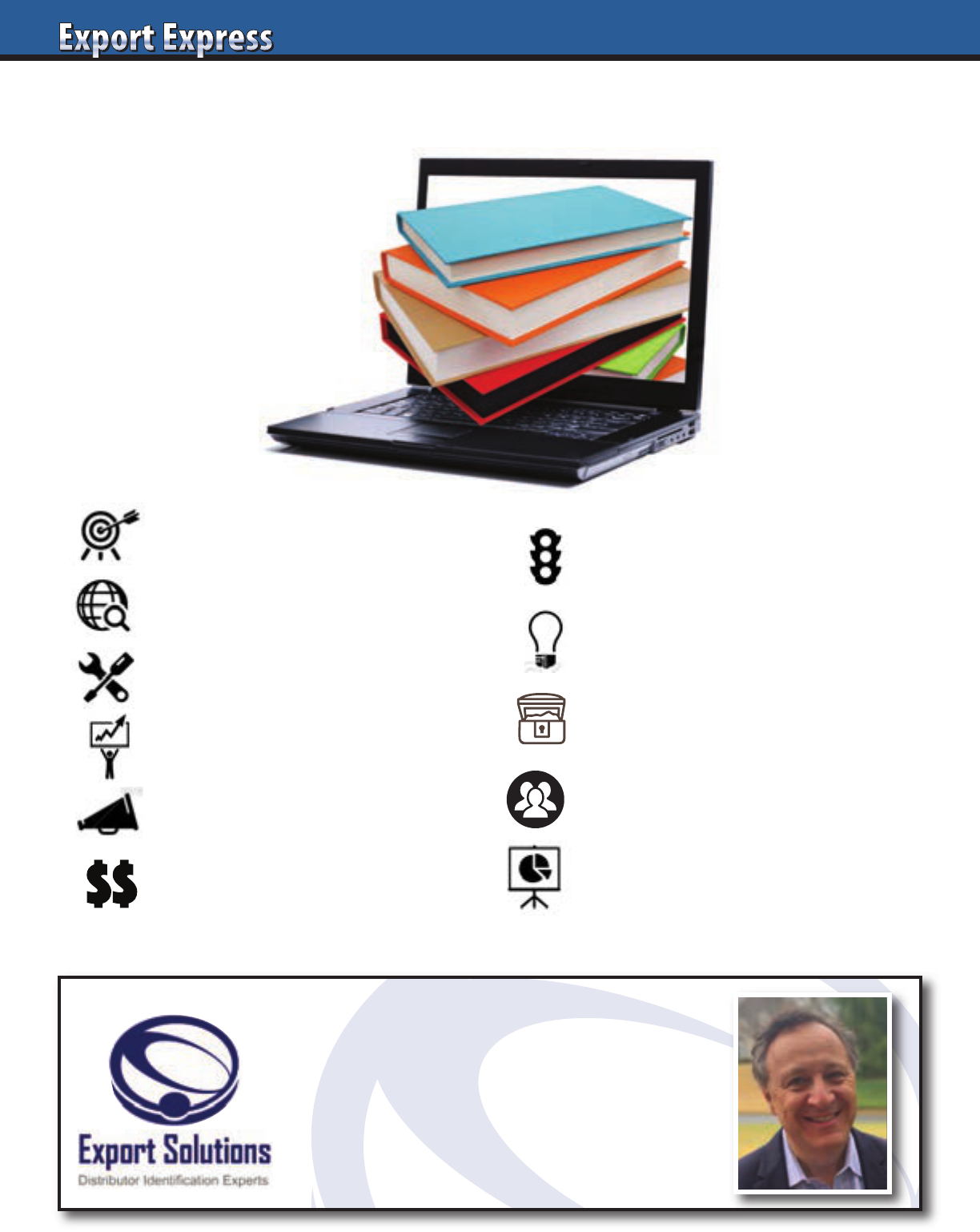
32
Create Your Own Export Library
Looking for a fresh point of view for your
next event or training workshop?
Contact Greg Seminara at
greg@exportsolutions.com
All guides available free at www.exportsolutions.com.
Export Strategy Guide
Distributor Search Guide
Export Handbook
Selling to USA Handbook
Distributor Management Guide
Finance & Logistics
300 Tips for
Export Managers
Idea Guide:
New World – New Business
Export Treasure Chest
My Favorite Templates & Forms
People Power
Strong Teams Build Great Brands
New Distributor
Cooperation Model
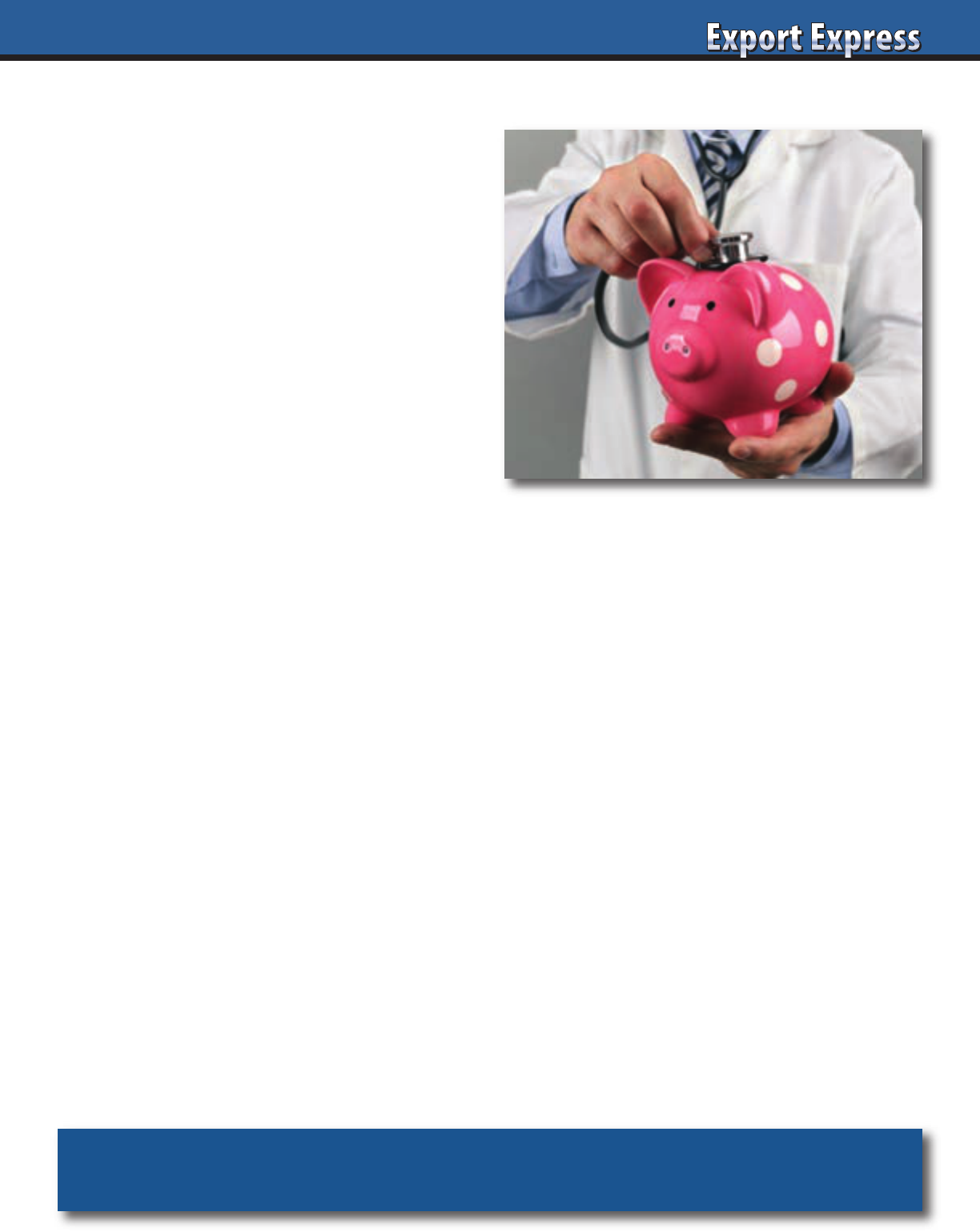
Export managers rarely think about how much money a
distributor is making from representing their company. Big
mistake! How often do you think about your own salary? How
do you feel when you get a raise? Or no bonus or a reduction of
salary? Most distributors are family owned operations, relying
on net profit margins in the 3-5 percent range. Distributors make
money on scale, always looking to attract companies with
existing sales versus pioneering risky new product ventures.
1. Calculate how much revenue your distributor sources from
representing your company.
A quick estimate can be generated from net sales multiplied
by the distributor margin.
2. What is the work required to build your brand?
How much of the distributor’s resources will you need to achieve
your mutual objectives? Is your brand a tough sale, or growing a
popular item? Dedicated brand manager or shared?
3. How much complexity is involved with your business?
Number of items in your product portfolio? Shelf life?
Temperature control logistics? Highly competitive category
or “niche?” Every day low price or frequent promotions?
Average order size? How much help (pressure!) from
manufacturer? Marketing budget? These inputs directly
impact distributor profitability.
4. Distributor margin is the first place where they generate income!
Distributor executives receive salaries and “owner-operator”
benefits like travel, cars, and jobs for family members. Country
level price calculations are usually based upon the most
expensive customer. A distributor gains income when other
customers do not receive similar discounts and rebates.
5. All distributor margins are not equal!
The key is to examine “what’s included.” Some margins appear
high, but could include periodic trade price promotions. Others
margins may be lower on the surface, but then allocate separate
line item add-ons for logistics, administrative overhead, or
distributor profit margin.
6. Pioneering is extremely difficult!
It may take one year from the time of your first discussion
with a distributor to the time he receives trade payment for his
first shipment. Normally, a distributor must allocate his team
resources for up to a year, with hope for a long term payout. This
is a difficult gamble. Manufacturers must remember this fact, and
understand when distributors refuse to partner with a company
with no existing sales.
7. Marketing investment drives distributor Income.
Funding required consumer and trade marketing investments
stimulates sales. Higher sales generally translates to higher
distributor profit. No investment leads to marginal sales and
lower distributor revenue.
8. Price increases: tough to execute, but pay raise for distributor
Customers are reluctant to accept price increases, because
they hate to raise prices to the consumer. However, currency
fluctuations and raw material prices force manufacturers to take
price increases. Many distributors are very open to a timely,
competitive price increase. Higher invoiced case costs deliver
greater returns at a consistent margin, except if volume suffers.
9. Consider direct talks on margin and compensation
Most employees enjoy an annual performance and salary review.
Many distributors would welcome a review of compensation
trends. This would include sales, resource allocation, currency
fluctuation, trade payment and competitive activity.
10. Open dialogue on alternate financial models
A company with critical mass may operate on an “open book,”
cost plus model with a distributor. A large brand may benefit
from margin rebates when certain volume thresholds are met.
Another approach involves manufacturer funding of a dedicated
“team within a team” at a distributor. For a small brand or new
entry, consider a monthly retainer fee to cover six month start-up
period. Another is an incentive program which rewards the
distributor for achieving volume targets.
11. Helpers are heroes!
Many distributors literally write the check for your invoice
from their own funds. Frequently it is difficult for small-mid size
distributors to dictate payment terms to multinational retailers.
This forces distributors to swallow price increases, extra retailer
fee demands, currency impact, etc. Large brand owners that
serve as caring partners that “help” will be rewarded with a
healthier distributor and more focus on their priorities from
an appreciative distributor.
Ten Tips: Distributors Need to Make Money Too!
Need a hand? Visit www.exportsolutions.com.
33
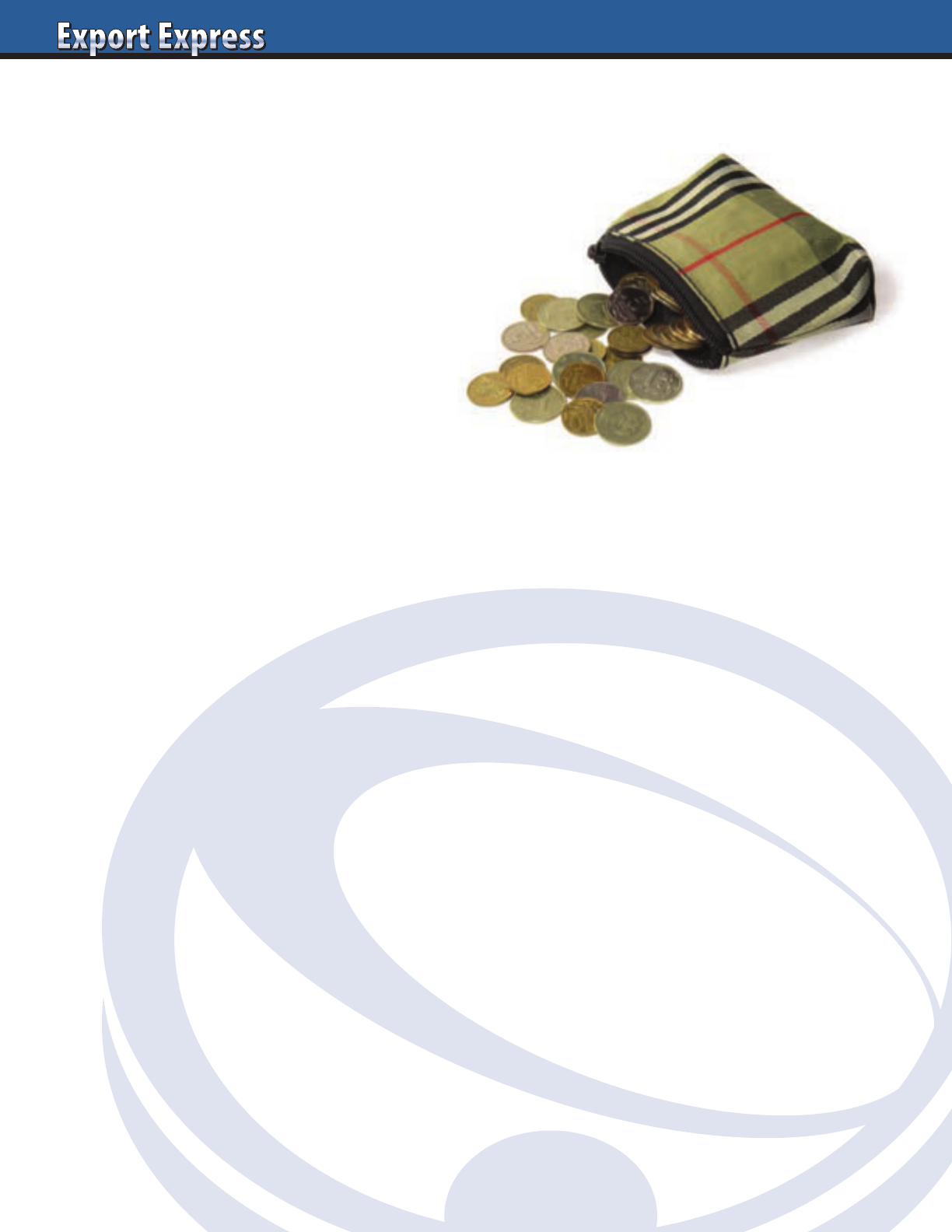
34
Stretching thin marketing budgets is a job
requirement for most Export Managers.
Listed below are “Ten Tips” for brand
building on a “Shoestring Budget.”
1. Tap into Government Export Programs
Many countries sponsor strong trade
organizations that can aid your export
development program. Exports translate
to jobs and most countries have well
established programs to facilitate the
sale of locally produced products. For
example, the USA Foreign Agricultural
Service will co-fund marketing
investments for small-mid size USA food
producers through their MAP programs.
German Sweets and GEFA, UBI France,
ICE (Italy), ICEX (Spain), Austrade
(Australia), and AG Canada serve as
valuable resources for local exporters.
These organizations often sponsor local
“Food Events” at leading supermarkets
in international countries. For example,
Austrade sponsored G’Day USA to
showcase Australian food producers to
USA consumers. These events are highly
publicized and normally feature a
relatively modest participation fee.
2. Leverage Relationships
with Global Retailers
Wal*Mart, Carrefour, Tesco & Costco all
maintain programs to ease the export
process for their current suppliers. This
usually involves direct consolidated
shipments with other local producers,
labeling assistance, and placement in a
special section in the international aisle of
their stores i.e. USA Foods, France Foods,
UK Foods etc. The immediate benefit is
the streamlined route to market without
payment of upfront local marketing fees.
This allows you to “Test the Market” prior
to a traditional market entry with a local
distributor and heavy marketing support.
3. Joint Venture with Local Manufacturer
Another idea is to locate a local player
in your category in a country targeted
for expansion. You may be able to offer
a potential partner innovation in
taste/flavor or packaging to complement
his local expertise. A joint venture or Co-
Branding agreement can produce revenues
without significant start-up funds.
4. Build Marketing Costs
into Distributor Margin
Many manufacturers build an accrual fund
into their distributor margin calculation.
Normally the
funding level
is around 10%
of sales, but
can range from
5 -20% depending
on the category.
This creates a
fund for the
local distributor
to manage. The
accrual fund
is created on
a “pay as you
go” basis, with
fund levels
proportionate
to shipments. In
this scenario, the
manufacturer
usually provides
a small fixed sum to create a launch
budget prior to initial shipments.
5. Free Goods May Fund Trade Marketing
Free goods may be used to offset the cost
of trade marketing programs, particularly
for established brands. This can be in
form of a 1 free with 10 purchase or
similar type of promotional events.
The benefit is that your budget can be
stretched as your cost of goods produced
is less than the wholesale cost.
6. Private Label
Retailers source quality products for their
private label at the lowest possible price.
This eliminates the need for marketing
investments. However, private label is
difficult if freight expenses are too high.
7. Foodservice Channel
Foodservice/Catering offers a “low
investment” route to market versus
the supermarket channel. Foodservice
usually requires less traditional brand
marketing support. Foodservice operators
look for tailored solutions with rebates
based upon purchase levels. A small
budget for SPIF’s (SPIF- special incentive
fund) can generate purchases from
independent restaurants.
8. Specialty Retailers
Each country has specialty retailers that
serve as alternate channels for your
brands. This could include diverse
customers such as Cost Plus World
Market, Trader Joes, Big Lots or Dollar
Tree in the USA. These retailers maintain
different approaches not dependent
on heavy manufacturer spending. Their
strategy is to offer different brands (or
sizes) versus traditional supermarkets
or mass merchandisers.
9. Co-promotion with other Brands
Retailers generate excitement through
Theme events around a group of
complimentary items or common cause.
This could involve participating in
Barbecue event with other Barbecue
related products: Charcoal, Meat, Picnic
Supplies, Drinks, Pickles etc. Another
example is a retailer promotion
celebrating their anniversary or support
of their favorite Charity (Juvenile
Diabetes etc.). In many countries, leading
distributors sponsor an annual event for
all the brands they represent. Don’t forget
the country specific promotions (G’Day
USA) mentioned earlier. In each case,
manufacturers pay for a portion of the
event as costs are spread out among all
brand participants.
10. “In & Out” Packs/Gift Baskets
These special packs can generate
incremental business without investment
in listing fees or shelf space. Examples
could include modular displays, trail
size shippers, or bonus packs with
free product or gift. Gift Baskets are
very popular during the Christmas
Holidays. This is a good vehicle for
“Fine Foods” brands to gain exposure
with gourmet consumers.
International Expansion – Shoestring Budget

35
Selling more to Bermuda and Bahamas
versus Brazil? More business in Hong
Kong than China? Join the club. The
long road to BRIC success is filled with
dangerous curves and uncertain junc-
tions. “Low hanging fruit” opportunities
in these countries have long disappeared
replaced by a scrum of category
combatants from all corners of the world
wrestling for market share in what could
be small categories for a long time to
come. There are no miracle solutions! Our
ten tips apply to large emerging markets
such as China and Mexico as well as
companies having troubles penetrating
Germany, Japan, Italy or the USA.
1. Apply Fundamental Lessons Learned
from your Home Market
Think about the factors that drove your
success in your home market: Unique
product, Consumer Research, Local
Production, Competitive Pricing,
Marketing Budget, Strong sales team, etc.
The same fundamentals apply to entering
large new markets. I always challenge the
senior management of my clients with the
following Business Case Study: What
would you do if competing Global Brand
“A” from another continent tried to enter
your home market? The response is filled
with aggressive plans to defend the home
turf. My next question is “Don’t you think
that the local competition will react the
same way when you plan to enter their
home market?”
2. Stop Treating Large Countries
as Export Markets
Shipping small quantities of product
thousands of miles and visiting twice
a year will not win in a large market like
Germany, the USA, Mexico, or China.
Large markets need to be treated
strategically, with a separate business
strategy and resource commitment versus
a small export market. In some cases, it is
better to exit a large market if you can not
commit versus potentially harming the
brand image with lackluster shipments
through a subpar effort.
3. Conduct Market Research
Extensive category research is required
in strategic markets. Is your category
developed or evolving? For developed
categories, what unique characteristics
does your brand deliver and how much
do you plan to invest to source share from
existing brands? In new categories, what
does the consumer say about your brand?
Is the taste profile
appreciated, even if it
foreign versus the local
cuisine. Syndicated data
is available which will
help you gauge the “size
of the prize.”
4. Pursue Local Manufacturing
Export programs to large
countries infrequently
generate substantial
businesses. The incremental
overseas freight costs and
duty structures normally
translate to retail prices far higher
than competition produced in country.
Building a factory represents a long term
commitment. Contract packing could
provide a less costly, interim option.
5. Prepare Your Board for
a Long Term Investment
Creating a meaningful new business in a
large country is not a 1-2 year event. More
realistic is a 5-10 year plan depending on
existing acceptance of your category.
Brands and habits and practices take
years to create except in the case of true
innovation. A significant investment in
marketing is mandatory, even in the case
of a true category innovation.
6. Buy a Local Competitor
The quickest way to gain a presence in a
large market is to acquire a local competitor.
Conduct a category review and see which
competitor would be the best “fit” for your
company from a product portfolio and
cultural standpoint. Price is always a
consideration, as you do not want to
overpay for future growth in an emerging
market or pay too much for market share
in a mature market.
7. Don’t Tackle Many Large Countries At Once
Companies multi task. Morning meeting on
Mexico and we’ll attack Russia after lunch.
A better idea is to pick one major country
and plan to focus the teams resources on
winning in that country for the next 1-2
years. This includes deployment of human
resources as well as investment dollars. Get
it right and management will be pleased to
fund a broader expansion. Spread yourself
too thin and you may fail everywhere.
8. Invest in an Expatriate
Companies need a soldier from your head
office on the ground in the country of focus.
This facilitates the transfer of best practices
and company culture to the new country.
The expatriate knows who to call at the
home office to get things done. He can
report the true status of initiatives and has
a long term dedication to the company. Best
bet is to partner the company soldier with
an experienced local player who knows
the local market, culture, customers etc.
Language barriers can present a challenge,
but the benefits far outweigh the issues.
9. Scorecard against In Store Fundamentals
Your sales team must be equipped and
measured against the fundamentals of
securing strong in-store presence at
leading retailers. Too many times, a
team’s progress is judged solely upon
shipment numbers. Another scenario
reflects positive reports regarding chain
headquarter authorizations, but no follow
up execution at store level. Our business
succeeds with a team focused with
winning the battle store by store.
10. Consider a Local Partner
Plans may be fast tracked through a local
partner. Partnerships can take many
forms including a joint venture, licensee,
services contract, or distributor type
relationship. Extensive due diligence is
required as unsuccessful partnerships can
be difficult to exit. Export Solutions has a
thorough nine step process we deploy on
our many partner identification projects.
Lessons learned including alignment
from your partners senior management
to the retail merchandiser, as often the
partners commitment gets diluted
through the supply chain. It’s advisable
to have your own representative “in
house” at the partner to look out for your
company interests. Partner results are
directly proportional to your investment
as even the best sales teams require the
right financial resources to allow them
to obtain optimal performance.
Ten Tips – Fixing the Problem: Small Shipments to Big Countries
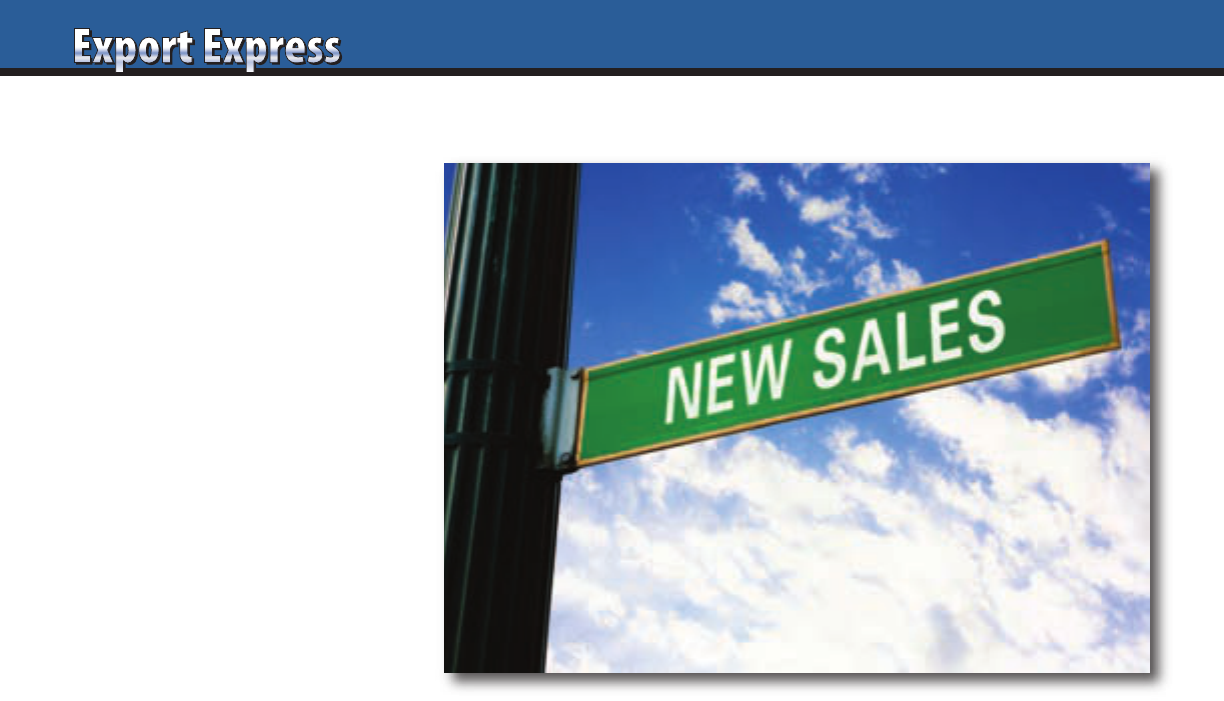
36
Exporters love the thrill of creating plans
to conquer new markets. The reality is
that our annual sales quota is dependent
on driving new sales from our existing
markets and distributors. This appears
as a challenge in a low growth country
or mature category, particularly if you
are not blessed with baskets of money to
invest in brand support activities. Listed
below are our ten tips for sourcing new
sales from existing markets.
1. Fill in White Spaces on your Listing Map
Most manufacturers focus their energy
on the total sales number for a country.
The one template I recommend for each
market is a Listing Map. This grid lists top
10 customers in the first column and your
brand SKU assortment in a horizontal
row. Where are the distribution voids?
Which new listings will generate the most
cases? What resources are needed to fill
the white spaces? What is the plan?
2. 10% Challenge
Trade spending may be a wise investment
if it drives profitable, incremental sales.
This is a good time of year to challenge
distributors with the question: “What
type of spend levels would be necessary
to secure a 10% increase in shipments
(consumption) in the next 90 days?.”
Of course, in emerging markets you
may want to challenge the distributor
for a 20-40% increase or higher.
3. Retail Sales Contest
Competitive sales representatives love
contests. Everyone enjoys winning a prize
or supplementing their income. Brand
owners should consider a sales contest
that is tied to “Pay for Performance.”
Measure incremental pallet displays for
volume brands or most creative display
for smaller brands. Sync your competition
with your peak seasonality or a new
product launch. Awards such as iPads or
weekend trips are motivational. Structure
the contest to maximize winners. Create
a theme and “have fun.”
4. Senior Management Visit
Schedule a visit for your company
president or other senior executive to visit
an underperforming market. Arrange for
the visit 2-3 months in advance. You
would be surprised at the serious market
issues that are resolved prior to your
bosses arrival. The executive’s visit is
boosted by new ideas and a commitment
for future performance.
5. Evaluate Your Pricing Model
Pricing drives volume. Most pricing
models were designed at the beginning
of a relationship and rarely revisited
except for the periodic price increase.
Conduct a retail pricing survey. What is
your price gap versus your competition?
What would happen if you adopted an
“every day low price” approach? If you
took a price decline of 10%, would the
incremental volume compensate for
the price reduction?
6. Co-Promotion: Leverage
Distributors Portfolio
Many of the most successful distributors
run quarterly or annual promotional
events featuring all their brands. Normally,
there is a charity tie-in or special theme
overlay. The beauty is that each of the
distributors brands pays only their share
of the event. These Co-Promotion events
turn out to be a big win for the distributor
and each of their brands.
7. Annual Customer Business Review
It’s appropriate for a formal review
of your business at each major customer.
This could be a data intensive review at
a key customer in a developed market
or a “two pager” in an emerging market.
The process is the key. Focusing each
sales representative to analyze their
business results and identify their
largest opportunities adds visibility
to your priorities.
8. Spend Time at Retail
Most market visits program the
export manager from hotel to office
to customer followed by dinner.
Periodically, we’ll squeeze in a store
visit or two before a customer call or
flight departure. Why not dedicate a
day at retail with the retail manager
during a market visit? You’ll get a
good pulse of market conditions
and communicate your brand insights
directly with the retail sales manager.
Brands that are obsessed with in store
performance win incremental retail
sales team focus.
9. Offer a Bonus Pack or On-Pack Promotion
Most brands source 90% of their
sales from the shelf. Generate some
excitement everyday with a bonus
pack or other special pack promotion.
Many distributors can manually apply
small gifts or premiums at their
own warehouses.
10. Distributor Change
Organizational change is a last resort.
However, if a distributor continues to
deliver uninspiring performance, you
may be forced to look at market
alternatives. How is the distributor sales
growth versus overall category and
market growth? A new distributor
typically brings a boost of energy and a
renewed sense of commitment to a brand.
Ten Tips – Sourcing New Sales from Old Markets
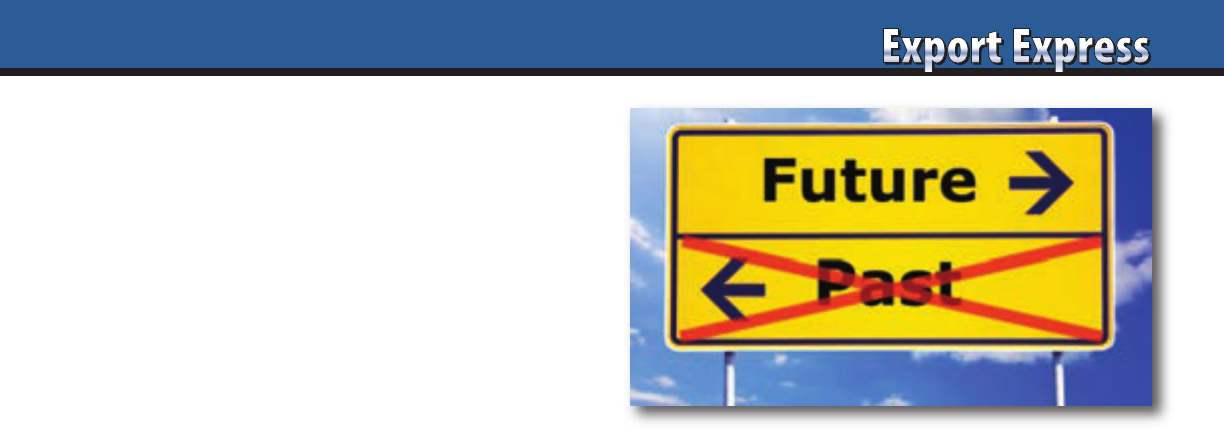
37
Changing distributors is a messy business, filled with hurt feelings,
business disruption, and legal implications. The good news is that
when you have transitioned to a new distributor, you will benefit
from the enthusiasm and commitment of a highly motivated new
partner. Recapped below are Export Solutions Ten Tips for
managing the process of changing distributors.
1. Secure Agreement on Distributor Change
from your Senior Management
In many cases, a terminated distributor will reach out to your
company president or owner to appeal your decision. It makes
sense to brief your management on the situation and your rationale
for the change. If they are not aligned with your point of view,
better to learn in advance of creating a disturbance with a
distributor termination notice that could be retracted.
2. Long Term Distributor vs. Short Term Distributor?
Your approach at handling the process will vary based upon
the length of time of your partnership. Dissolving Long term
relationships( 5 years or more) requires careful handling,
documentation of situation, and consideration of marketplace
repercussions. Ending short term partnerships is usually less
complex, as it is normally clear that mutual objectives are not
being met.
3. Probation Period
Putting a distributor on probation sends a warning signal that
termination is possible. Normally, probation periods last 3-6
months and include specific objectives to achieve during the target
period. This approach gives the distributor a “second chance” to
meet expected standards. Termination following a probation period
reduces the risk of a distributor complaining that “he didn’t know
that your company was that unhappy with his performance.”
4. Check Your Contract
Distributor contracts outline termination process and procedures.
The contract will guide required steps to make a distributor change.
Contract terms are negotiable, particularly when a distributor
relationship is ending by mutual consent. In certain cases, there
may not be a contract which naturally provides a brand owner
greater flexibility. On the other hand, you still must consider local
laws and business practices which may be in place, even without
a contract.
5. Review Local Laws
Many countries have well defined laws regarding termination
of distributors, brokers or “agents.” These laws often dictate a
compensation formula for payments due to the distributor. The
legal rationale relates to the concept that the distributor invested
his own resources to build awareness and “good will” for your
brand in his country and must be compensated for this investment.
Puerto Rico’s Law 75 applies even when there is no contract signed
and only one direct shipment to a local Puerto Rico distributor
or agent.
6. Document Inventory in the Supply Chain
This includes current inventory, orders en route, and pending
orders. One of the biggest issues in any distributor change revolves
around inventory management. Angry terminated distributors may
attempt to “forward buy” or fill the market with discounted goods.
Or they may refuse to transfer inventory to the new distributor. I
have also seen cases where the old distributor attempts to transfer
damaged or outdated inventory to the new distributor.
7. Conduct New Distributor Identification Activities
These should be in process or completed prior to termination of
the under-performing distributor. This will allow you to minimize
the time between termination notification and transition to a new
distributor. It is likely that your current distributor may learn that
you are “interviewing the market” to understand alternatives. This
is all part of the probation process and may further stimulate the
distributor to ramp up his performance levels.
8. Minimize Notification Periods – Contract Buy Out?
Contracts may specify a 3 month to one year notification period
for a terminated distributor. A Brand owner should not want
a terminated partner representing his business any longer than
they have to. The risk to the brand is too high. I prefer 1-2 month
transition period, even if a brand owner is required to “buy out”
the last few months of a contract. It is better for everyone to move
on for a fresh start as quickly as possible.
9. Trade Notification Strategy
It is likely that some customers will be upset with a decision to
make a distributor change. The good news is that “they will get
over it.” On the other hand, it is important to identify potential
sensitive accounts and for the brand owner and the new account
handler to have a prepared response for an unhappy customer.
10. Fast Start Program – Six Months
Your new distributor will be highly motivated to get off to a fast
start to make a strong initial impression. We need to balance this
desire to run fast to “sell” with the critical steps of focusing on the
fundamentals: Sufficient inventory throughout the supply chain,
update new vendor information in customer’s order management
system, education of the sales force on product benefits etc. “Crawl,
Walk, Run.” Normally, the process takes six months to successfully
complete a transition to a new distributor.
Future
Distributor change used to represent a challenging proposition
due to the lack of information on alternate distributor candidates.
Export Solutions database tracks over 9,200 distributors in 96
countries. This translates to an average of around 85 different
distributors for each market. This has eased the process of
identifying alternate candidates when distributor change is being
considered or required. Visit www.exportsolutions.com/distributor
Directory.aspx for more information.
Ten Tips – Changing Distributors:
“The Right Way”
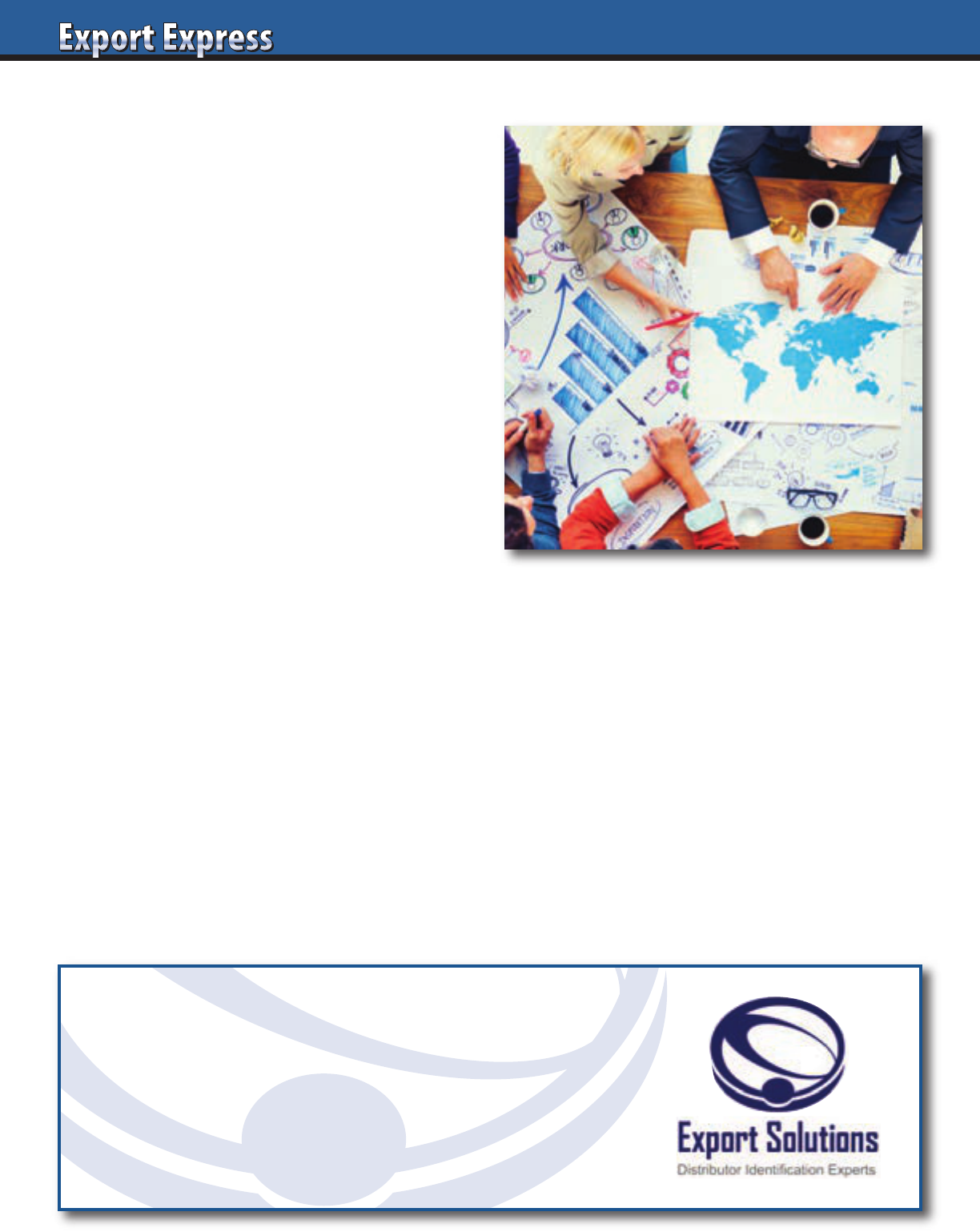
1. Determine Brand Ambition for Country
Will your brand be a category leader, player,
or niche participant?
2. Establish Distributor Selection Criteria
Big brand distributor, category specialist,
or smaller entrepreneur?
3. Create a Pool of Candidates
Export Solutions’ database tracks
9,200 distributors in 96 countries.
4. Determine Candidate’s Preliminary
Interest Level
Send introductory email, followed
by phone call within 48 hours.
5. Introductory Web Interview
One hour meeting to share credentials
and confirm interest.
6. Local Interview at Distributor’s Office
4-6 weeks lead time. 2 hour meetings.
Send advance agenda.
7. Independent Store Checks
Provides category insights and real distributor
performance for current brands handled.
8. Interview Preparation: Scorecard, Samples,
Your Presentation, Key Questions
Export Solutions’ templates: Assessment
Scorecard & Ten Questions for Every Interview
9. Distributor Interviews – Target 3 Candidates
Review capabilities, warehouse and interest
in your brand.
10. Cooperation Model
What is the plan? Year one plan, pricing
calculation, and timeline.
10 Step Distributor Search Process
Looking for Good Distributors?
Export Solutions’ database covers
9,200 distributors in 96 countries.
www.exportsolutions.com
38

39
Distributor interviews can be compared to a first
date. There is no second date after a bad first date,
even if both parties are interested in each other.
On the other hand, a good distributor first
interview can lead to a lifelong relationship.
Listed below are Export Solutions’ ten tips on
enhancing the productivity of your distributor
interview process.
1. Schedule Interview With Four to Six Weeks Lead Time
This allows you to program several candiate
interviews on your preferred timeline. Long lead
times enhance the chance of distributor senior
management availability and provide sufficient
time for motivated distributors to research
your category.
2. Meeting Agenda
Send a meeting agenda three weeks in advance
of meeting. Typical discussion topics include
Distributor credentials, organization model,
coverage by channel, success stories, category
insights, and distributor margin philosophy.
3. Store Visits – Pre-Interview
Export Solutions always conducts independent
store visits prior to our distributor interviews. This supplies
a snapshot of distributor’s performance for other international
brands. It also permits us to quickly become familiar with local
category dynamics, competitive activity, and pricing.
4. Distributor Assessment Grid/Questions
Prepare an assessment grid template highlighting and
weighting core assessment areas prior to your first interview.
Create a list of potential questions to be asked during the
meetings. Export Solutions provides free sample Distributor
Assessment grids and “10 Questions for Every Distributor
Interview” on our web site.
5. Distributor Presentation: Template or Tailored?
A key indicator of distributor enthusiasm is whether they
created a personal, tailored presentation for your meeting or
swapped brand logos and provided their “standard pitch.” Best
in class presentations allocate equal time for Distributor’s CEO,
functional heads, and your proposed first point of contact.
6. Your Company Presentation
Be prepared to share a 10-15 page presentation on your
company credentials. Stick to the key facts: company metrics,
product point of difference, export success stories, and plans
for the market. Bring plenty of samples for everyone to try.
Note that the distributor will ask for your presentation, so keep
it brief as you do not want a lengthy strategic presentation in
the hands of a distributor that is not selected.
7. Tour Distributor’s Office and Warehouse
Would you buy a house without visiting it? Distributor
offices and warehouses offer valuable clues to distributor
activity, head count, size, and professionalism. Your quick
inspection will validate that the distributor’s activities match
claims from their presentation.
8. What’s Their Plan?
A core question in a positive interview is “What would the
distributor’s plan be if we awarded them the business starting
next Monday?” This provides insights on their plans, timelines,
and process for transitioning and building new brands.
9. What Do You Like About Us?
A good way to measure distributor interest is to ask their
feedback on your opportunity towards the end of the meeting.
Framing the question from a positive point of view allows the
distributor to express interest or concerns.
10. Provide Homework Assignment
Conclude each positive meeting with a request for distributor
to provide a deeper category assessment and a suggested entry
or transition plan. Distributors should supply references for five
of their existing clients. An important insight will be the quality
and response time for completing the “homework.”
Ten Tips: Distributor Interview Preparation and Insights
Need more information? Visit www.exportsolutions.com.
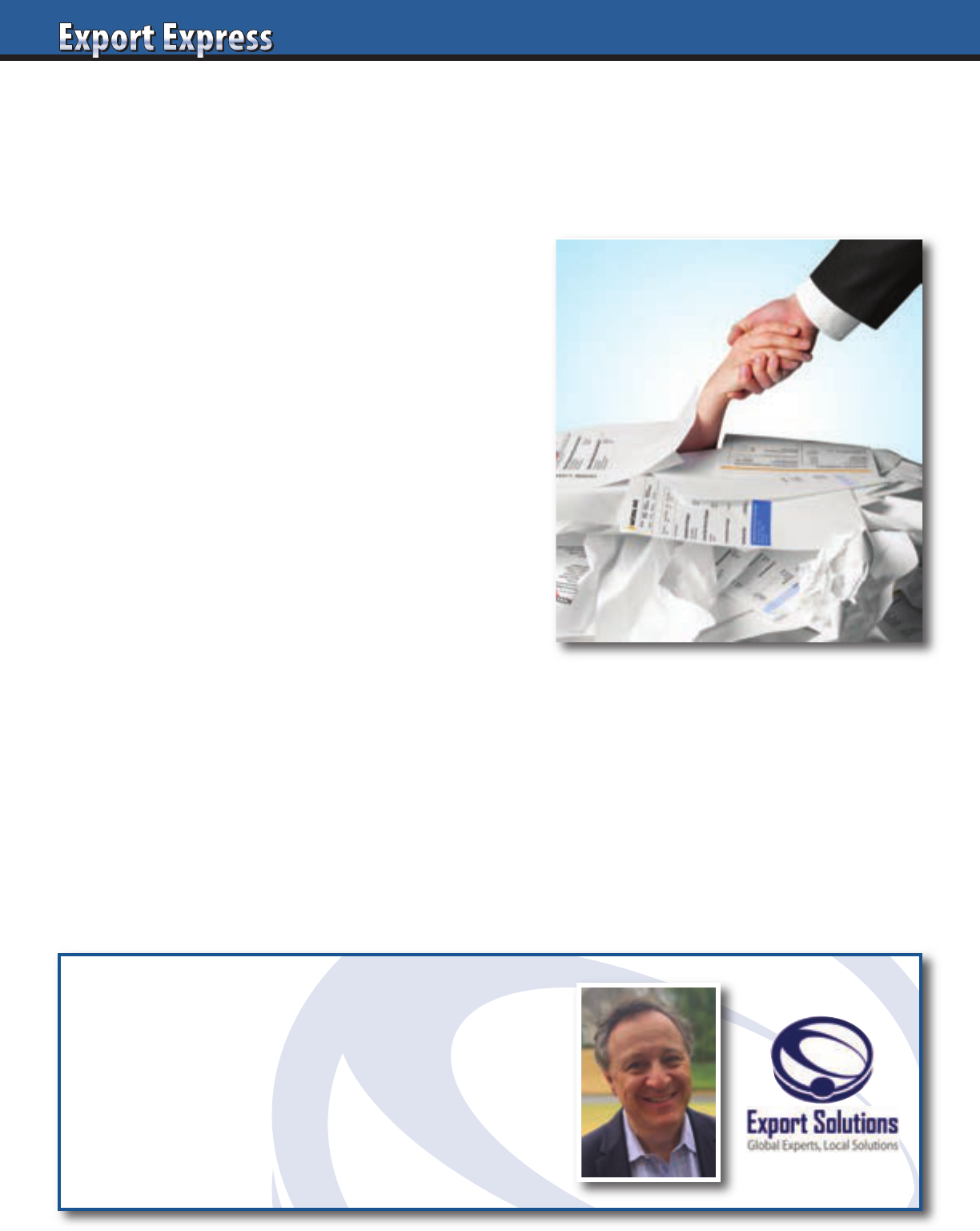
Why do Export Managers Partner with
Export Solutions for Distributor Search Help?
4 Industries Leading Distributor Rolodex
• Excellent relationships across 96 countries
• Database tracks 85 distributors per country
• 300+ distributor search projects completed.
4 10 Step Distributor Search Process
• Logical, thorough due diligence process
• Professional approach yields positive results
• Publisher: Distributor Search Guide
4 Independent Expert Assessment
• Expert partner to export managers
• Focused on all aspects of distributor search
• Working for you!
4 Results
• 90%+ success rate
• Align with “Best in Class” distributors
• Typical project takes 4 months from project brief to distributor selection
4 Make Your Life Easier!
• Identifies 5-8 qualified candidates per country
• Organize meetings with top candidates
• Sounding board during assessment process
• Export Solutions participation sends positive message to distributors.
Export Solutions Can Help!
• Distributor Search helper in 96 countries
Contact Greg Seminara at
gseminara@exportsolutions.com
or (001)-404-255-8387
www.exportsolutions.com
40

41
Your new product launch is a big deal, comparable to the birth of
a child. The first days are critical if you want to raise a “healthy
brand.” Listed below are Export Solutions’ ten tips for launching
your company for the first time to a new distributor or
expanding through a new product introduction.
Firm Calendar
Distributor and brand owner should align on a “firm calendar.”
This includes dates for sales materials development, launch
meeting and key account calls. All dates are dependent on arrival
and customs clearance of the first order. No product, no meeting!
Get Ready
Allow adequate time for printing of point of sale materials
and development of key account presentation. In some cases,
translation or local adaptation of brand owner supplied tools
may be required.
Memorable Meetings
I still remember motivational meetings with themes around
boxing and magic. Create new memories with a special theme or
an external speaker. Off-site meetings contribute to making your
launch special, with an added sense of commitment. Have fun!
Mandatory Attendance
The distributor CEO, brand manager, and export manager must
all attend and have speaking roles. Best is to have one meeting
with sales and merchandising teams together. However, in some
cases, a follow up meeting may be required. Invite logistics,
finance, and customer service people to make it a “team effort.”
In-Store Objectives
Establish clear measures for in-store presence. This includes
shelf positioning, space allocation, pricing, and off-shelf
merchandising. Share a photo. What qualifies as a “good store”
versus a “bad store?”
Frequently Asked Questions
Prepare a list of potential questions and logical responses. Role
play with the team. Share a printed one pager with sample
answers to tough questions.
Samples, Samples, Samples
Provide generous quantities of samples for all distributor
employees to enjoy and take home. Prepare recipes if your brand
is a food product. Samples are your best advertisement.
Personal Goals
Each team member should have personal goals for your launch.
For a key account sales person, this could be acceptance of the
core product lineup. A retail merchandiser could be assigned a
target of a specific number of stores with displays or eye level
shelf placement. For the launch, focus on implementation goals
versus case shipments.
Key Account Calls
In many countries, large supermarket chains dominate sales.
Develop a personal strategy for each key account. What are the
buyers internal goals? How do we fit with the chains consumer
base and plans? Which chain “push” programs can we
participate in? Schedule a “lead call” with an easier key account
to get feedback that will help you with a tougher buyer. Invite
the export manager or distributor MD to participate in the sales
call if it will help.
Audit
Schedule a retail audit of stores to coincide with the expected
retail availability of product. Bring other people from the brand
owner’s company and have 2-3 teams auditing the market
against a specific set of goals. Visit secondary cities, not just the
stores around the distributor’s office. Recognize that conditions
will not be perfect and celebrate progress to date.
New Product Launch: Ready, Set, Grow – Ten Tips
Need more information? Visit www.exportsolutions.com.
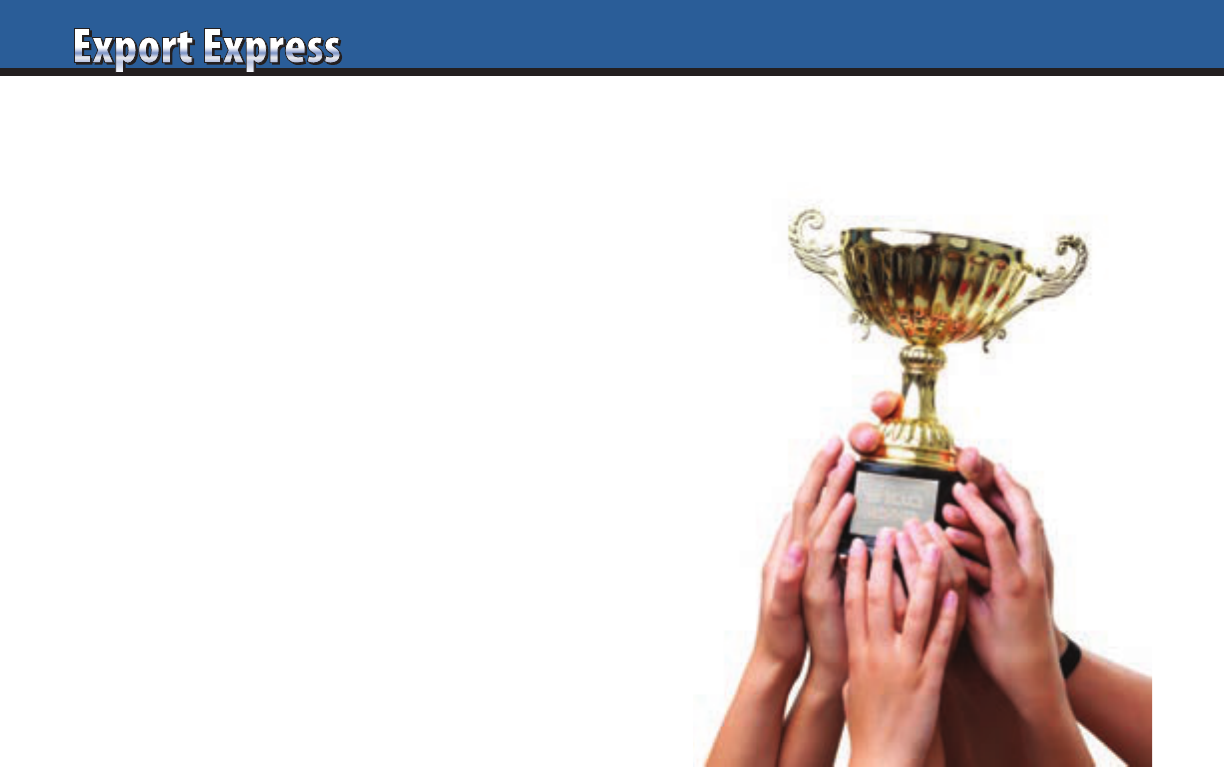
42
Fifteen Tips: Achieve Preferred Supplier Status
A natural goal is to achieve “Preferred
Supplier Status” with retailers and your
distributors. Satisfied trading partners
generate superior results. “Vendor of
the Year” does not mean “Spender of
the Year.” Listed below are 15 tips to
be viewed as a Preferred Supplier with
your distributors and retail customers.
1. Invest in Brand Support
Marketing activities drive incremental
sales and cultivate the health of your
brand and category. Supplier investments
in consumer awareness and retailer
development activities help everyone
achieve their sales objectives.
2. Innovate, Innovate, Innovate
The CPG/FMCG industry is fast paced,
with frequent new product introductions.
Companies which invest in research to
deliver new product ideas out-perform
and lead the category.
3. Keep the Supply Chain Filled
Short shipments cause a chain reaction
of problems throughout the supply chain.
Seek to attain a 98% case fill rate or better.
4. Distributors Need to Make
Money Too!
Retailers, Manufacturers, and
Distributors seek to achieve a reasonable
profit. Distributors (Importers/Brokers)
are often “squeezed” as middlemen.
Distributor Margin reductions translate
to cutbacks in sales personnel, customer
service, investments in technology, and
ultimately impact results for your brand.
A financially healthy distributor is a
productive partner.
5. Focus on Priorities versus Minutiae
All partners are guilty of getting absorbed
in the details of the business. Maintain
attention on the key elements which
drive business success. Minimize
“non-essential” reports.
6. Serve as Category Expert
It’s a challenge for Retailer buyers and
distributors to master all the categories.
Preferred suppliers provide fresh and
unbiased insights into category trends,
product development, and analysis of
category data.
7. Visit the Market, But not Too Often
Distributors and Retailers welcome your
periodic visits. Insights on market
development and problem solving “face
to face” are
invaluable. On the
other, you need to
provide distributors
the time and freedom
to build the business
without distraction
of preparation and
management of
frequent supplier
market visits.
8. Calibrate Time
Commitment to
Compensation
A first step is
to evaluate what
your brand represents
to a distributor (or
retailer) in terms
of annual revenue/
profit contribution.
Reflect on the
activities requested
to service your
business in relation
to your contribution.
9. Keep Your
Commitments
Preferred suppliers
are viewed as trusted partners. Reliable
suppliers secure more than their fair
share of retailer and distributor focus.
Last minute cutbacks in marketing
support are sometimes necessary, but
damage your credibility.
10. Respond to Local Ideas
Distributors and Retailers know their
markets. Give them the support they
request on a new promotion idea or sales
campaign. Let them build ownership of
an idea and the ultimate results. Good
ideas will build credibility and sales.
11. Pay Bill-backs on a Timely Basis
Many distributors are small businesses
with tight cash flow. It is always positive
to be viewed as a “Prompt Payer” of
legitimate invoices.
12. Support Distributor
with Corporate Headquarters
Many companies enjoy long term
relationships with their distributor
network. The Distributor depends on
you to serve as their advocate with senior
management of your company. Fight for
their ideas and defend their business
performance, where appropriate.
Remember that all organizations
experience a mix of “good years and
bad years.”
13. Share Best Practices
Industry participants are all “students
of the game” and are generally open
to learning about strategies from other
markets/retailers. On the other hand,
we must recognize that all markets have
subtle differences and not all approaches
are transferable.
14. Provide Proper Lead Time to Achieve
Desired Results
The consumer goods industry is relatively
organized with established protocols
and timelines. Exceptions can be made
in case of product recall or breakthrough
innovation. Everything functions better
when timelines are adhered to.
15. Recognize Achievement
Take the time to say “Thanks” or “Well
done.” This acknowledgement may be
in the form of a personal note, phone call,
or public recognition.
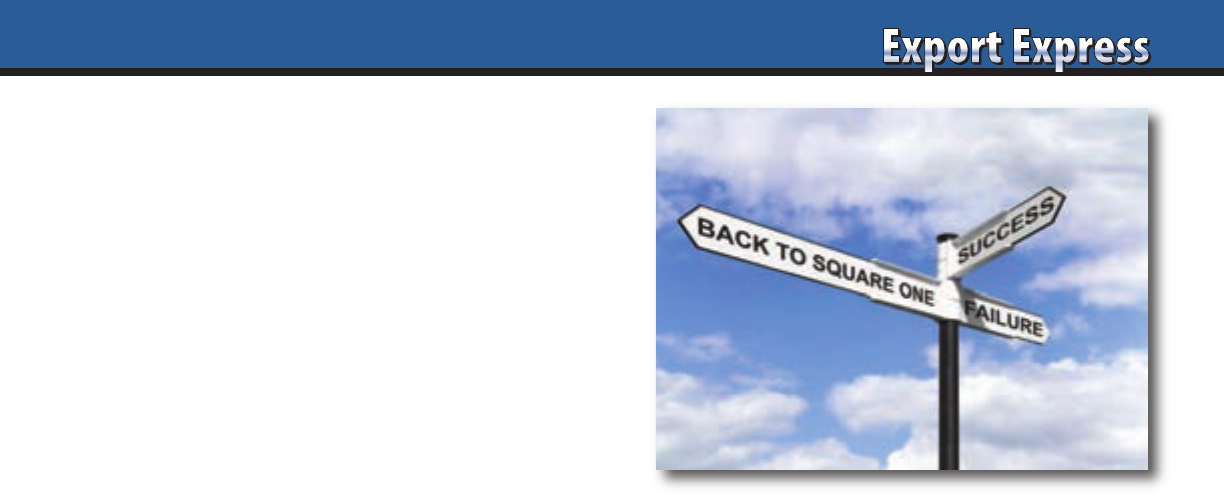
43
Export represents a dynamic growth
opportunity for most companies.
However, most companies make
mistakes, particularly in the early cycles
of their export development. Listed
below are some common mistakes:
1. No Category Research
Some companies assume that their
category development is consistent
everywhere. They fail to conduct basic
research on competitive dynamics and
pricing. This research can be as simple
as a day of store checks in your target
market. I remember having an argument
with a leading producer of branded
Indian Food about export opportunities
to Latin America. He refused to believe
that the market for Indian food was so
small, because he had not conducted
research or visited the market. Do
your homework!
2. Limited Investment in
Marketing & Trade Spending
Few brands are so innovative and
exciting that they will sell without
investments in consumer awareness
activities and trade incentives. Yet,
many exporters believe that they can
offer a “net price” and a distributor
will create a significant business, without
support. There is a cost of doing business
in every market. Ultimately, your results
will be directly proportional to your
marketing investment.
3. Another “Me-Too” Product
Innovation sweeps the world at a rapid
pace. Manufacturers fail when they do
not create a unique selling proposition
(USP) for their brand. Why is your
product different versus current options?
Is the differentiation meaningful? A
better price (value) or heavy marketing
investment can also differentiate your
brand. I recently visited Europe’s largest
food trade show. I saw a “lonely”
exhibitor from the USA with little
interest in his commodity food products.
Why would a European retailer or
distributor want to import a product that
can be sourced locally at a better price?
4. Pricing is Too High
On many export projects, the price to
the consumer can be twice the price from
your home market, by the time that you
add in logistics costs, duties, distributor
margins, and taxes. Yet, much of export
growth is sourced from emerging
markets, where
spending power is
low. So, the result is
high priced product
being marketed to
people with limited
funds. In many cases,
the consumer will pay
a premium (10-30%)
for a quality,
imported product.
However, once your
product is priced 50%
or higher than the
local competition, you
are just appealing the
top 10% of the population in most cases.
5. Product not Labeled in the Local Language
English is a global language, but
obviously your brand will obtain a
better reception if it is labeled in the
local language. Many countries have
laws requiring labels or at least
nutritional information in the local
language. Another similar issue is that
some brand names do not translate on
a global basis. What does your brand
name mean in the local language? Does
it sound similar to something else which
has no correlation to your brand?
6. Insufficient Due Diligence during the
Distributor/Partner Selection Process
I am amazed at the number of
relationships based upon only a short
meeting at a trade show. I love trade
shows and believe they are a great
place to meet prospective distributors.
However, you must conduct due
diligence on your prospective partner
in their home country, before beginning
your relationship. This includes
interviewing the distributor as well
as other candidates at their local offices.
Visit the stores to see their performance
for their current brands. Conduct
reference checks and run financial checks
with Dun & Bradstreet or similar credit
check agencies.
7. Diverting – New Customer
Pick Up at your Plant
Export managers are flooded with
requests by distributors/buyers wishing
to purchase well known brands. Many
of these inquiries are legitimate, but a
significant percentage are from diverters.
I’ve written a separate article on this
subject, so I’ll only share a few
comments here. If your export price is
less than your standard price, display
extreme caution in dealing with new
distributors/buyers.
Complete the required “Due Diligence”
referred to in point 6, including a visit to
the distributors warehouse. Do not allow
pick up at your plant or at a local port by
a new distributor, if your price is lower
than your standard price. Ship to the
distributor product labeled in his native
language and be cautious about promises
to sticker the product at the port.
8. No Focus on the Shelf
Too many exporter/distributor
discussions concentrate only on
container shipments and orders. A
critical element is the need to focus
on activities to generate consumption.
Some export projects fail, because the
exporter does not dig deep to track
progress against fundamentals of
acceptance at major retailers, assortment,
pricing, shelving, and merchandising at
store level.
9. Exporter Fails to Visit the Market
The internet has facilitated global
communication. However, there is no
replacement for a periodic, face to face,
market visit to discuss issues and
measure progress. “Out of sight…out
of mind.”
10. Unrealistic Expectations
Exporters are optimistic by nature.
Launch plans project volumes based
upon category size and the famous
statement “If we secure only a 10%
market share…” You know the rest of
the story. Reality is that the 10% market
share is possible, if you focus on
avoiding the mistakes discussed
in points 1-9 above. Good luck!
Ten Tips – Common Export Mistakes
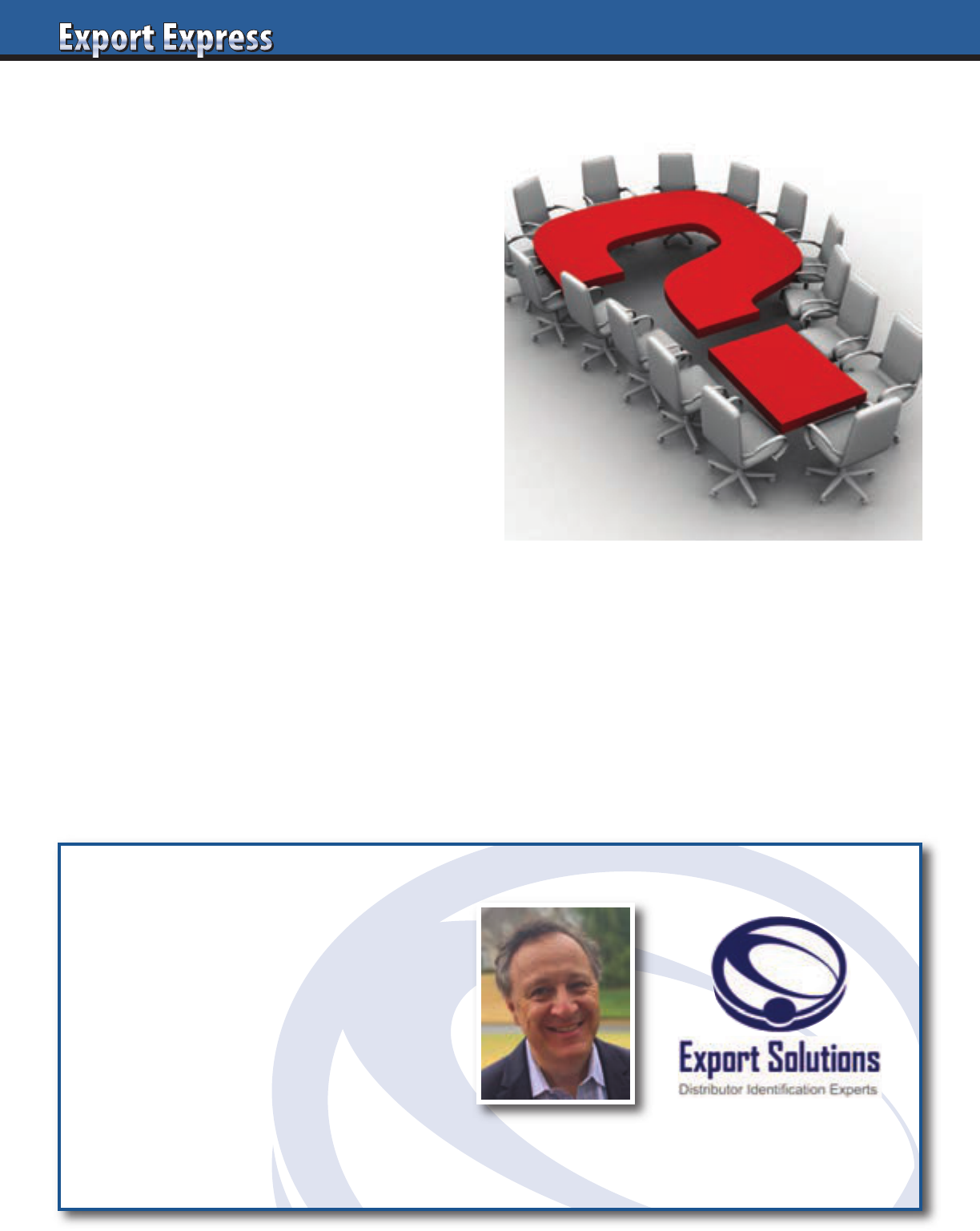
44
10 Questions for Every Distributor Interview
1.Company History
How long have you been in business? Who are the owners?
How many direct, “payrolled” employees do you have?
Approximate annual sales volume?
2. Company Brand Portfolio
What are your top 10 companies/brands represented?
For which channels do you represent each brand?
How long have you represented each brand?
Can you provide senior level references at each “brand owner?”
3. Key Account Buyers
Who is the buyer for our category at the largest retailers
in your market? What other brands do you sell to our buyer?
How frequently do you visit each major customer?
4. New Product Launch Success Story
Provide a recent example of a new brand launch success story.
Key retailer acceptance? Cost of entry? How long did it take?
Key elements of the success strategy?
5. Creative Selling
Provide an example where you took an assigned
marketing/brand support budget and created a successful
local program. How do you measure success?
6. Retail Servicing
How many full time employees do you have visiting retail
stores? Are they located countrywide or just in the capital city?
How do you measure a “good store” in terms of brand presence
versus a “bad store?” Describe your retail reporting system.
7. People
Who would be our point of first contact? Would our contact also
“sell” our brands to major accounts? What other brands is our
contact responsible for? How do we insure that we get our fair
share of attention from your sales force?
8. Business Planning Model
What would your action plan be if we made an agreement to
start with your company? First steps? 90 Day Plan? Reporting?
9. Cost to Serve
How do you model your distributor margin? Range
of margin for our brands? Are you open to promotional
spending split (50/50)?
10. Enthusiasm for our Company
Why is our brand a good match for your company?
Why are you the best partner in the market for our brand?
What commitment are you willing to make?
Talk to an Expert
• International Strategy Road Map
• Fix Problem Markets
• Entry Plans
• Find Distributors in 96 Countries
• Export Workshops
• Motivational Meeting Speaker
Contact Greg Seminara at (001)-404-255-8387 to discuss your business development project.
www.exportsolutions.com
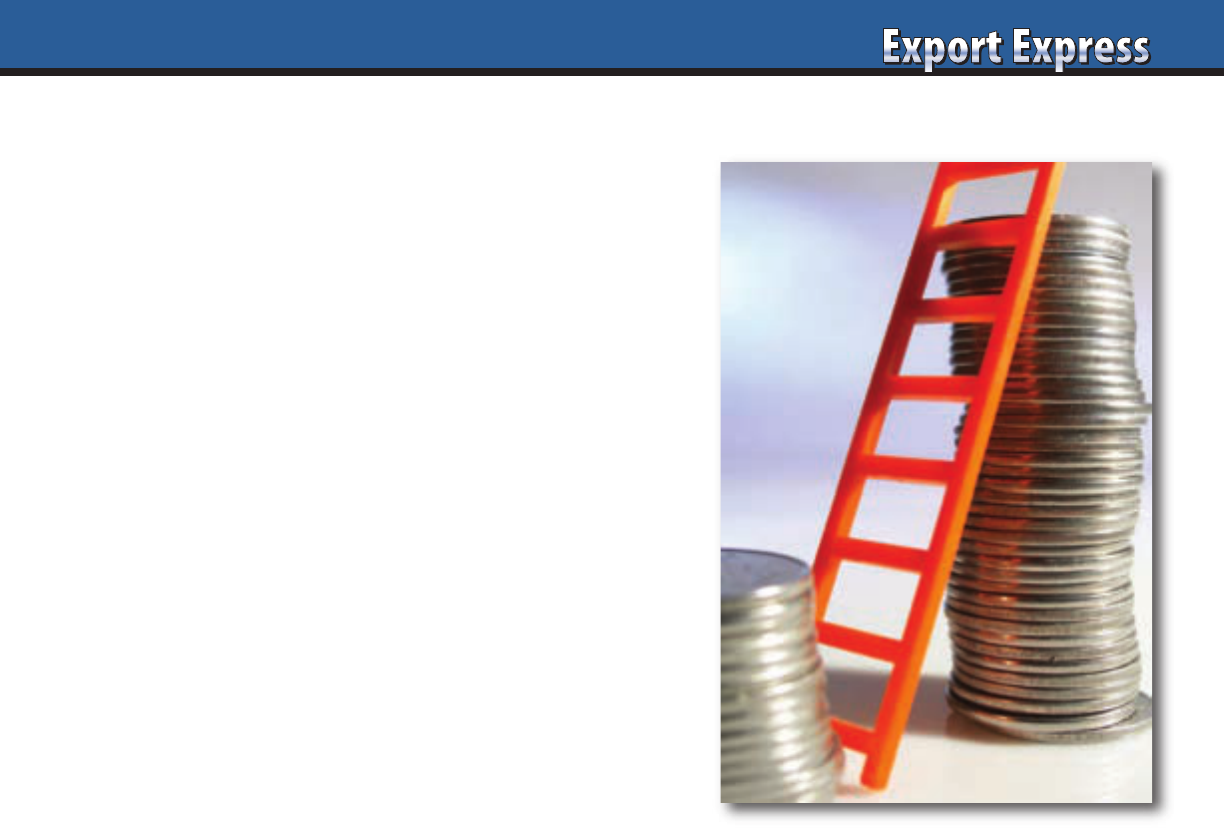
45
Everyone knows their own salary.
But have you given much thought
to the compensation structure for
your distributor partners? Distributor
compensation is often a “murky” issue,
buried in a calculation created years ago
focused on a combination of distributor
margin plus other income for services
rendered. Brand leaders periodically
review their distributor compensation
structure and compare it to the
requirements to service their business
in 2022. Listed below are Export Solutions
“Ten Tips” for analyzing your distributor
compensation model.
1. Convert Distributor Margin
to Gross Dollars Earned
Margin percentages are important,
but another critical measure is absolute
income derived from representing your
brand. This simple calculation of gross
margin multiplied by invoiced sales
provides a baseline number. If applicable,
manufacturers should add bonuses or
subtract retailer rebates.This is the first
step to understanding your true
distributor compensation.
2. Shared Service Model
Typical distributor services may include
importation, warehousing, delivery,
selling, merchandising, invoicing, and
collections. In some cases distributors
reinvest a portion of their margin in trade
discounts or in store marketing activities.
Another major distributor expense is
people, including senior management and
a brand management team. Income from
your brand margin buys your company
a share of total distributor resources.
3. Value Equation: Distributor
vs. Local Subsidiary
An important exercise is to evaluate the
services received from the distributor
relative to what they would cost if you
needed to create your own independent
subsidiary in a country. Your analysis
should include subsidiary allocations
for buildings, information technology,
telecommunications, travel, and
entertainment. Normally, the result
demonstrates that the distributor model is
an efficient outsourcing alternative. The
key is to balance your many company
objectives versus the requirement to
function in a “shared services”
environment where you are “buying”
only part of the distributors time.
4. Pay For Performance
Most food and consumer
goods industry executives
operate in a compensation
structure which includes a
bonus incentive for achieving
and exceeding assigned goals.
Some brand owners have
extended this approach to
distributors so that the entire
team is aligned on a common
plan. All distributor bonus
schemes should reward cases
moved into consumption
versus warehouse inventory.
5. Price Increases mean
Distributor Pay Raise
Many suppliers were
fortunate enough to execute
price increases. In a margin
driven structure, this often
translates to a pay raise for
the distributor, with little
incremental effort other
than implementing the price
increase. On the other hand,
a price decline means a
reduction in distributor
compensation and the
distributor needs to execute
his own “salary” reduction!
6. Contracts and Margins from the 1990’s
Many distributor contracts and margin
calculations date back to the 1990’s or
many years earlier. These agreements are
rarely revised or reviewed based upon
the realities of competing in today’s
marketplace. When was the last time that
you reviewed your Distributor contract,
margin, and service requirements? Does
it still make sense?
7. I don’t know my distributor’s margin
This happens more frequently than you
might imagine. In many arrangements,
the distributor buys your brand at a dead
net price and applies their own internal
methodology for margin development.
Some distributors are protective of this
practice with a rationale that manufacturers
should not “pry” as long as shipments
maintain a positive trajectory.
8. Best in Class Distributor Compensation
Leading Distributors offer an open book
approach based upon a cost to serve
model. Financially astute distributors
provide new suppliers a detailed
template identifying key services and
manufacturers requirements to operate
the business. Smart manufacturers will
benchmark their distributor margin
versus similar brands in the market.
Key inputs include complexity of your
product line, logistics inputs (temperature
requirements, case weight) and size of
your business.
9. Total Compensation: More
than Gross Margin
Examine every line item in your market
price calculation to understand total
distributor revenue sourced from your
brand. Distributors may increase their
income through promotional funds,
added margin for logistics services,
or periodic bill-backs.
10. Distributors have Profit Targets Too!
Distributors are in business to make
money too! It is quite reasonable to
expect that the distributor should realize
a net profit of 3-5 percent. Everyone
hopes to grow their salary base and
receive bonuses for excellent
performance. Winning long term
relationships exist when both parties
profit from business success.
Ten Tips – Distributor Compensation Analysis
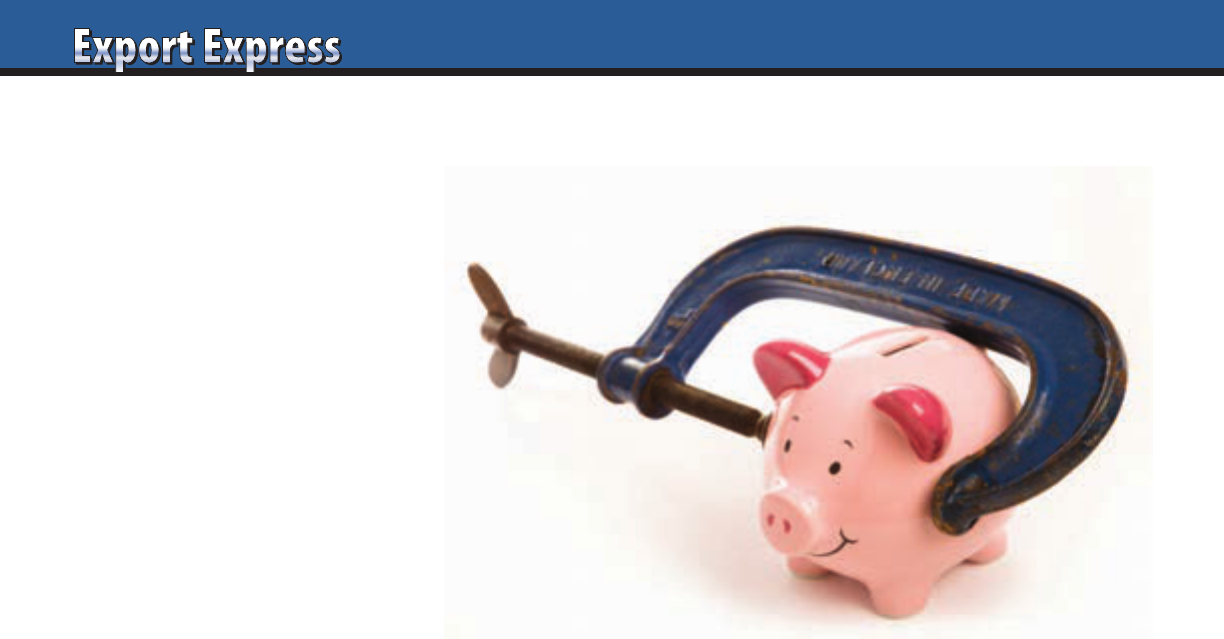
46
There are 196 countries in the world
and there is always a financial crisis
somewhere. Recently, Western European
countries have suffered issues. Emerging
markets display a history of “boom-
bust” cycles. A friend from Argentina
explained this story. “I do not worry
when things are bad and the country
is suffering. At least, I can face my
problems directly and I know that
recovery is ahead of me. I am more
afraid in good times, when business
has been growing for a few years. In
these cases, I know that a new crisis
is around the corner and surprises
are tougher to deal with.” Recapped
below are Export Solutions’ Ten Tips
for dealing with countries experiencing
financial instability.
1. Assume every market will be
affected. Naturally, certain emerging
markets carry a higher degree of risk
versus others. However, even large
countries such as the USA and the
United Kingdom have been burned
through the bankruptcies of Bruno’s
and Woolworth’s. Total risk should
be measured by the amount of credit
outstanding as well as each countries
risk factor.
2. CFO to CFO discussions make sense.
Bring in the financial experts. Let your
company CFO or financial manager
speak with your Distributors (or Key
Retailers) financial manager. These
financial experts speak the same
language and will allow your financial
team to accurately gauge the situation.
It also spreads out the responsibility
beyond the sales and marketing
department for potential problems.
3. Request New Distributor/Retailer
Credit Information – Most of this
information was submitted years ago
in advance of the credit crisis. It is timely
to request new information every year.
2021 year end financial reports should
be available from every distributor.
4. Watch Distributor/Retailer
Inventories – Shipments to retailers may
not correlate to consumer demand.
Inventory levels measured in terms of
weeks supply on hand should be
monitored at both distributors and
retailers. Higher inventory levels signal
slowing consumer demand. Reduced
inventory levels may indicate a cash
flow/potential credit problem.
5. Connect with Peer Non-Compete
Suppliers – Every retailer and
distributor trades with a myriad
of suppliers. I recommend setting
up formal or informal groups of peer,
non compete, suppliers. These valuable
contacts facilitate the exchange of
benchmarking information on shared
retailers and distributors.
6. Track Leading Indicators – Most of
us are not economists, but it is still easy
to develop a simple tracking form of
leading metrics for distributors in key
countries. We suggest measuring trends
in shipments, accounts receivable,
inventory, as well as country level data
on GDP, stock market, unemployment,
and currency exchange rates.
7. Payment Terms – Some suppliers
are implementing additional safeguards
to protect themselves. This includes
moving towards “brokerage style”
arrangements where the manufacturer
still maintains ownership of the goods.
Other strategies include offering
discounts for early payment or
requesting cash on delivery.
8. Run a Dun & Bradstreet Report
on Partners – On the surface, business
may appear normal. A Dun & Bradstreet
Report (or similar) creates a rating based
upon a thorough examination of financial
records, statements and dealings of the
business with its customers, clients,
investors and shareholders.
9. Beware of Unusual Shipments
or Billback’s – Unfortunately, there
are too few examples of unusual, “best
ever” promotional success stories. Look
carefully at order patterns or promotional
allowance reimbursement (billback)
requests that appear out of sequence
or abnormal.
10. Commit to Open Dialogue
with Long Term Partners – Many
exporters enjoy relationships with their
international distributors that extend
20, 30, 40 years or more. Current financial
issues likely reflect overall country level
financial status versus poor decisions
taken by a long term distributor.
Distributors need to understand that
manufacturers hate “surprises.” Best bet
is to create an environment that facilitates
open communication supported by data
to solve any credit issues.
Ten Tips – Managing a Credit Crisis
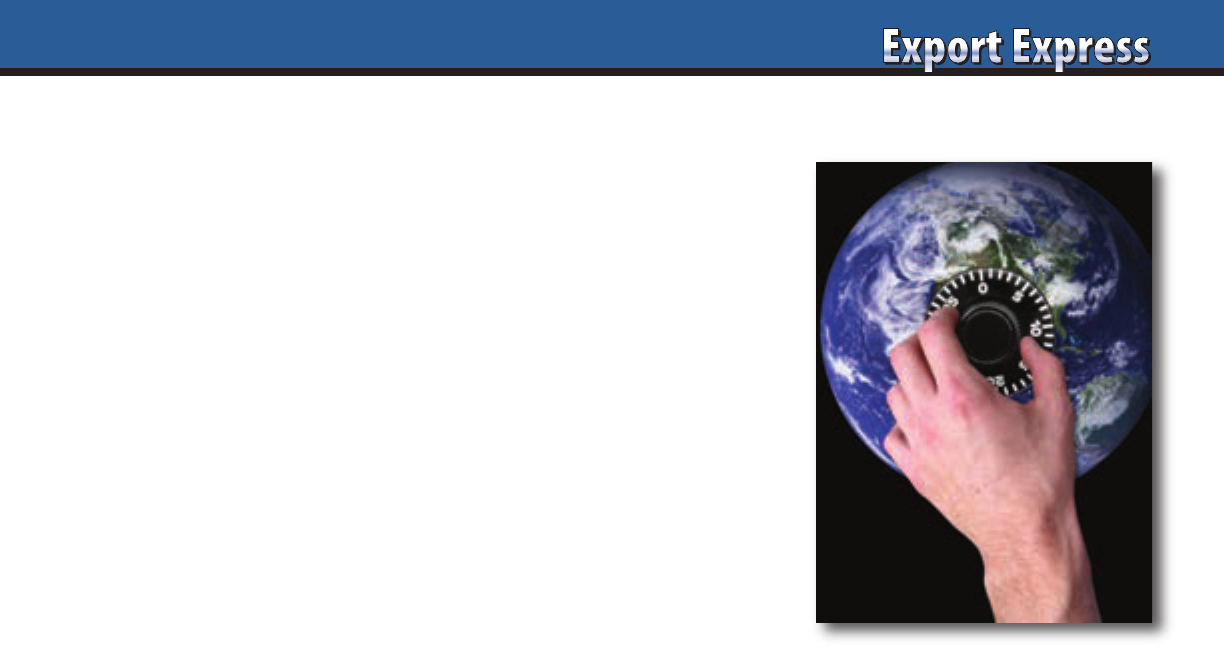
47
Europe is not easy, with 50 independent
countries, 750 million people, and 24 official
languages. Within Europe, you have the
European Union of 28 countries, including
18 who use the Euro currency. The
supermarket business includes a few multi-
country players such as Carrefour, Tesco,
Rewe and Auchan. However, each country
tends to have its own dominant retailers
with unique operating practices and
distributor communities. Europe appears to
be bouncing back, with strong GDP growth
in Germany, United Kingdom, Nordics and
improved conditions elsewhere. Europe
appears attractive for USA exporters due
to the size of the prize and respect for
innovation. American lifestyle and products
are appreciated by many. Export Solutions
provides Ten Tips on cracking the code to
develop new business in Europe.
1. What is Your USP?
Europe shares many eating habits with
the USA, creating a difficult environment
to compete with higher priced, “me too”
products. Success stories typically involve
categories such as Peanut Butter, Microwave
Popcorn, or Tex Mex that are viewed as
“uniquely American.”
2. Labeling & GMO
Most European countries require labels
with nutritional information in the native
language. A frequent approach is to create
a “Euro Pack,” with multiple languages
crammed on the back of the package.
There are only a few countries that accept
the “stickered” approach. Most European
retailers do not accept products with GMO
ingredients. This is a hotly debated issue
that we will not solve here. Bottom line is
to offer non GMO versions or don’t waste
your effort in the strict countries.
3. Define Your Ambition
Are you looking to become a player in your
category, prepared to invest in marketing
support and trade activities? Or are you just
looking for incremental shipments based
upon an “America’s favorite” platform?
Either option is acceptable, but you should
align expectations and choice of partner
with your investment model.
4. First Stop UK, Then Nordics
Made in the USA brands should consider
the UK and Ireland as their initial point of
entry. Common language, familiarity with
USA brands, and organized trade structures
enhance your chances of success. American
retailers such as Waitrose, Ocado, Costco
and Whole Foods may be charmed to add
your product to their UK shelves. Nordic
countries are worth consideration. Many
food brands are imported into the region
from other European countries, so the price
gap for American brands is not as great.
An educated consumer base with strong
spending power add to the attractiveness.
Cost of entry is modest, at least compared
to Germany or France.
5. Distributor Model – Best in Class
The European distributor model provides
an integrated solution of key account sales,
country level marketing, logistics, and
financial services. These exclusive partners
service all country retailers and actually
serve as your primary “bill to” customer
in country. The USA broker model is
not common in Europe, as most brands
require financial and logistics services,
not just “selling.”
6. 3,139 Distributors – 34 European Countries
Export Solutions database covers 3,139
European distributors across 34 European
countries. This provides an average of
84 distributors per country of various
specialties: Gourmet Food, Confectionery,
Beverage, Natural Food, HBC, and other
supermarket categories. We also cover 287
“Americana” distributors handling “Made
in the USA” products.
7. Investigate ESMA
ESMA is the European Sales and
Marketing Association. This is an
organization of 70 of the top distributors
across Europe. These best in class
distributors are serious companies, with
a history of brand building for companies
with unique products and a willingness
to invest. ESMA features an annual
conference (Vilnius in June), that provides
a venue for manufacturer members to
network with leading distributors across
Europe. For more information, visit
www.esma.org, and tell David O’ Neill,
ESMA CEO, that Greg sent you!
8. Trade Shows: SIAL, ISM, and CIBUS
Participation in European industry trade
shows is a must. These shows attract from
50,000 to 150,000 visitors including most
European buyers and distributors. In 2022,
SIAL in Paris will be the best show for most
brands. ISM is Europe’s version of the
USA’s Sweets and Snacks show. Biofach is
important for natural foods and PLMA for
private label. Each country also features an
exhibition such as CIBUS in Italy, IFE for
the UK, and Alimentaria for Spain. The USA
features a pavilion at each of these shows.
Rent a booth and test reaction and interest
for your product line.
9. Americana Strategy
Each European country has retailers and
distributors that specialize in America’s
favorites. Dedicated stores like Taste of
America in Spain or Gray’s in Sweden offer
a broad assortment of USA brands to fans
of American lifestyle and homesick
expatriates. Other leading supermarket
chains offer dedicated sections of American
products. This approach is about availability
and visibility not pricing and slotting
allowances. An Americana strategy may
appear as a low cost way to test market
acceptance of your product.
10. Cracking the Code – Look in the Mirror
USA exporters considering Europe should
think about what it takes to get on the shelf
at Kroger or Stop and Shop: innovative
product, slotting fees, promotion plan,
competitive pricing, and a strong broker.
The fundamentals for entering Europe are
not that much different, other than you are
the “new guy,” with the added expense of
freight from the USA. Start slowly, with
realistic expectations of starting in a
handful of European countries versus
selling across Europe. American products
are well received, but Europe is not the
destination for those just looking to sell
a few extra cases.
Europe: Cracking the Code
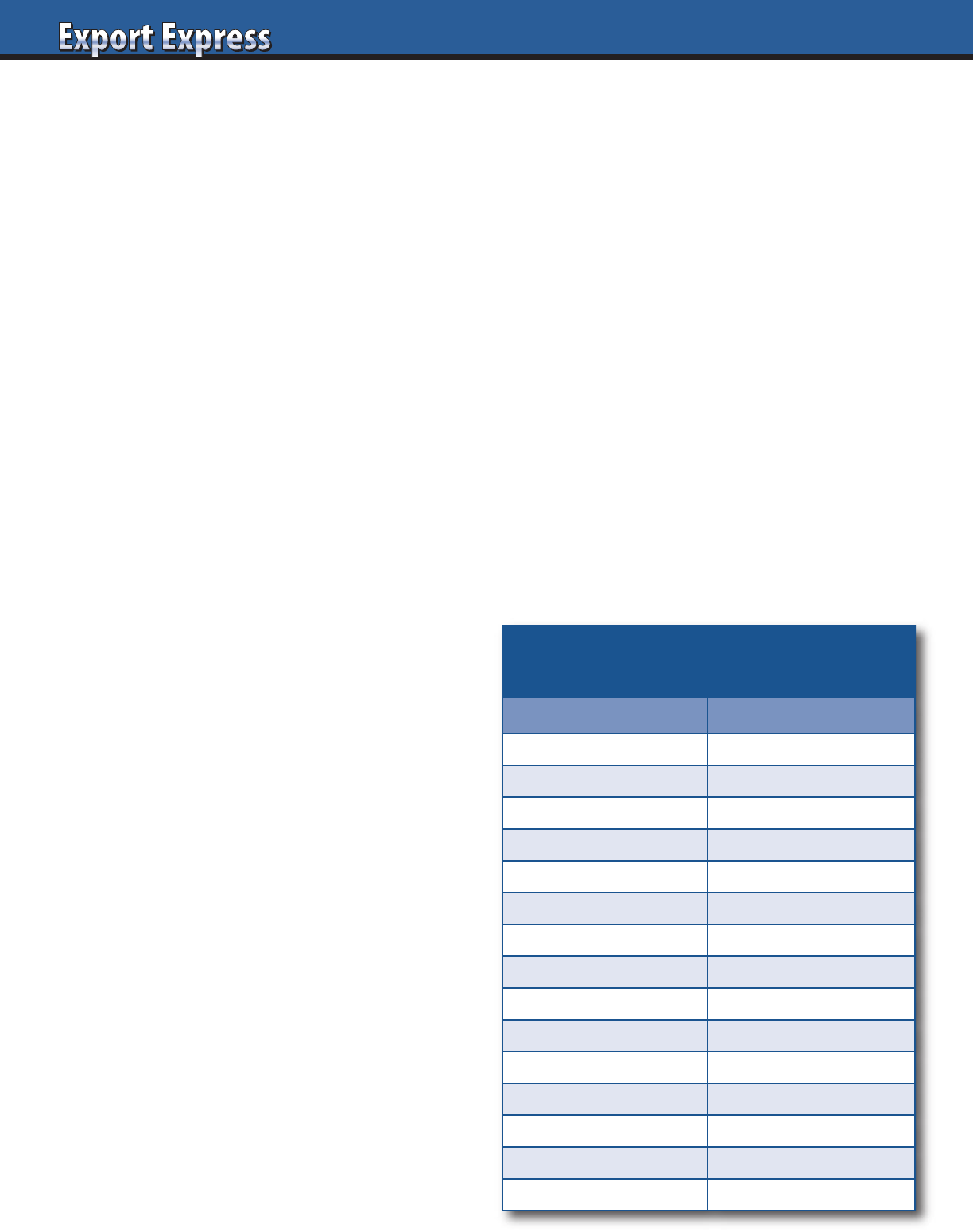
The USA represents the world’s largest market. A small market
share in the USA can represent a bigger business than owning
a 50% market share in a smaller country. Many international
brands fail to reach their potential in the USA as they treat it as
just another export market. Listed below are Export Solutions’
ten tips for improving your results in the USA, a consumer
market of 330 million people.
1. Develop a Channel Strategy
The USA Food business is segmented into 13 channels, with
supermarkets claiming an average of 52% of the business. Other
important channels include Supercenters, Mass, Foodservice,
Value, Club, Convenience, Natural, Gourmet, Internet, Military,
Gift, and Ethnic. One strategy is to concentrate efforts on winning
in one channel to gain traction, versus spreading efforts in too
many areas.
2. Optimize Results at Top 10 USA Retailers
Think Walmart, Kroger, Publix, and Food Lion that all operate
more than 1,000 stores. Many companies claim that they “sell
to Walmart.” The key question is to identify a chain’s store count
and measure how many of those stores your brand is available
in. Last year, an important European beverage brand told me
that they were “selling to Walmart.” Turns out that his follow
up investigation revealed that he was selling to only 46 of
Walmart’s 3,570 supercenters.
3. Think Beyond New York
None of the top 5 grocery retailers maintain a presence in metro
New York. The USA has experienced a population shift to the
South and West, with the Northeast actually representing the
smallest of the four regions. Visit Atlanta, Houston, Los Angeles,
or Miami to get a more accurate gauge of industry dynamics.
4. Use a Broker
In the USA, the brokers play a unique role, touching virtually
every brand in the supermarket aisles. Even importers use
brokers to supplement their own efforts. Export Solutions’
database tracks 524 USA brokers, including the “Big 3.”
5. Retail Services are Required
Great news! You just received a listing at Kroger or Albertsons.
Your work has just begun. Planogram integrity is an enormous
issue in the USA. Compliance levels of new items at store level
may reach only 60% without a broker at store level to “cut in”
your product and monitor its availability.
6. Data Driven Decisions
The USA market is blessed with the most sophisticated analytic
tools that are used on a daily basis. This includes availability
of point of sale data at the chain (and sometimes store) level
to measure everything that scans. Business building and selling
incorporates use of post promotion analytic tools, market basket
studies, and brand sales by demographic cluster.
7. Try a Coupon
USA Sunday newspapers are jammed with coupons offering
consumers small discounts (.25 - $1.00) to purchase a product. Many
supermarkets up the ante, by doubling the value of the coupons.
This is a proven strategy to drive listings, generate trial, and repeat
purchase. A coupon can force a retailer to carry your product, as he
does not want to disappoint a customer with a coupon.
8. Hire a Sales Manager
An international company should place at least one person in
the USA to manage their interests. Hire a veteran sales person
and locate him in a home office in a city with a great airport
like Atlanta or Chicago. This role will allow him to manage your
distributor and broker network. You can also hire a contract sales
management group like Ram to perform this function. Hiring an
employee based in the USA signals that you are serious about
building your business in the USA.
9. TPR
This stands for Temporary Price Reduction. USA supermarket
aisles are filled with hundreds of these tags. The consumer
recognizes these tags to signal a special discount and “time
to buy.” TPR’s are normally 10% of everyday price and can be
an efficient spend particularly on a “scan down” program.
10. Ethnic Channel: First Stop
Your product will be well received in channels specializing
in your country’s products. There are well established retailers
specializing in Hispanic, Asian, British and Italian Foods. Whole
Foods and Cost Plus World Markets offer good assortments of
international brands.
Export Solutions has published a Selling to the USA guide.
This free 58 page guide is packed with insights, templates,
and retailer information. This popular guide even includes
a Dictionary of USA industry terms. For your copy, email
Ten Tips for Foreign Brands: USA Growth Strategies
Good USA Chains for
International Brands
Retailer Stores
Ahold-Delhaize 2,050
HEB – USA 355
Meijer 260
Wakefern/Shop Rite 361
Whole Foods 510
Hy Vee 285
Giant Eagle 216
Wegmans 106
Harris Teeter 260
Sprouts 370
Raleys 126
Fresh Market 159
World Market 242
Gelsons 27
Kings 19
48
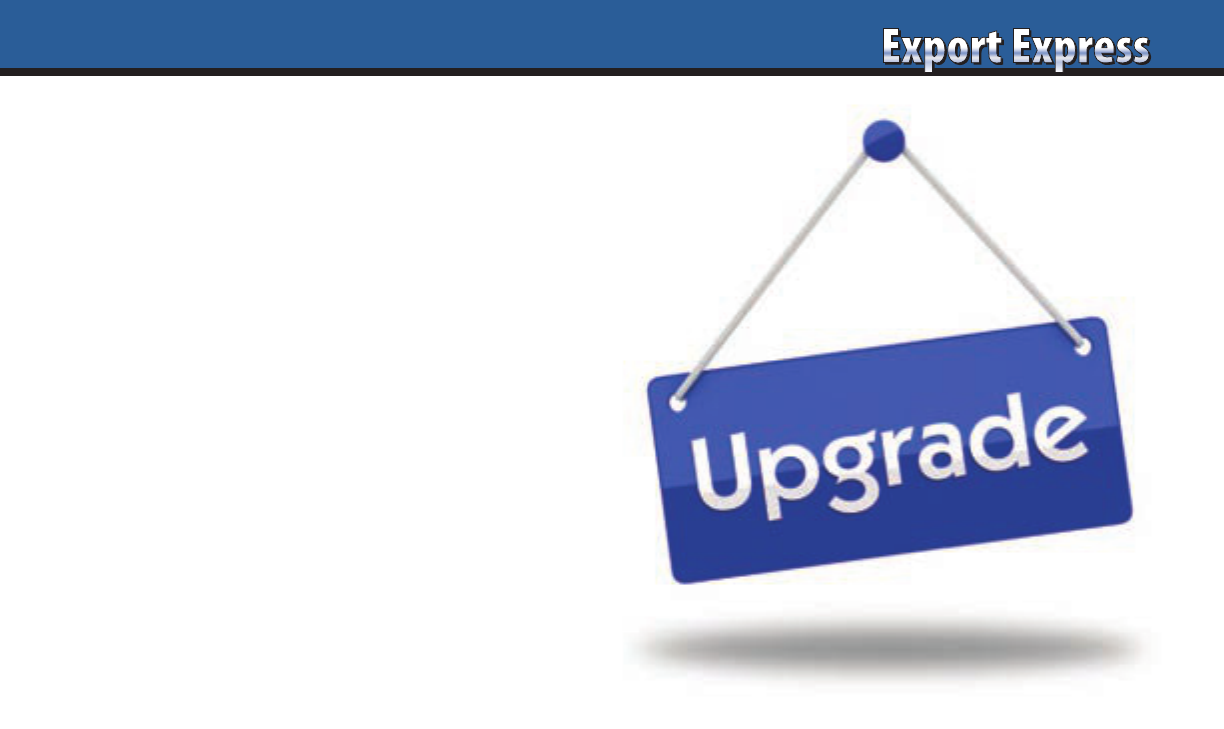
49
A Gentle Approach
Changing distributors is never easy, because we usually like the people involved. Best approach is
to accept part of the blame for the failed relationship. Provide the old distributor a believable sound
byte that he can repeat to maintain dignity in the marketplace: i.e., brand owner was looking for a
distributor with more foodservice or small shop coverage. In the case of a long term partner (5 years or
more), it may be appropriate to offer a lump sum goodwill payment, payable 90 days after transition
in return for their cooperation. The good news is that a new distributor will emerge as motivated
partner, anxious to take a “fresh look at old challenges” and deliver on their commitment to you.
Every company includes distributors
that appear as chronic under-performers.
Year after year, management listens to
excuses and we patiently “give them
a little bit more time.” 2021 results are
in and it’s easy to spot the problems:
big country, small shipments. The new
year is the right time to implement a
process of upgrading your distributor
network to a partner more aligned with
your business goals. Listed below are
key action steps.
New Year’s Resolution -–
Preparing for a Distributor Change
3 Secure agreement from management to change distributors
3 Review your original distributor contract
3 Send official letter to distributor recapping disappointing results
3 Obtain current distributor price calculation
3 Document and monitor inventory in the system, by SKU
3 Watch account receivables and bill-backs
3 Confirm in writing 2022 spending and promotion plan
3 Interview and pre-select an alternate distributor
3 Establish realistic transition timeline with new distributor
3 Advise old distributor of change in person
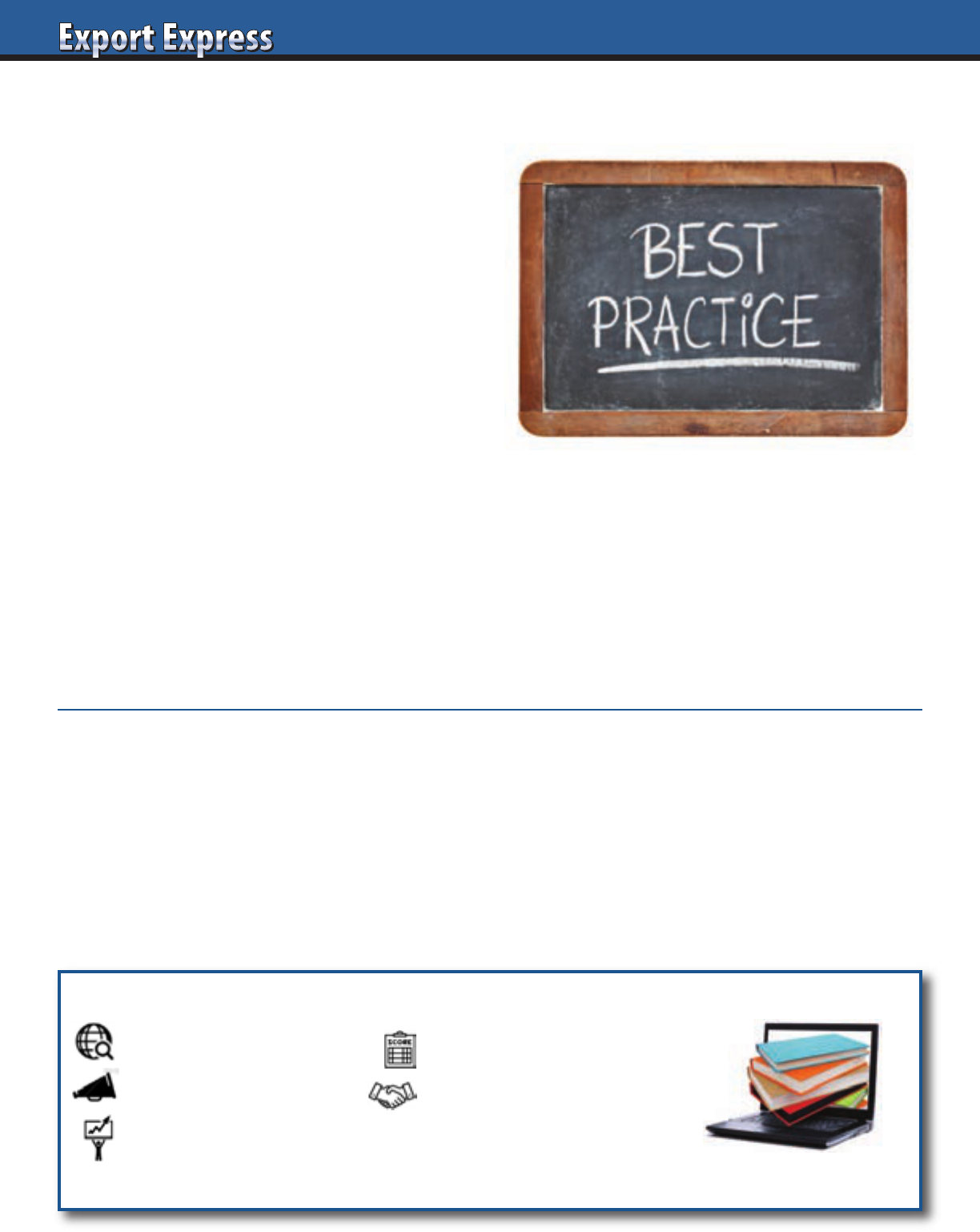
Export Solutions conducts over 100 distributor
interviews/meetings per year. Many distributors ask…
What are these big brands looking for? How do we prepare
a standout presentation? What will it take to win the business?
See our fifteen tips below.
1. Professional Communications: Frequent email communication
in advance. Send re-confirmations. Offer to help with hotel
reservation or pickup. Share mobile contact for emergencies.
2. Creative Welcome: Raise flag from visitor’s country or a banner
with brand name on it. Serve food paired with their brand.
Create immediate “wow!” Skip, if confidential interview.
3. Purchase Product Samples: Potential new brand and
competitors. Supply price for each item.
4. Participants: Owner/MD, sales, marketing, and potential
brand manager. All should have speaking roles.
5. Presentation – Page 1 Company facts: Founding date, sales
revenue, # employees, # field sales, warehouse size, key
categories and principals.
6. Category Sales Data: Try to obtain category sales data from
Nielsen or a leading retailer. Prepare basic analysis.
7. Category Photos and Pricing: Provide recent photos and
pricing from target retailers.
8. Retailer Margins: Share estimated retailer category margins,
cost of entry, and listing fee expectations.
9. New Principal Management: CEO involved in update calls,
retail tracking, and total team approach.
10. Retail Reporting: Demonstrate retail technology and reporting
if you have it. Share sample reports.
11. Warehouse Visit: Short inspection, if located on premise.
12. Social Media and E-Commerce: Share local updates.
Reinforce your capabilities with recent examples.
13. Case Study: Brand owner’s category or aisle. Results
and costs. Show photos of shelf and displays.
14. References: Testimonials are impressive. Executive contact
information from top five current principals represented.
15. Action Steps: Immediate CEO/MD follow up via email.
Deliver presentation stick with your company logo.
Distributors: Fifteen Tips for Winning the Big Brand Interview
5 Questions for Every Interview
1. Where do you see your company’s business in 3 years?
2. Tell me about best practices from a country where your brand
has a high market share. What strategies work well?
3. What characteristics do you see in your best
performing distributors?
4. Are you open to distributor visit (plus customer?) to your
manufacturing facility and corporate headquarters?
5. How do you maintain category leadership?
5 Interview “Bad Practices”
1. Do not send Rolls Royce to pick up brand owner at hotel.
Do not laugh, it happened twice last year!
2. Skip company videos: sends old-school message.
3. Avoid speaking badly about other distributors. Be positive!
4. CEO should not handle entire presentation. Let the “workers”
who handle the day-to-day business speak.
5. No dinner invitation on first date: brand owners will prefer to
meet alone to discuss meetings. Many risks if meal does not
go well. Plenty of time for dinners if you win the interview!
Distributor Search Guide
Export Strategy Guide
Selling to USA Handbook
All guides available free at www.exportsolutions.com in the Export Tips section.
Export Scorecard Guide
New Distributor Cooperation
Model Guide
“From First Meeting to First Order”
Create Your Own Export Library
50
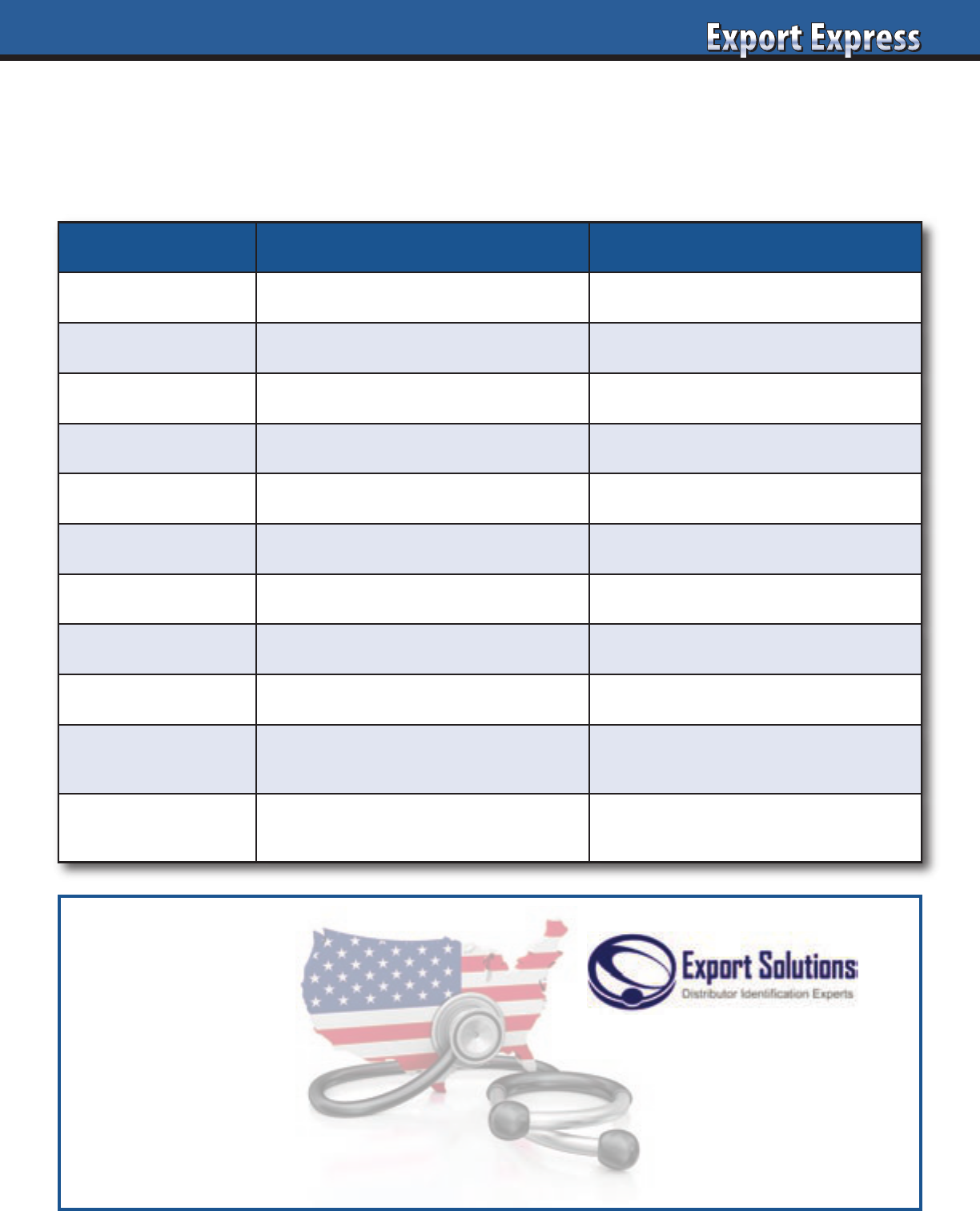
51
USA Sales – Next Level Strategies: 10 Tips
Most European brands remain frustrated by their lack of progress in the USA market. Many companies completed a first step,
with listings at World Market or Eataly (7 stores), but failed to gain traction at big chains with 200+ stores. June Fancy Food optimism
fades by October. Your boss is committed to the USA, but demands better results before bigger investments. What do you do? Call
Export Solutions!
Assessment Area Considerations Insights
Consumer Target
Who is your target consumer? Millennials, foodies, homesick expats
Channel Strategy
Unique strategy required: upscale supermarket,
e-commerce, specialty, and mass retailers
Priority: Upscale supermarkets, gourmet stores,
ethnic stores, e-commerce
Route to Market
Channel, regional, and customer experts required Determine ideal broker profile.
Focus first on good brokers, then buyers.
USA Manager
Mandatory oversight of your USA development Results proportionate to salary.
Locate close to distributor or Atlanta, Chicago
Trade Promotion
Customer specific plan required Invest in strong programs at 10 key retailers.
15% TPR promotions will not excite anyone.
Export Solutions
USA market development helper for
European brands
Point of difference: Retail reality focus.
Targeted, logical road maps. Sales oriented.
Cost to Serve
Implement strategies to reduce price gaps versus
“Made in the USA” products
Evaluate options to create more efficient cost
structure: factory gate to store shelf.
Digital Savvy
What is your social media plan?
How much are you selling through Amazon?
Digital is targeted and cost effective.
Amazon grocery: growing 30% + in USA.
Lessons Learned
What is working? Why has business not scaled?
Barriers to progress?
Independent validation and solutions provided
by USA market expert.
Benchmark Brands
Which overseas brands are winning in USA? Study best practices: Barilla, Bonne Maman,
Colavita, Filippo Berio, Lee Kum Kee, Rana,
San Pellegrino, Walkers Shortbread
Retail Safari
How do I accelerate sales in the USA? Export Solutions retail safari program yields
tailored insights and best practices for succeeding
in the mainstream USA market.
Hire a USA Expert
• USA strategy recommendation
• Category analysis and
plan development
• Identify priority channels,
regions, and retailers
• Brok er/Distributor
identification specialist
• Have a USA pro with 20+ years
experience on your team
Contact Greg Seminara at
discuss your USA development project.
www.exportsolutions.com
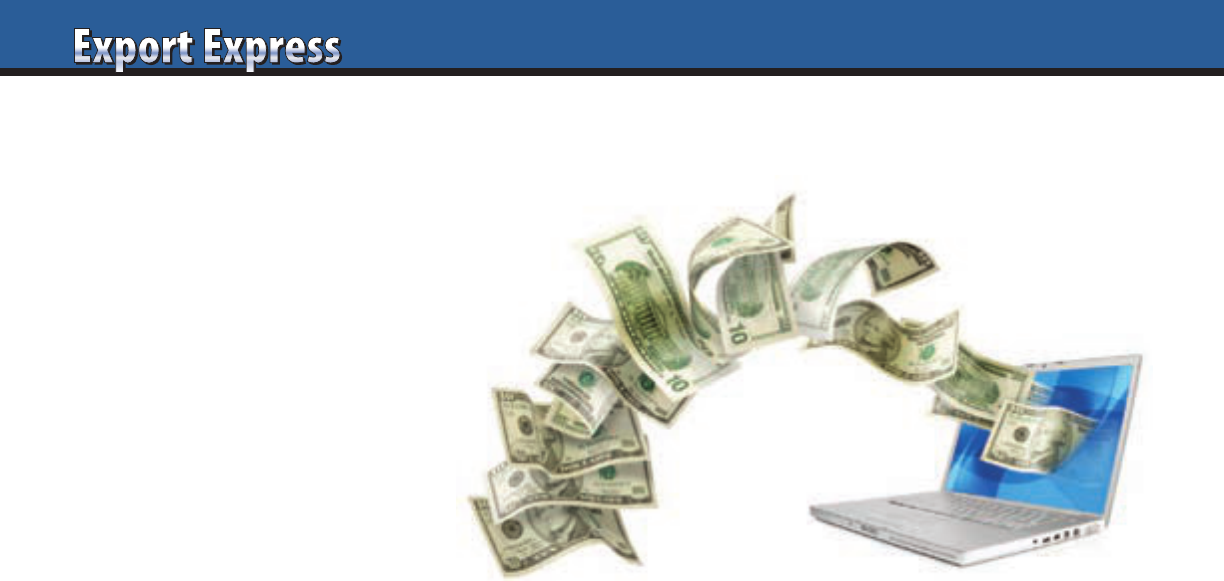
52
Export managers are overwhelmed with
phone calls and emails from companies
desiring to sell their brands. Some
proposals are worth evaluating, as we
all seek incremental sales in new countries.
Other requests originate from diverters or
“time wasters” who do not have sufficient
capabilities or financing to commercialize
your brand. Export Solutions has completed
several projects with brands looking to
streamline the process of filtering
international representation requests.
Listed below are our ten tips for efficiently
identifying serious inquiries from
potential partners.
1. List Current Distributors on your Web Site
This practice provides potential customers
and consumers a local contact for your
brand. It also discourages non productive
calls from other distributors from that
country from contacting you. Distributor
representation information is in the public domain, so web
publication does not breach any confidentiality issues.
2. Export Partner Philosophy Statement
Create a standard letter explaining your criteria for selecting new
partners. Suggested text should include comments like “Brand X
is available in 12 countries and is a leader in the Y segment. We
are looking for established local distributors in certain countries
to participate in the next chapter of our growth. Candidates
should maintain a successful track record pioneering other
international brands and offer a complete portfolio of
importation, supply chain, key account sales, and in store
coverage services.”
3. Distributor Candidate Data Sheet
A one page template captures core information from the
candidate. This template can also be web based and appear on
the “contact” section of your web site. Key inputs include years
in business, company size, web site, number of employees,
and current brands represented. Reference contacts are critical.
A sample Export Distributor Data Sheet can be located at the
bottom of the Export Tips section of the Export Solutions web site.
4. First Response: Send Philosophy Statement & Distributor Data Sheet
Send your philosophy statement and distributor data sheet as
an initial response to all unsolicited phone and email inquiries.
Instruct the candidate to review the philosophy statement and
complete the data sheet if they feel that there is a match with
their capabilities and your company’s export strategy. Inform
them that someone from your export department will contact
them once the data sheet has been 100% completed. A key
learning is that unqualified or “suspicious” candidates will
not complete a data sheet.
5. Post “Distributor Wanted” List
The export page on your web site should list countries where you
are searching for a partner. This listing will encourage inquiries
from target countries and help you “fill in the white space”
in your export coverage map.
6. Reference Check Promising Candidates
My first step is to visit a distributors web site. The second stop
is to review references supplied from other brands on his data
sheet. References listing contacts of export managers for other
leading brands is always a positive indication. A credit check
makes sense, particularly in emerging markets.
7. Watchout #1- Candidate Has No Web Site
This indicates that the distributor or entrepreneur is small or
is possibly making claims that are erroneous or misleading.
Candidates who refuse to provide references from other brands
represented also should be avoided.
8. Watchout #2- All About Low Prices
Warning bells go off from inquiries from companies urgently
focused on obtaining your export price list. I get suspicious of
international distributors volunteering to pick up product at
your factory or those who prefer English language labeled
product even when their native language is different.
9. Due Diligence Questions
What would the distributor launch plan look like if you agreed
to sell to him?
What are the local category dynamics?
What does the price calculation look like?
Can the candidate share a success story for another brand from
your country?
10. Invite Serious Candidates to Your Headquarters
The preferred option is to visit a distributor in his home market
to see his operation. This is not always possible, particularly for
small or remote countries. A visit by a pre-screened candidate
signals interest and initiative on their part.
Export Solutions’ database covers 9,200 distributors in 96
countries. This serves as a quick reference tool to check the
validity and credentials of a potential distributor candidate.
Ten Tips – Translating Export Inquiries into Incremental Sales
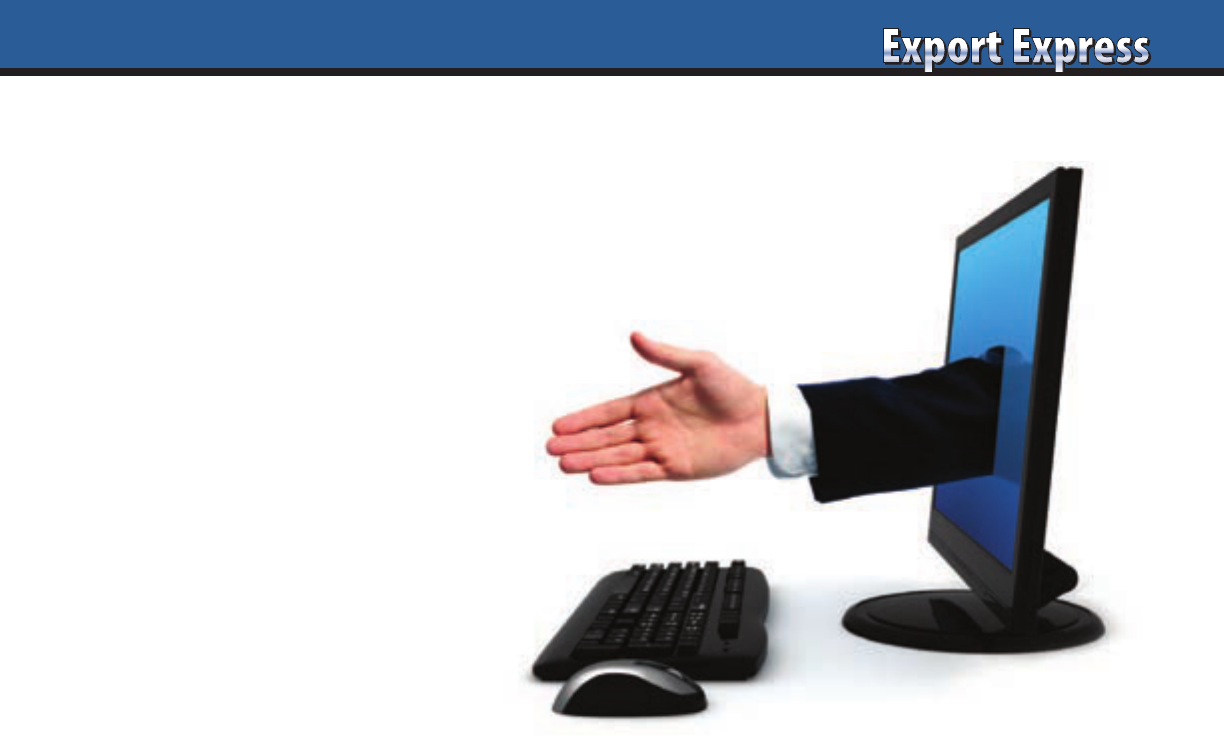
53
Savvy exporters deploy modern
web based tactics to identify new
distributors and connect with global
consumers. Most companies maintain
a basic web site featuring an
“international section,” but few sites
are designed to promote export sales.
Listed below are Export Solutions
“Ten Tips” to unleash the power of
Web 2.0 to drive new business in 2022.
1. Language Translation Software
increases your Reach
Popular software from Babel Fish or
Google can be installed on your site
to translate your International page
to multiple languages. These tools
provide instant translations without
formal redesign of the web page.
2. Code Your Site for
Tracking Analytics
Available reports measure visitors by
city/country, time spent per page, and
key search phrases driving web traffic.
Search Engine Optimization (SEO)
raises your ranking with Google.
3. List Current Distributor Contacts
This makes it easier for potential customers and consumers to
locate your brand in their home country. The distributor listing
on your web page also reduces distributor inquiries from
countries where you already have a partner.
4. Distributor Wanted Postings
Define countries where you are searching for a partner. Your
“Distributor Wanted” section should sync with your Companies
Distributor Selection Criteria. A sample statement could outline
basic requirements such as “Beverage Company A seeks partners
with significant beverage category expertise and demonstrated
success marketing other international beverage brands.
Distributor can-didates must be highly motivated with
countrywide coverage across all trade channels.”
5. Automate Process to Capture Distributor
Candidate Credentials
Create an online template to summarize a new distributor
candidate’s basic information: Com-pany size, current brands
represented, references, web site etc. Alternatively, you can
develop a process to auto-matically email a similar template
to interested candidates. Create an email box called
6. Establish an Intranet Portal for Existing Distributors
This password protected gateway serves as an entry point to
a data warehouse of information. The Intranet could include
product catalog, brand images, syndicated data, presentations,
and a chat function to share ideas.
7. List Local Retailers Stocking Your Product
Basic approaches include a simple drop down menu
stating now available at with names and/or logos of leading
customers. Advanced applications include ability for consumers
to search for retail stockists by postal code.
8. Product Request Form
An online product request form captures names and contacts
of consumers interested in your brand. This information can be
used to prioritize export expansion areas measured by level of
inquiries. Upon entry into a new country, the product request
data facilitates targeted marketing or to demon-strate to a
retailer a level of existing consumer interest.
9. Publish an International Newsletter
This newsletter may share new product information,
success stories, recipes, contests, or any other method to create
engagement with distributors, retailers, and consumers. Tools
such as Constant Contact make creation and delivery of online
newsletters simple and cost effective.
10. Photos Add a Personal Touch
Pictures of the Export department team members add life to the
international web page, particularly for small-mid size exporters.
Other web pages include photo’s of the “Distributor of the Year”
or senior manager visits to international markets.
Web 2.0 – Your New Export Sales Partner
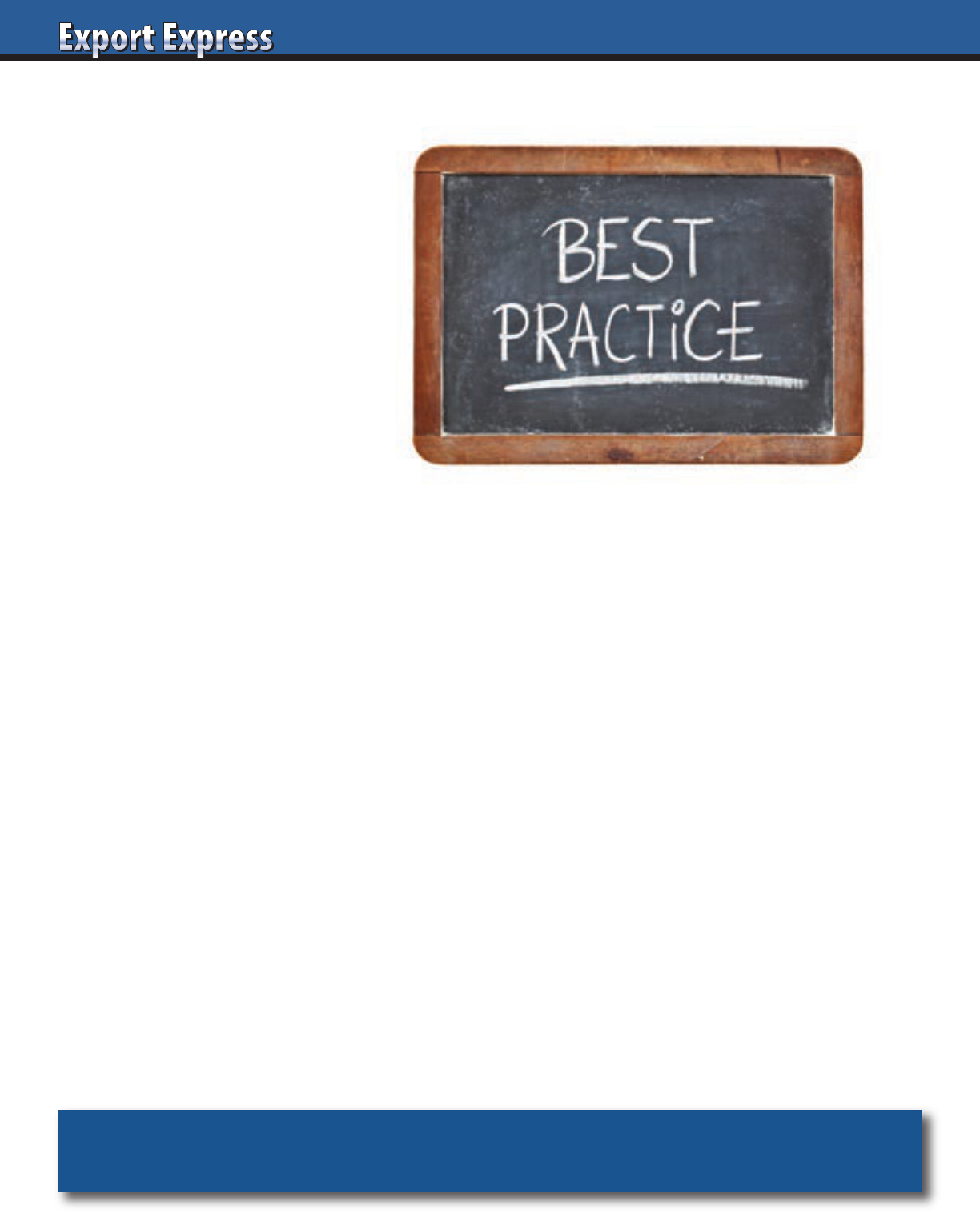
54
1. Extensive Due Diligence
on all New Distributors
Visit each new distributor’s office and
warehouse to calibrate the size of his
business with other principals. This
includes reference checks from existing
manufacturer clients as well as from
leading retailers in his home country.
Run a Dun & Bradstreet or Equifax
financial report.
2.Design a Distributor Fact Sheet
Require each potential distributor
candidate to complete a one page
template recapping their capabilities.
Pay particular attention to sales
turnover, number of employees,
and references from existing
brands handled.
3. Ship Directly to Distributor
in his Home Country
Do not allow for distributor sponsored
consolidation at a USA port such as
Jersey City, Miami, or Los Angeles
during the initial launch phase. Allow
distributor pick-up at your factory only
after your relationship and brand have
been established for a year or more.
4. Label your Product in the Local Language
Stickering is acceptable only if it is done
in the destination country or at your
own in-house contractor.
5. Sell Only to Distributors Based
in your Target Country
Avoid shipping product to foreign
distributors with offices and
warehouses in your own county.
The goods have little incentive to leave
local ports. Export Solutions Distributor
Directory contains more than 9,200 local
distributors in 96 countries.
6. Create an “International Package”
This could be multilingual label or a
different size. One tactic is to label
packs “Export Only.” This reduces the
risk of it being diverted back to the
domestic market.
7. Establish an International Price Structure
A model could consist of export base price
plus freight charges. This prevents one
country from enjoying a price advantage.
8. Don’t Believe Stories About Cruise Ships
and Mining Camps
Sophisticated diverters come up with
elaborate stories to convince you that
your product will be sold to legitimate
outlets. Is it really worth the risk?
9. Analyze Orders Versus Size of Country
Leverage technology to alert you to
unusual order patterns outside of
historical trends. Believe me, it is not
possible that Greece or Bermuda are
selling that much product! Analyze
Nielsen consumption data versus
shipments to the market, if possible.
10. Unannounced International Market Visits
Check retail outlets independently,
without a distributor “tour guide” to
confirm a problem. Visit distributor
warehouses with short lead time to
check inventory. Recently, I visited
a distributor claiming to represent
famous brands and found that many
were missing from his warehouse or
had less than 30 cases of stock.
11. Avoid Risky Countries with Low GDP
I am naturally suspicious about
distributor orders from poor African
nations, Jordan, Haiti, or Belize.
Realistically, how many consumers in
these countries can afford premium
European or USA brands?
12. Watch Out: No Web Site
Perform a Google search on a new
distributor. Virtually all serious
companies have web sites or some
internet references. A distributor without
a web site in 2022 is either hiding
something or too unsophisticated to
grow your business. Also, beware of
generic web sites that do not show basic
information like brands represented.
There are exceptions, but lack of a web
site sets off alarm bells.
Export diverting is a serious issue at
many companies causing distrust and
lack of support for export programs. I
admire producers that regularly follow
the practices described above to “weed
out” questionable distributors. When
in doubt, offer the distributor your
standard list price from your home
country. Good luck!
Twelve Tips to Derail Export Diverting
Need a hand? Visit www.exportsolutions.com.
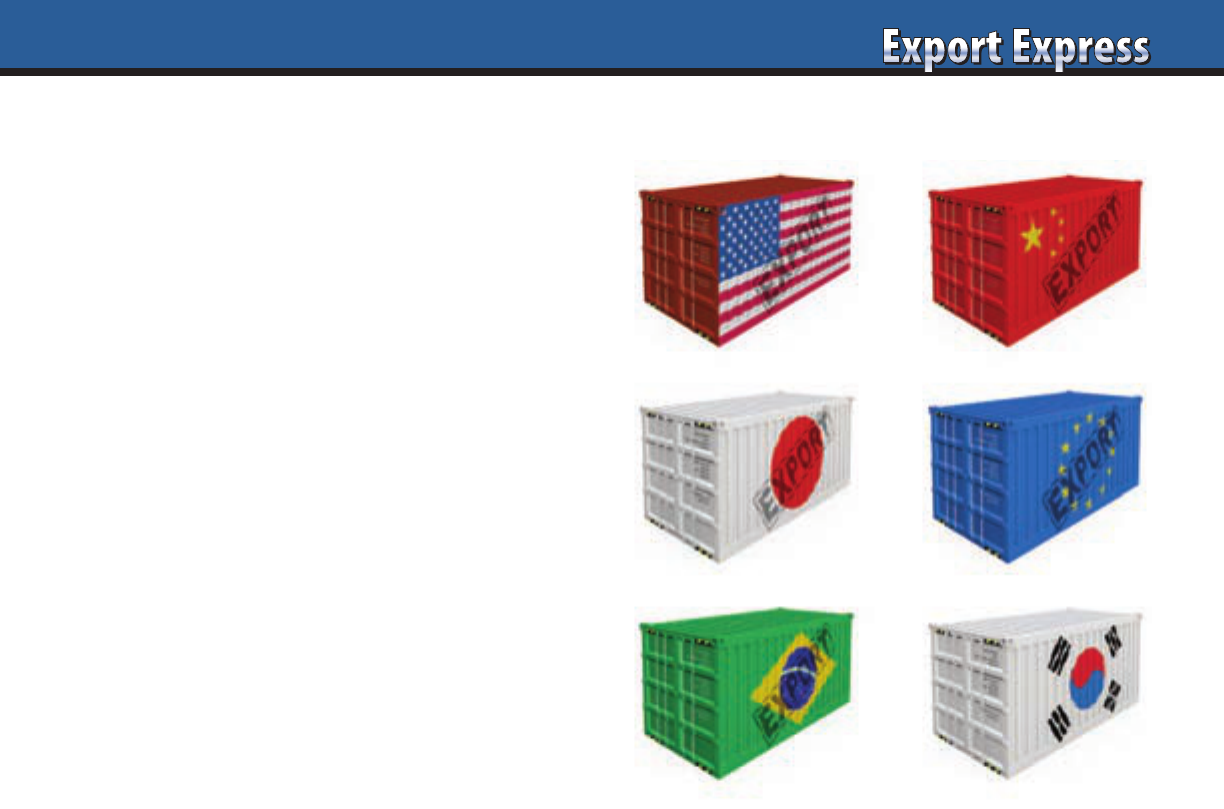
55
Most companies partner with consolidators to source incremental
business from tough to reach geographies. Consolidators are local
companies that group different products from one country into
one container. The consolidator then sells to a list of customers
that may include distributors and retailers. Consolidator business
is typically easier to handle, as you ship existing packages to a
warehouse in your home country and receive payment in local
currency. This practice generally functions well, but you must
balance additional shipments with “loss of control” and
“diverting risk.” Below are Export Solutions’ “Ten Tips”
for building your business through consolidators.
1. Use Consolidators!
Consolidators represent an efficient route to market for new
exporters, niche brands, or for hard to access regions such as
the Middle East.
2. Fee Structure
Consolidators need to make money too! Normally, their fee is
built into a cost calculation to the retailer or offshore distributor.
10% is an average consolidator margin, but there are many
variables. Note that the consolidator margin plus an extra
logistics stop will ultimately drive your price 15% higher to
the consumer than a “direct to distributor” model.
3. Avoid Region Wide Appointments
Consolidators serve as options for islands in the Caribbean or
small countries in the Middle East. However, you should rarely
give them responsibility for bigger markets like Saudi Arabia or
Puerto Rico. Better to deal directly with distributors in strategic
countries. Use the cost differential to invest in brand building
or lower retail prices.
4. Pricing
Typical pricing to consolidators is around 90% of standard list
price. This will provide a discount to compensate for promotion
pricing activity, but not a wide enough gap to risk diverting.
Good consolidator partners will share a transparent price
calculation model from factory gate to overseas store shelves.
5. Which Distributors Form the Consolidators Customer Network?
Part of your assessment process will be to analyze representative
distributors used by a consolidator. You need to decide if the
consolidator’s typical partners are a good fit with your brand
representation requirements. Note: some consolidators “guard”
their distributor lists. However, understanding their customers
is a critical step in assessing their capabilities.
6. Reference Check New Consolidators
It is a standard practice to reference check consolidators. Many
will accurately claim representation of famous brands. However,
the scope of partnership may actually be quite limited. Ask
references about years of partnership, results, and
countries/brands in the consolidator coverage agreement.
7. Mark Packages “For Export Only”
Diverting discussions are significant distractions for most export
managers. Consolidators may be tempted to divert, as they
typically purchase standard packages and receive delivery in
the home country. Labeling packages “For Export Only” or
even “Export” diminish the likelihood that your brand will
be diverted and reduce complaints and accusations from your
national sales team.
8. Beware of Local Laws
Consolidators are an integrated solution, which eliminates
measurable paperwork and stress from an export program.
However, this does not release the brand owner from obligations
to comply with local laws on labeling and distributor contracts.
Naturally, you should also maintain a contract with your
consolidator to guide terms and conditions of your relationship.
9. Request Listing Maps
A frequent complaint is that manufacturer’s lose control of their
export business when dealing with a consolidator. Brands receive
market level shipment reports at best, with limited or no data on
listings by retailer, pricing, or merchandising activity. Request
that your consolidator provide a “Listing Map,” by country at
least twice per year.
10. Periodic Visits to Consolidator Territory
Export managers should conduct market visits to leading
countries managed by their consolidator. Check stores, meet
with distributors, understand growth opportunities. These
programmed visits are likely to be positive, but send a signal
to the consolidator that you are an active partner.
Ten Tips: Best Practices for Using Consolidators
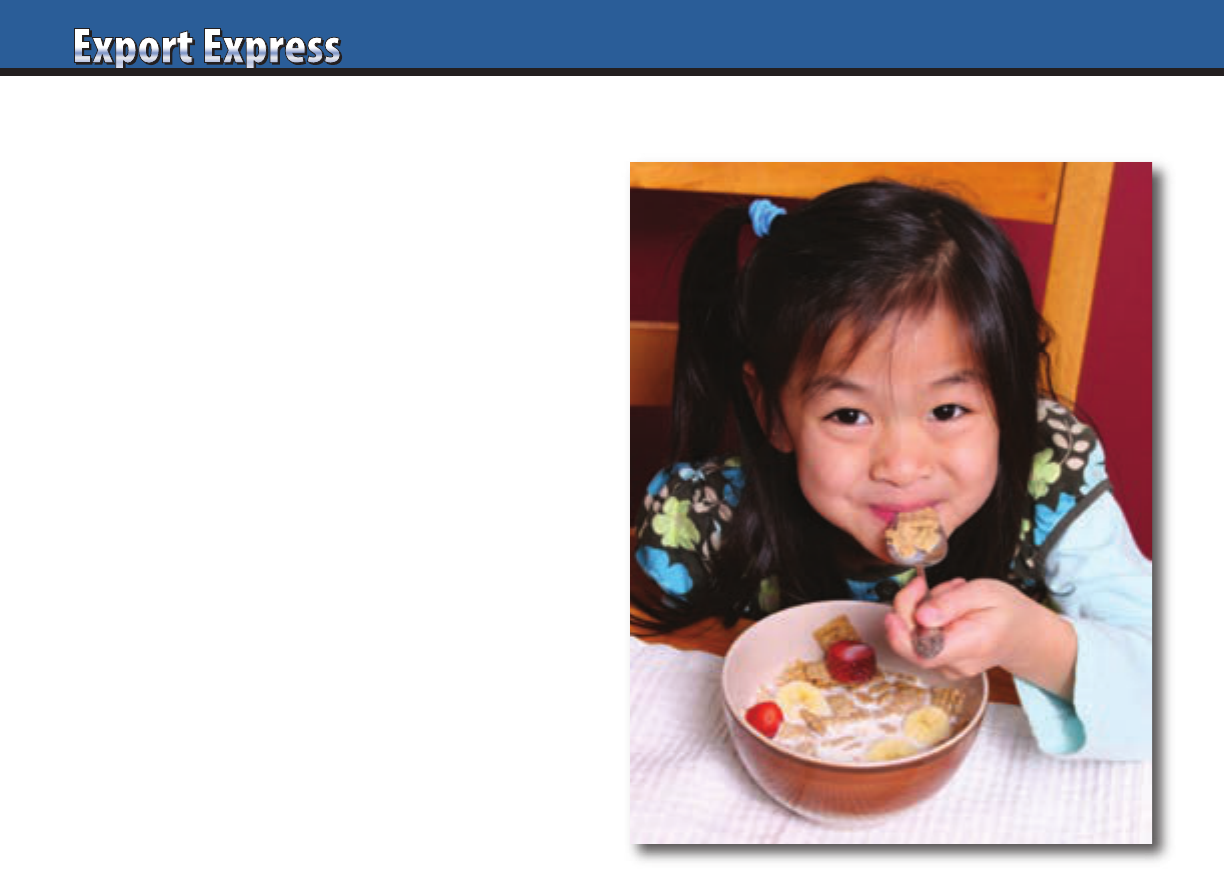
56
International brands find a
natural audience overseas with
homesick expatriates missing
their favorite Oreo cookies,
PG Tips tea or Kuchenmeister
cakes. “Ethnic” favorites must
move beyond their base
business as a niche American,
Italian, or German product
into the mainstream to achieve
ambitious growth targets.
Adoption as a local brand
rewards the manufacturer
with dramatically higher
sales. My Irish wife swore that
American icons such as Heinz
and Kellogg’s were British
brands because their labels
stated “by appointment to
Her Majesty the Queen.” It
was probably the one time
in our marriage when I was
actually right. Listed below
are my Ten Tips for Making a
Global Brand a local “hero.”
1. Manufacture in Country
Pride is generated when a
brand is produced locally.
The factory employs people
from the neighborhood
and spends money in the
community. It may be costly
to open a dedicated plant,
but co-packing is usually an
option. This approach may
also generate cost savings
through the elimination of
duties and overseas freight.
2. Label in Local Language
Frequently a manufacturer
cuts corners by placing a
sticker on a package or other
minor fine tuning to comply
with labeling laws. Producing
your brand with local labeling
sends a powerful message to
the trade and consumer about
your interest in their business.
Warning! Display care with
translations to avoid
embarrassing mistakes.
Google “Nova Spanish” if
you need an example.
3. Promote Recipes Using
Your Brand
A food scientist or market
research company could
study local food preferences
and your product portfolio.
Are there options to
incorporate your brand into
traditional recipes? Nutella
is finally gaining important
traction in the USA as a
breakfast spread, after years
of niche status.
4. Create an Anniversary Event
Many brands have been
available in foreign markets
for 10, 20, 30 years or more.
Why not design an anniversary
event commemorating
“25 years in the ______
Market.” Elements could
include special packages,
consumer contest, public
relations, charitable donations,
and a celebratory dinner for
your retail customers.
5. Sponsor a Sports Team
Fans everywhere love their
teams. Alignment and
support of a local sports team
yields dividends. A starting
place may be sponsorship of
youth leagues versus budget
busting football deals.
6. Core Brand –
Market Specific Line Extension
Consider adapting your core
product line to meet local
flavor preferences. Pringles
built exceptional sales and
excitement by launching
innovative new flavors such
as Jalapeno, Curry, Grilled
Shrimp, Ketchup, and Pizza.
7. Sponsor a Charity Event
There are many worthy
organizations looking for
financial support for their
programs. Normally, there are
chances to gain visibility for
your brand with sponsorship
of an event. Pick a group that
contains a meaningful link
to your product or target
consumer. Many supermarket
chains have a favorite charity
providing a route to collaborate
with a trading partner for a
worthwhile cause.
8. Co-Promotion or
Co-Branding with Local Leader
Partner with a traditional
local brand that has a long
history in the market. For
example, an international
cereal brand could align
with a local milk producer.
Similarly, an international jam
or marmalade brand might
consider a joint event with
a leading bread company. Co-
branding is also a possibility,
but reflects a long term
commitment. For example,
Post cereals markets a version
of their famous Raisin Bran
cereal which includes
authentic Sun-Maid raisins.
9. Billboards and Radio Viewed
as Local Media
Advertising or public
relations agencies are experts
at creating campaigns to build
brand equity. Billboards and
radio offer local execution
and adaptation possibilities.
10. Brainstorm with
your Distributor
Distributors are local
marketing experts with
a rich understanding of
market and consumer
dynamics in their country.
Schedule an “off site”
meeting in a peaceful
location to brainstorm
ideas for raising your brands
profile with local consumers.
This approach secures
distributor participation and
ownership of the program.
The evolution of an
international brand from
niche curiosity to local
favorite requires time,
energy, and investment.
However, each activity will
bring a step change in terms
of local brand acceptance
and sales. What can you
do differently in 2022 to
increase your brands local
profile in export markets?
Ten Tips: Making a Global Brand Local
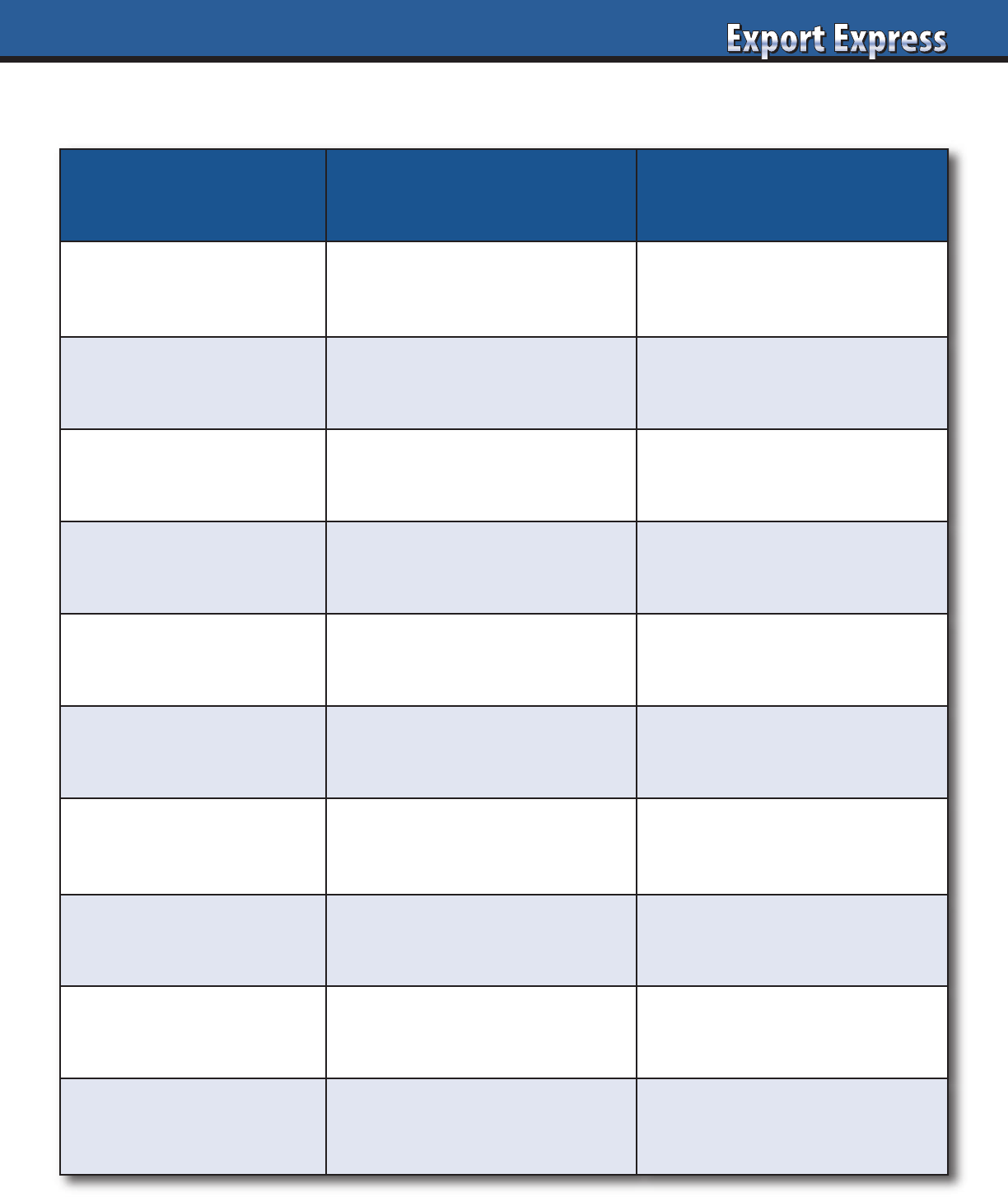
57
Recipe: Best in Class Partnerships*
Ingredient Brand Owner Distributor
Results
Realistic expectations based upon
investment/market conditions.
Achieve sales increase in excess
of overall market growth.
Category Expertise
Share knowledge, trends,
and category analysis.
Serve as local category expert.
Educate the buyer.
Innovation
Contantly deliver important
new product ideas to market.
Successfully launch new products
into the market.
Investment
Appropriate Investment levels:
marketing/trade promotion.
Optimize return on investment.
Store Presence
Create clear, realistic guidelines
for in-store presence.
Share of shelf exceeds market
share. Maximize visibility.
Ideas
Support market driven ideas to
build the business.
Relentless pursuit of new and
better ways to grow sales.
Reporting
Concentrate on Basics: Listing
Map, Pricing, Merchandising Plan.
Complete reports accurately
and on time.
Focus
Periodic market visits and “rapid
response” to issues.
Appropriate level based upon
brand size and opportunity.
Cost to Serve
Remember that distributors need
to make money too!
Fair margin based upon brand
size and complexity.
Recognition
#1 Fan. Frequent recognition of
good results by all team members.
Strong commitment to exceed
expectations everyday.
*Mix Well for Best Results
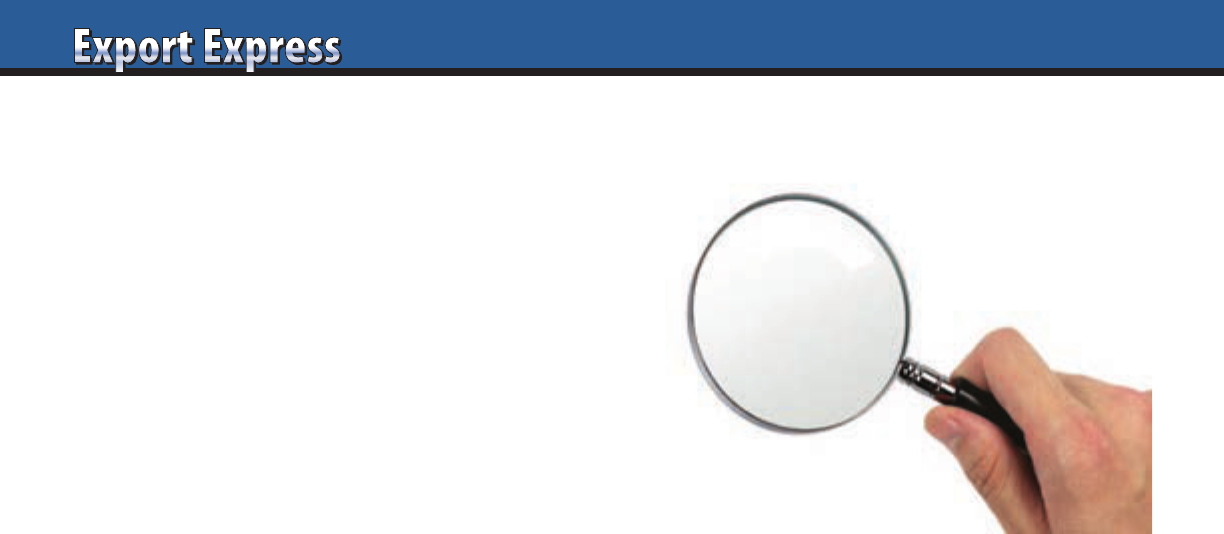
58
How many emails do you receive a week from “distributors”
wishing to represent your brand? How much of your trade
show time is wasted on impromptu meetings with enthusiastic
“traders” who make bold promises, but never order? Why are
we surprised when you search these companies on the internet
to discover there is no information or a web site “under
construction?” Many companies’ distributor networks contain
these small, anonymous distributors who aggressively pursued
a famous brand, but rarely deliver. Give them an “A” for effort,
but distributor search must include proper due diligence of all
potential candidates, not just the small one chasing you.
Do you believe that the best distributors are waiting in line
at trade shows or speed dialing export managers? The most
powerful distributors are busy building brands for their existing
partners. However, all distributors are open to representation of
new companies. In fact, many of the more strategic distributors
assign a brand manager to new business development. This
senior person is dedicated to evaluating new company
representation inquiries like yours.
Hiring the right local partner is the third most important step
in optimizing your sales. This follows creating a differentiated
product and willingness to invest in marketing support. Listed
below are some practical tips on selecting the right company to
optimize your business in a new country.
Identify a Pool of Preliminary Candidates
Create a large group of potential candidates. This could include
distributors or local producers of related products. Include
qualified candidates that have emailed or visited at a trade fair.
Highlight companies that are specialists in the market sector that
you are aiming at. Export Solutions streamlines this process with
our industry leading distributor database containing an average
of 85 distributors (large and small) per country.
Establish Partner Selection Criteria
What are the key attributes of your most successful distributors?
Category specialization? Multi channel coverage? Synergy with
related brands? Choosing a large “Best in Class” partner versus
a “Small, Hungry” company willing to pioneer a new brand is
an important preference.
Determine Candidates Preliminary Interest Level
Send a brief summary of your product proposition and company
credentials to the 5-10 most promising candidates. An immediate
follow-up phone call to your top candidates is an appropriate
personal connection. Distributors expressing an interest should
complete a brief company overview recapping their corporate
capabilities: Sales, Coverage, Key Principals, etc.
Schedule a Meeting in the Candidate’s Office
Interview at least three candidates depending on the size
and scope of a project. Schedule the meeting 4-6 weeks in
advance. Provide a specific agenda at least 3 weeks in advance,
including pre-work such as category market analysis. Meet the
distributor’s team that would work on your business, as well
as senior management. A distributor’s office provides clues
on company culture, scale, and capabilities.
Prepare Distributor Assessment Grid
Create a list of key questions to ask each candidate. Topics could
include local category dynamics, cost of entry, and distributor
success stories. Create a standard grid to evaluate and compare
all candidates on a common platform. Contact us for our free
Distributor Search Guide with assessment grids, agendas,
sample questions and templates for every aspect of the
distributor search process.
Independent Evaluation of Candidates Performance for Existing Brands
Visit supermarkets and other retailers to observe category
conditions. At the same time, evaluate each candidate’s
performance for his existing clients. Do his current brands
maintain a strong presence in the market? Or are his brands hard
to find on the shelf? Complete these visits to leading retailers
independently, as an accompanied trip may lead you to check
stores which may not be representative of marketplace reality.
What is the Distributor’s Plan?
If selected, what is the distributors Year One plan? Customer
targets, price calculation, marketing plan, volume expectations?
Timeline and benchmarks? Key issues? Resources required?
Does their plan align with your vision and the size of the
market opportunity?
Reference Checks Represent an Important Next Step
Request references of 5 of the distributors top 10 clients. Call
at least three references and request insights into performance
and capabilities. Acknowledge that these are likely to be positive
references, but they always provide significant value. Run a Dun
& Bradstreet or other type of credit report on leading candidates.
Future
Companies conduct rigorous assessments before hiring new
employees. A higher level of intensity must be displayed during
the distributor search process When you choose a distributor,
you are selecting a whole team to represent your company in
a country, not just one individual.
Export Solutions’ Motto:
Select your distributors, do not let
your distributors select you.
Select Your Distributors, Do Not Let Your Distributors Select You!
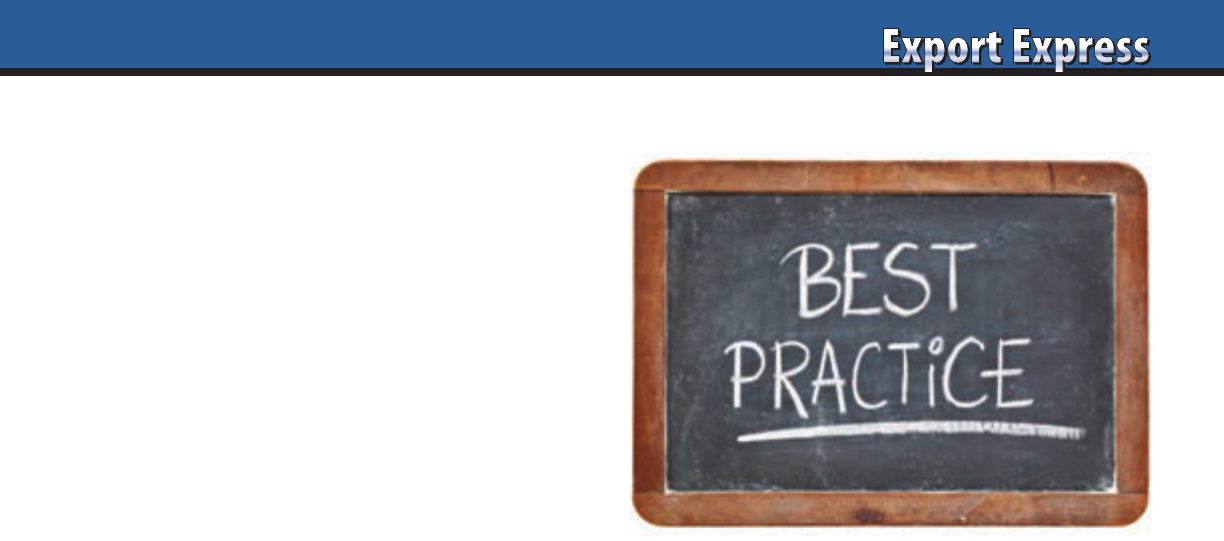
59
How often do you visit your distributor’s warehouse?
Brand owners should inspect their distributor’s warehouse
at least once per year and always before the start of a
new business partnership. Warehouses serve as the
nurseries/creches for where our precious new products
are stored while the commercial team generates sales.
Warehouse managers are custodians of our sales inventory
and companies need to insure that their brands are in good
hands while awaiting sales.
Listed below are 10 Tips on productive distributor
warehouse visits.
1. Confirm Accurate Stock Levels for Your Brands
Does warehouse inventory reconcile with distributor stock
reports? How many cases are there versus agreed to weeks
supply targets? Six to eight weeks of stock is typical for
overseas brands. Walk down every aisle and check every
one of your SKU’s.
2. Identify Problems
A warehouse visit may reveal overstock or understock
conditions. Similarly, you may spot a case of poor sales
rotation or goods approaching expiration date. A common
problem is the discovery that a warehouse may not adhere
to a “first in, first out” method of stock rotation. Examine
cases to look for damaged goods.
3. Warehouse = Window Into Distributor’s Real Business
Warehouse inventory levels paint an accurate picture of
the distributor’s real business profile, not what the pretty
PowerPoint presentation tells you. What brands are stocked?
What are they selling? I remember one distributor interview
included bold claims about representation of famous
companies. The warehouse revealed one pallet of one small
SKU from the famous manufacturer. Another interview for
a distributor claimed representation of fifty world famous
brands. The warehouse check showed that 50% of business
was on a local commodity item and most of the foreign brands
had only 20-30 cases of stock.
4. Outsourced Logistics Providers
In certain countries, distributors outsource logistics to
another third-party provider. This is a mixed message for a
manufacturer. From one standpoint, this frees up distributor
management time to focus on brand building. Also, there are
excellent logistics providers that specialize in “best in class”
practices. On the other hand, the distributor has sold his
logistics contract, sourcing a fat fee for his business. Also the
external logistics provider needs to make a profit, so you wind
up with another margin line item in your calculation. Request
a warehouse inspection, even if it is managed by a third party.
5. Get to Know the Warehouse Manager
Every business runs into supply chain problems at some
point in time and its positive to know the person in charge.
Bring him a shirt or other gift with your company logo and he
will be your friend for life (or at least until the next problem!).
6. What are Distributor’s Service Levels?
Most buyer’s first concern is sales rotation. Their second
metric is service levels such as stock levels, fill rate, and
inventory turns. Your distributor’s adherence to retailer’s
supply chain scorecard objectives reflects on your brand, sales
performance, and distributor’s reliability as a provider. What
are the distributor’s KPI’s? Are they tracked automatically or
manually? How are they doing?
7. Appearances Count!
Is the warehouse clean or dirty? Does it appear to be logically
organized? Is it busy or “asleep?” These clues send an
important message on the overall status and culture of your
distributor partner.
8. Understand Distributor Value Added Services
Many distributors provide value added services in their
warehouse. This may include creation of promotion packs,
stickering or special pack displays. You may discover
distributor capabilities that you were not aware of.
9. The Heat Is On?
Products require different storage conditions. Obviously
frozen and chilled items require temperature control.
Confectionery products require different climate standards.
Health and personal care items may ship in units versus cases.
In other situations products like insecticides cannot be stored
(or shipped) with food products. What is the compliance level
versus the storage standards for your products?
10. Alignment With Expectations
Ultimately, a successful warehouse visit should match your
business and expectations. If business is good, the visit
demonstrates your interest in the distributor’s total company
and team. Request a visit just to say “thanks.” If your business
is declining, the warehouse is a perfect place to dig into what
the real situation is at the distributor. Sales to the customer
begin the moment your brand leaves the distributor
warehouse floor. A periodic inspection will insure that your
brand looks its best in transit to the store shelf.
10 Tips: Mandatory Distributor Warehouse Visit
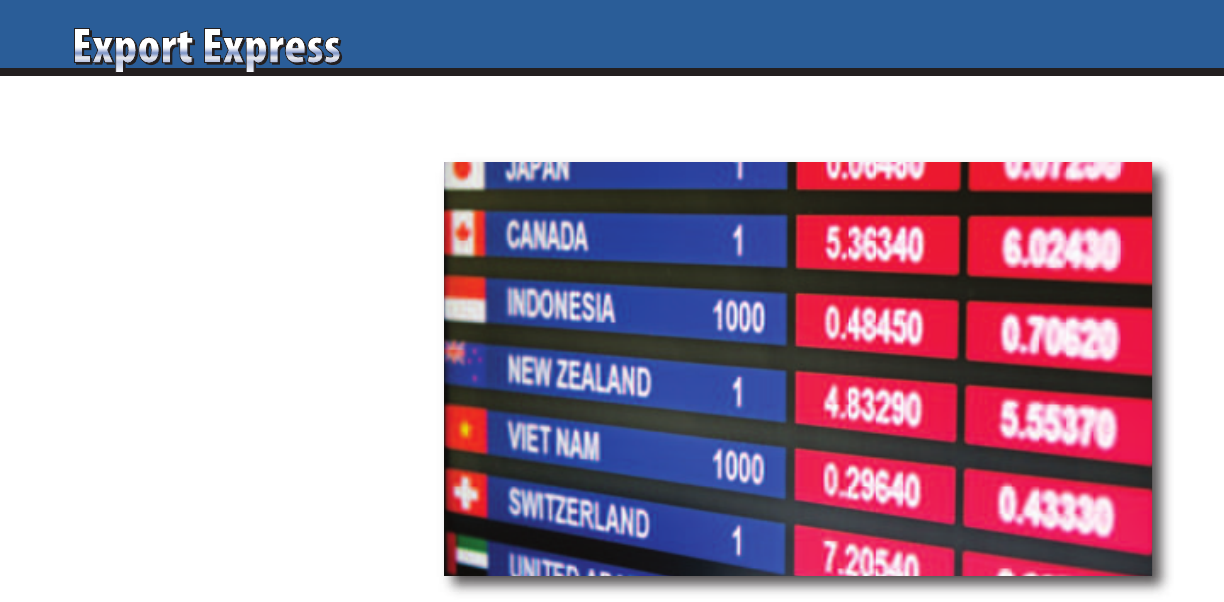
60
Dramatic currency gyrations wreak
havoc with retail pricing around the globe.
Strong USA dollar, weaker Euro, devalued
China RMB, and cratering pound. These
lightning fast moves on currency
exchange may require six months or more
to wind their way through the supply
chain. Some distributors devote more time
to serving as f/x traders versus brand
builders. Unfortunately, most export
managers are distanced from the problem
until receiving an urgent call from a
distributor who faces passing on a 10-20
percent price increase to his customers.
Listed below are Export Solutions’ “tough
tactics for tumultuous times.”
Higher Prices Mean Lower Volume
Emerging market currencies usually
move in a weaker direction. This
translates to higher shelf prices. Citizens
in these economies rarely experience wage
increases in parallel with inflation. Most
consumers tend to reduce purchases of
overseas products as they become luxury
items. Exporters need to calibrate “how
much pain” they are willing to endure
in terms of lower volume.
Prices Only Go Up, Never Down
Permanent price declines or rollbacks
are extraordinarily difficult to execute.
If your currency weakens, retailers and
distributors don’t pass on lower net cost.
It is common practice for them to try to
maintain retail shelf prices and capture
extra margin. Savvy brand owners skip
the price rollback and invest in heavier
promotion levels or enjoy higher profits.
Conduct Monthly Price Surveys
In countries of extreme price fluctuation,
best to schedule monthly price surveys of
your brand and the competition. Request
that distributors use the same store base
every month to avoid regional differences.
Online grocers allow us to monitor
country pricing from our desktops,
miles away from overseas markets.
Retailers: Once Per Year Price Increases
Many retailers accept price increases
only one time per year. This may occur
in conjunction with annual negotiations.
Other retailers demand ninety days
advance notice. Sometimes “borderline”
brands encounter customers who simply
refuse to accept price increases.
Ultimately, this puts tremendous pressure
on distributors who may be facing price
increases from multiple suppliers.
What’s Fair? – Peg Rate
I advocate a model where currency
is pegged to an exchange rate at the
beginning of the year. Distributor and
brand owner agree to “swallow” price
swings of the five percent in either direction
of the peg. If the currency breaches five
percent threshold, then both parties review
the formula and assess options.
Bank Rate Versus Distributor Rate
A key metric to investigate is the
distributor exchange rate in his
calculation versus the actual bank
rate. Many distributors seek to insulate
themselves by building in a five to ten
percent protective cushion. Guess what?
If the currency doesn’t move, the
distributor just made an extra five
to ten percent on your brand, starting
from the landed cost line!
Sell in Local Currency
This forces large manufacturers to accept
the risk or benefit. This insulates smaller
distributors who may not enjoy similar
capital reserves as their larger principals.
This approach works especially well with
European brands selling to the USA or
vice versa.
Competitive Activity
Frequently, all category players
experience similar input cost increases
such as raw materials. Competitors may
use the window to hold prices low to
gain market share. Others may eliminate
promotional spending. Ultimately brands
elect a certain price positioning in a
country and should strive to stay within
the desired range.
Document Price Change Rationale
Retailers provide strict challenges to those
requesting price increases. Supply them
with hard facts on costs of raw material,
currency exchange, transportation and
other factors. Retailers with substantial
private label programs face similar
pressures on their own private label,
so they are not blind to the situation.
Watch Credit/Receivables
Distributors pay their suppliers in
advance of receiving payment from
local customers. Distributors invoice in
local currency and wait for repayment.
During periods of currency fluctuation,
the typical sixty day float could result in
a five percent reduction in receivables.
Across a broad portfolio of brands, this
could spell trouble for a distributor.
Run credit reports and monitor days
outstanding trends.
“Helpers” are Heroes
A trusted distributor who has delivered
consistent results is worthy of your help!
In the past, I have witnessed the USA
dollar appreciate more than fifteen
percent versus the Mexican peso and
Canadian dollar. Best approach is for
both partners to “roll up their sleeves”
and engage in an open discussion around
transparent examination of the facts.
Distributors are entitled to a reasonable
profit. A manufacturer who helps absorb
the pain during a “currency crisis” will
be remembered as a true partner when
the situation stabilizes.
Currency Exchange – Tough Tactics for Tumultuous Times
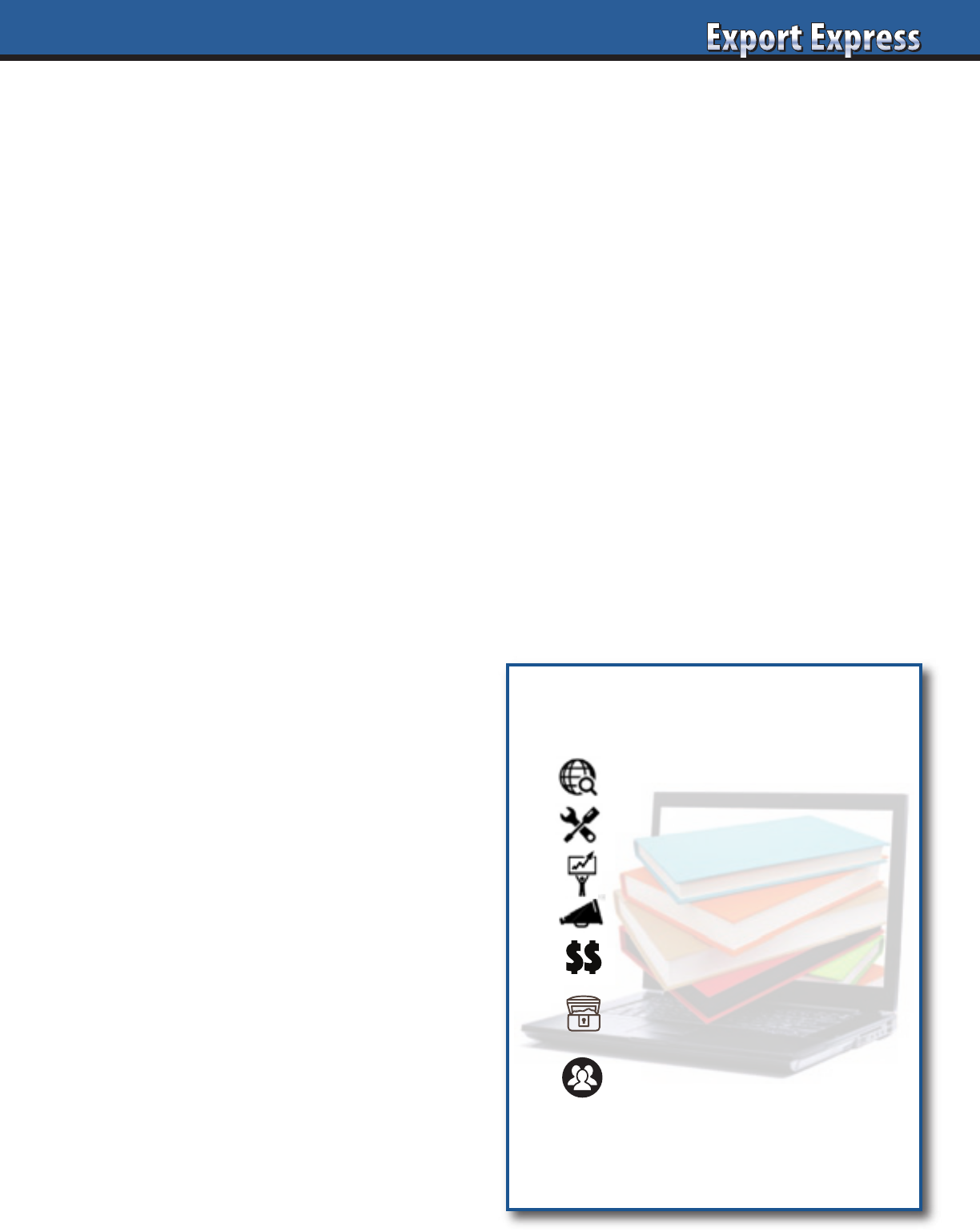
61
Slotting allowances, listing fees or as the Irish say “Hello”
money are all real estate rental fees charged in advance by
retailers for access to their limited shelf space. Many retailers
assign their buyers “budgets” for this type of incremental fee
income. Store owners seek to obtain maximum productivity
from each shelf facing and fixed entry fees are a tactic to gain
immediate income from new products without an established
sales history. At the end of the day, it’s a cost of doing
business. Our objective is to allocate as little money as
possible to listing fees to redirect our investments to
consumer awareness and trial generating activities.
Recapped below are Export Solutions’ Ten Tips on
minimizing listing fee payments.
1. Exclusivity
Some large retailers will waive listing fees in order to achieve
first in the market status with an exclusivity arrangement.
Normally, this extends for three to six months. Beware, you
may upset other customers who become “locked out” during
the exclusivity period.
2. Pay Fees Over One Year
This approach reduces your initial outlay and also increases
the likelihood that the retailer will keep your product on
the shelf for at least one year. This may also allow you to
structure the payment as a percent of case cost versus a
“lump sum” payment.
3. Free Goods
Our net cost of “Free Goods” may range from 30-50% of a
product’s retail price to the consumer. The retailer recoups
his listing fee when the product is sold. Some retailers are
hesitant to accept this option, as a slow moving brand may
force him to wait to receive his money.
4. Approach “Non-Slotting” Fee Retailers First
Every country includes retailers and channels that do not
demand slotting fees. Create a success story with these
customers first. Your track record may validate the larger
investment in paying the fees at a bigger account or success
may help you negotiate more favorable terms.
5. Create “All Inclusive” Annual Plan
Ultimately, the retailer has many “profit centers” to reach
their internal financial targets. Customers respect a solid,
year one plan, with investments in their other programs like
advertising, sampling, shelf rental and display. You may
secure your product listings as part of your annual agreement.
6. Negotiate Reductions – Multiple Items
My experience is that many retailers have published standard
prices for listing fees. However, net payment often depends
on your distributor’s clout. Big distributors, representing
multinational’s and a wide variety of brands know the
difference between what is requested and what is really paid
on high profile brand launches where the retailer needs the
new brand to be competitive. The most frequent “discount” is
receiving a reduced fee for multiple items: example, paying a
full listing fee on first two items and receiving authorization
for two extra items as part of a group listing.
7. Retailer Entertainment
Most countries still permit buyers to socialize with suppliers.
The cost of a few tickets to a high profile sporting event is far less
than most listing fees. A VIP plane trip to view your factory or
your category in a “resort” country is another way to gain access
to the shelves without writing a big check.
8. Higher Everyday Margin
Total category margin is a key assessment metric for most buyers.
Some may consider a lower listing fee, if your brand delivers a
margin higher than the category average.
9. Distributor Contribution
Some “hungry” distributors may cover or co-fund listing fees.
There are options to “case rate” fixed fees into the distributor
margin calculation. Ultimately, distributors benefit from increased
sales and margin contribution from a new product listing.
However, many are reluctant due to short term contracts. Most
maintain policies related to brand owners retaining 100 percent
responsibility for listing fees and consumer marketing activities.
10. Beg! Claim Poverty
Buyers are human and realists too. They may “bend” in their
demands if they like your brand and know that you represent
a small company. Long term distributors can request the
occasional “favor” from a friendly buyer. Most retailers have
programs to provide “low cost” chances to entrepreneurial
new or local suppliers.
Ten Tips: How to Minimize Listing Fee Payments
Create Your Own
Export Library
All Guides available free at
www.exportsolutions.com
in the Export Tips section.
Distributor Search Guide
Export Handbook
Selling to USA Handbook
Distributor Management Guide
Finance & Logistics
Export Treasure Chest
My Favorite Templates & Forms
People Power
Strong Teams Build Great Brands
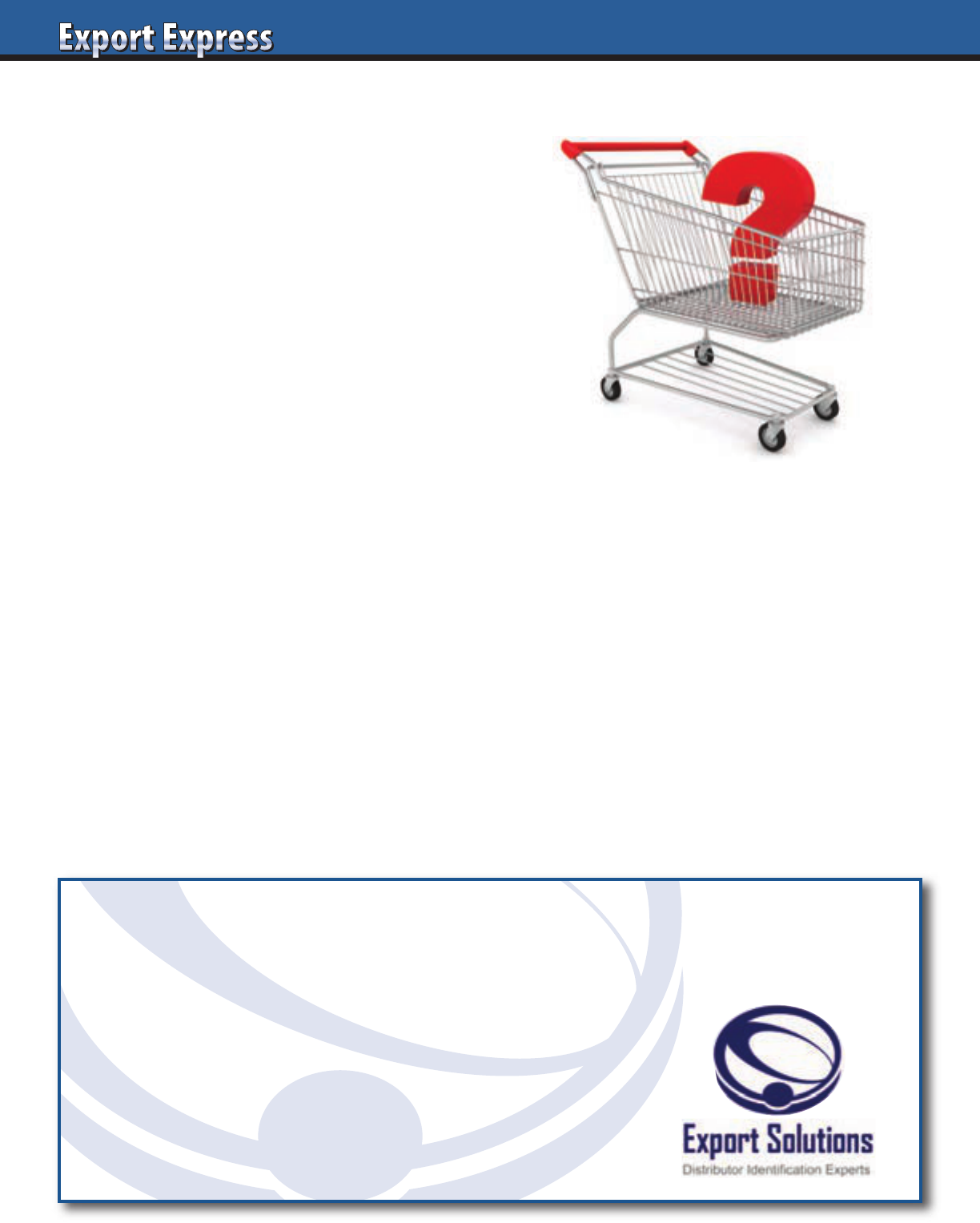
Pricing is a critical element of our marketing strategy.
The “calculation” defines all pricing inputs from a designated
port to the retail store shelves. Brand owners and distributors
invest significant energy developing a pricing model during
initial negotiations. My experience reveals that the calculation
tends to drift over time, fluctuating from the original guidelines.
This is natural, given changes in cost to serve inputs. However,
the calculation represents a fundamental ingredient to brand
success. Brand owners should review current models to ensure
an understanding of pricing for each country.
1. Do you possess your current pricing calculation from each market?
Many brand owners do not have current price calculations.
In some cases, distributors are reluctant to share them. The price
calculation, with suggested retail price, should be matched with
a retail price survey. This will allow you to compare (not control!)
the official model with “retail reality.”
2. What inputs are included in the price calculation? Any extra costs?
There are no standard price calculation models, even within
the same country. All distributors employ unique methodologies.
The key is to understand what is included and what inputs are not
included. You will also need to request definitions for some line
items. For example, financing in one model could be based upon
a Bill of Lading date in one scenario and delivery date in another.
3. What services are included in the Distributor Margin?
A financially healthy distributor is a good partner. Distributors
are entitled to fair compensation for their work on your brand.
It’s critical to understand what services are included in a
distributor margin. For example, in some scenarios, a distributor
offers a flat, “all inclusive” margin. In others, they may offer a
lower margin, but add an “admin” fee or profit allocation in
addition to the distributor margin. Are distributor margins the
same for all products in your portfolio? Does the distributor
margin change if you double or triple your sales?
4. Who pays for Trade Discounts and Promotions?
In many cases, the manufacturer covers 100% of these brand
specific investments. In other models, the costs are covered by
the distributor or split. The key is to understand who is
responsible and what is the planned investment. There is a big
difference in a distributor funding 1-2 small promotions per year
and funding monthly, high value, deep discount promotions.
5. How are price increases managed?
Price increases are a common activity in our business.
Manufacturers need to adjust prices to reflect fluctuations in raw
material costs, promotional support, and competitive activity.
Manufacturers should understand that some distributors act
as “single vendors” to a retailer. In some cases, distributors can
only implement pricing actions once per year. In other cases,
distributors may apply price increases (or decreases) against all
the brands in their portfolio.
6. How do you handle Currency Fluctuation?
This represents a critical point in certain countries and at times
emerges as an issue with worldwide implications. For example,
the euro/dollar exchange rate has fluctuated from .83 to 1.60,
settling around 1.12 as of today.
Six Questions Regarding your Distributor Pricing Calculation
62
Looking for Good Distributors?
Export Solutions’ database covers
9,200 distributors in 96 countries.
www.exportsolutions.com
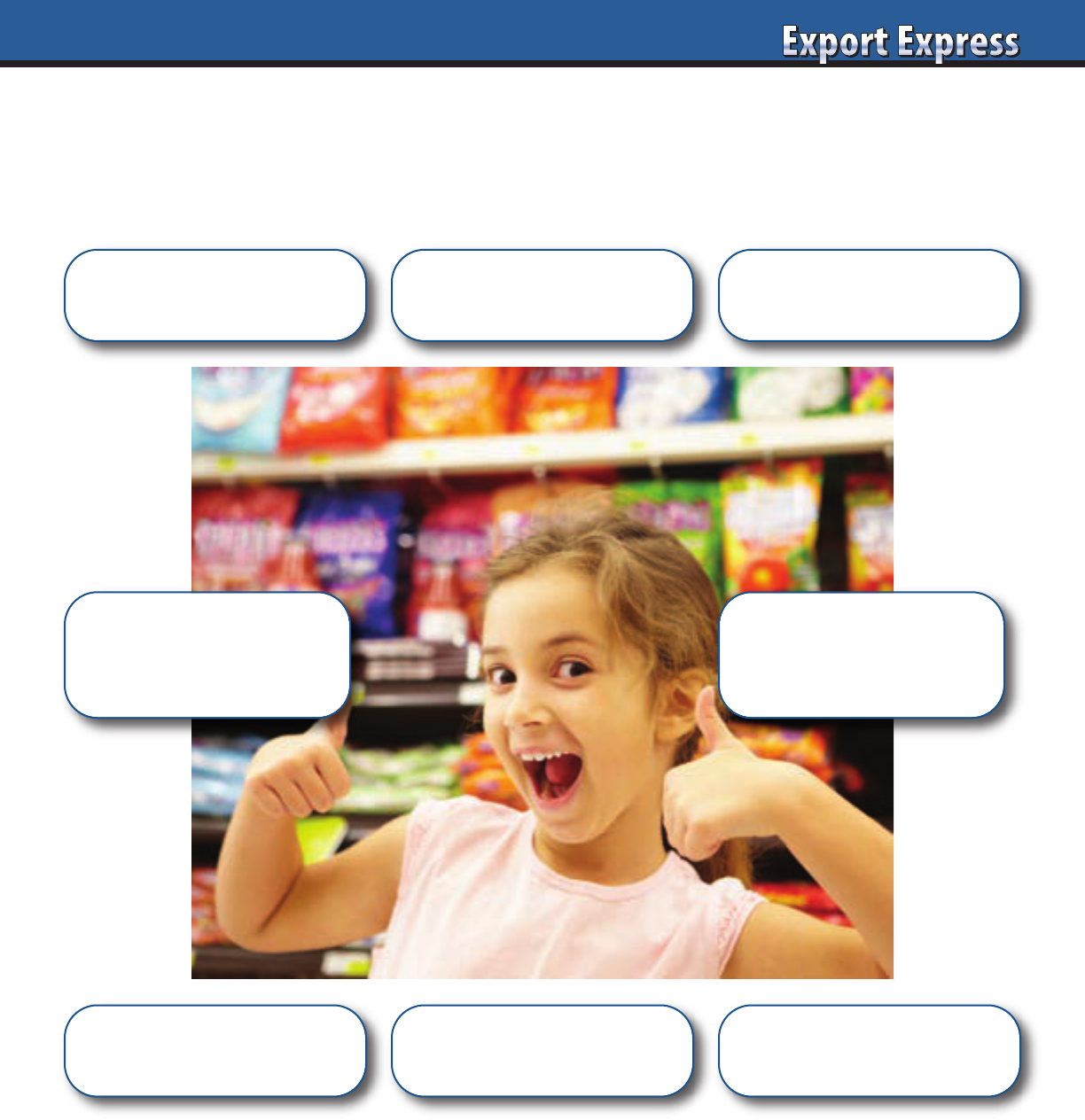
63
We’ve Got You Covered!
Distributor Database Coverage
Confectionery & Snack:
2,713 Distributors
Ambient Beverage:
1,691 Distributors
Gourmet & Ethnic Foods
3,276 Distributors
USA Importer/Distributor
:
598 Distributors
Middle East
937 Distributors
12 Countries
Asia
2,030 Distributors
17 Countries
Latin America
1,574 Distributors
Europe
3,139 Distributors
9,200 distributors – 96 Countries
Subscribe now at www.exportsolutions.com
“Spend time Selling to Distributors versus Searching for Distributors”
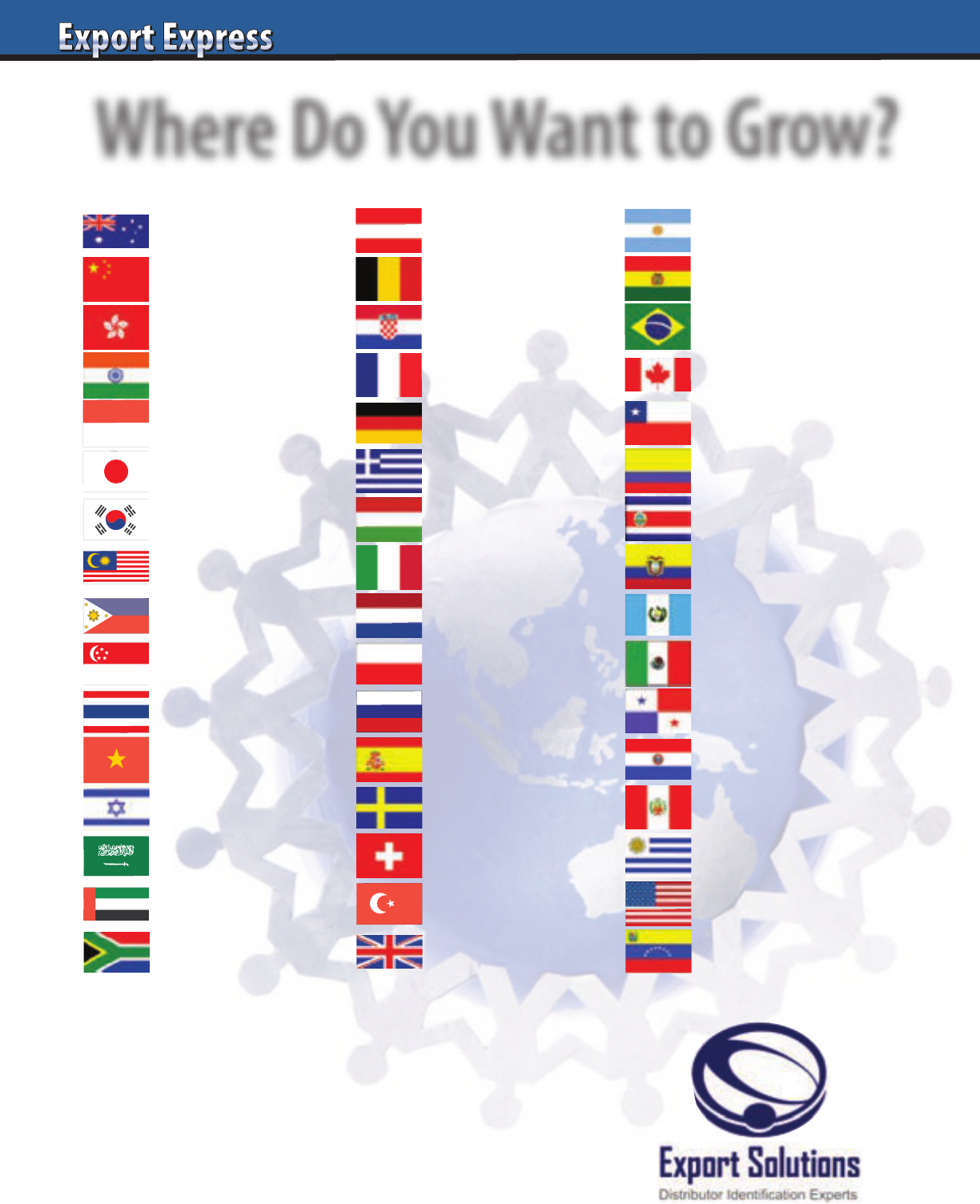
Australia – 274 Distributors
China – 160 Distributors
Hong Kong – 177 Distributors
India – 109 Distributors
Indonesia – 78 Distributors
Japan – 176 Distributors
Korea – 146 Distributors
Malaysia – 128 Distributors
Philippines – 109 Distributors
Singapore – 163 Distributors
Thailand – 94 Distributors
Vietnam – 49 Distributors
Israel – 61 Distributors
Saudi Arabia – 115 Distributors
U.A.E. – 195 Distributors
South Africa – 106 Distributors
Plus 14 more countries
Austria – 68 Distributors
Belgium – 85 Distributors
Croatia – 78 Distributors
France – 125 Distributors
Germany – 188 Distributors
Greece – 90 Distributors
Hungary – 68 Distributors
Italy – 105 Distributors
Netherlands – 155 Distributors
Poland – 90 Distributors
Russia – 108 Distributors
Spain – 157 Distributors
Sweden – 103 Distributors
Switzerland – 100 Distributors
Turkey – 82 Distributors
U.K. – 274 Distributors
Plus 19 more countries
Argentina – 61 Distributors
Bolivia – 52 Distributors
Brazil – 135 Distributors
Canada – 205 Distributors
Chile – 92 Distributors
Colombia – 82 Distributors
Costa Rica – 73 Distributors
Ecuador – 55 Distributors
Guatemala – 61 Distributors
Mexico – 193 Distributors
Panama – 63 Distributors
Paraguay – 57 Distributors
Peru – 82 Distributors
Uruguay – 52 Distributors
USA – 598 Distributors
Venezuela – 38 Distributors
Plus 14 more countries
64
Where Do You Want to Grow?
Asia/Africa/Middle East
Europe Americas
Use Export Solutions Database
to fill in the Gaps in your
Export Coverage Map

